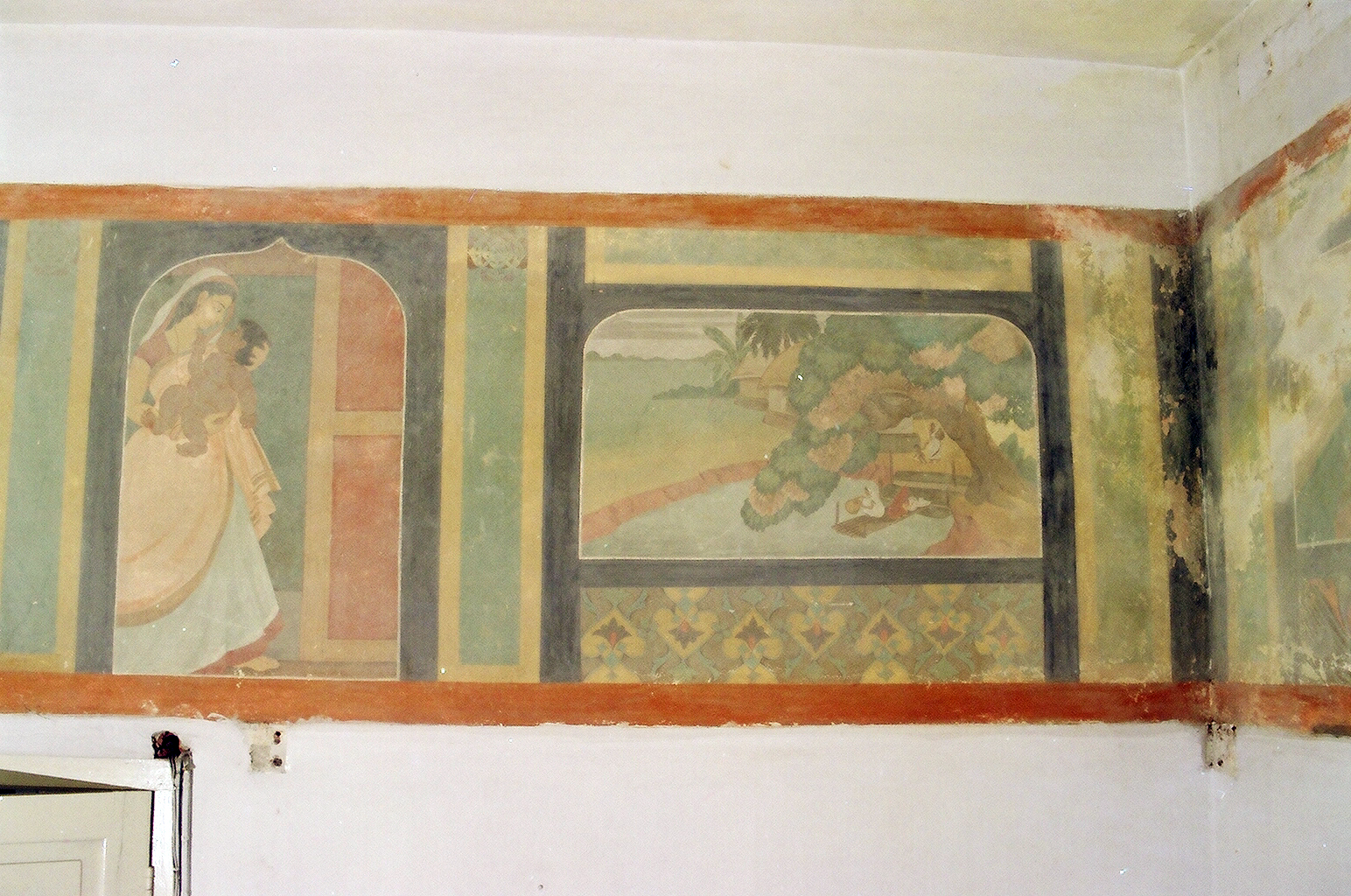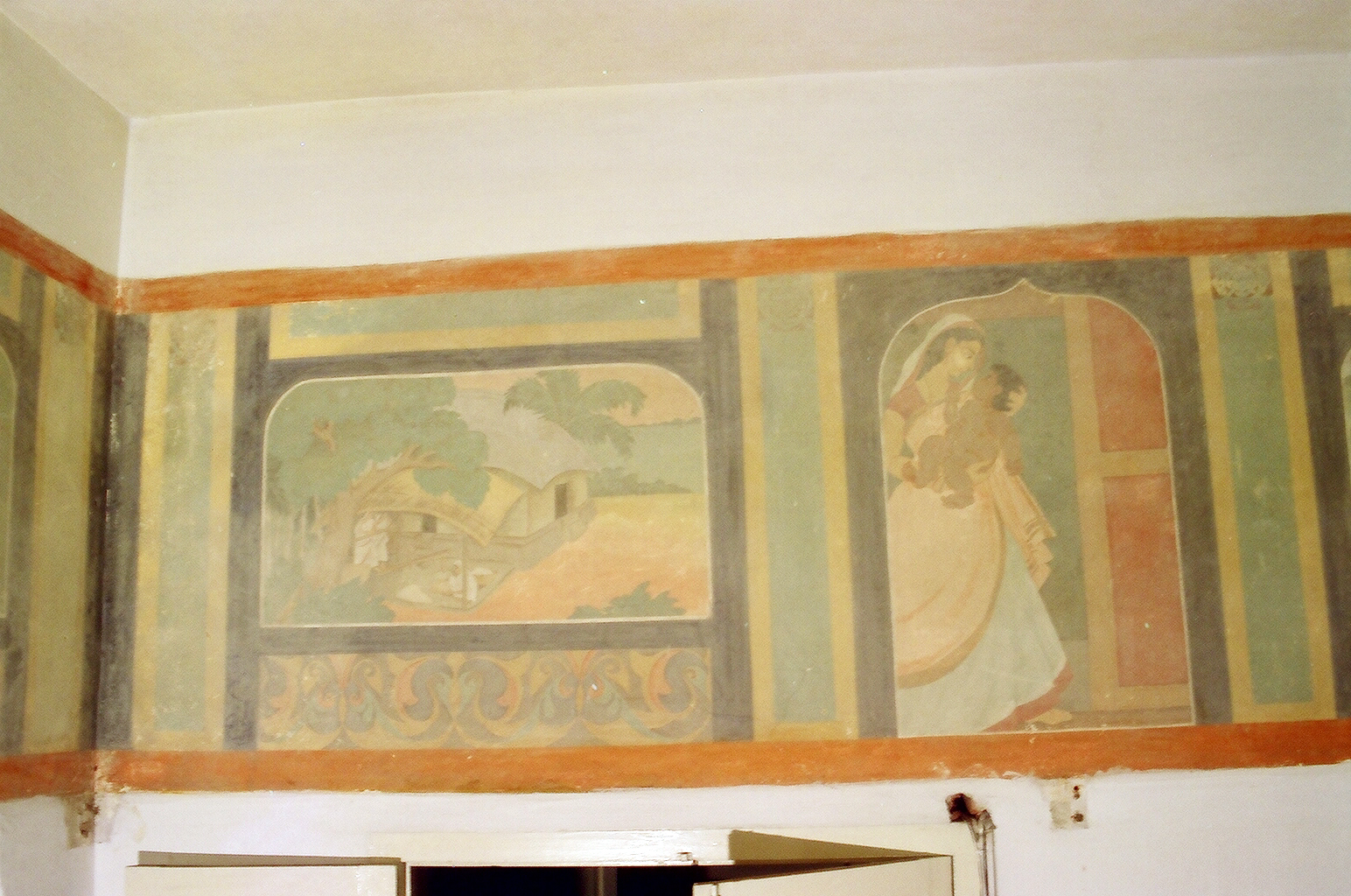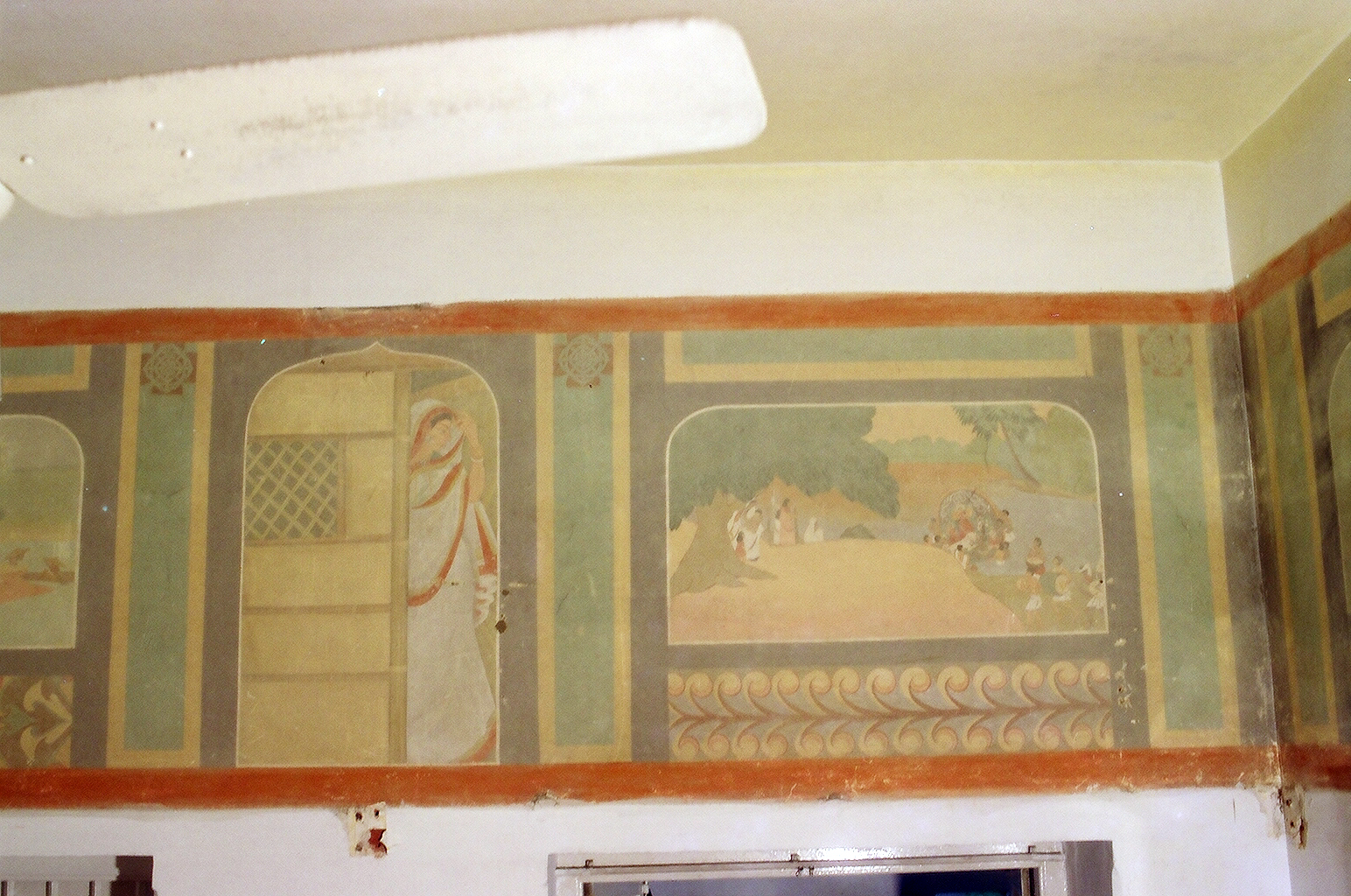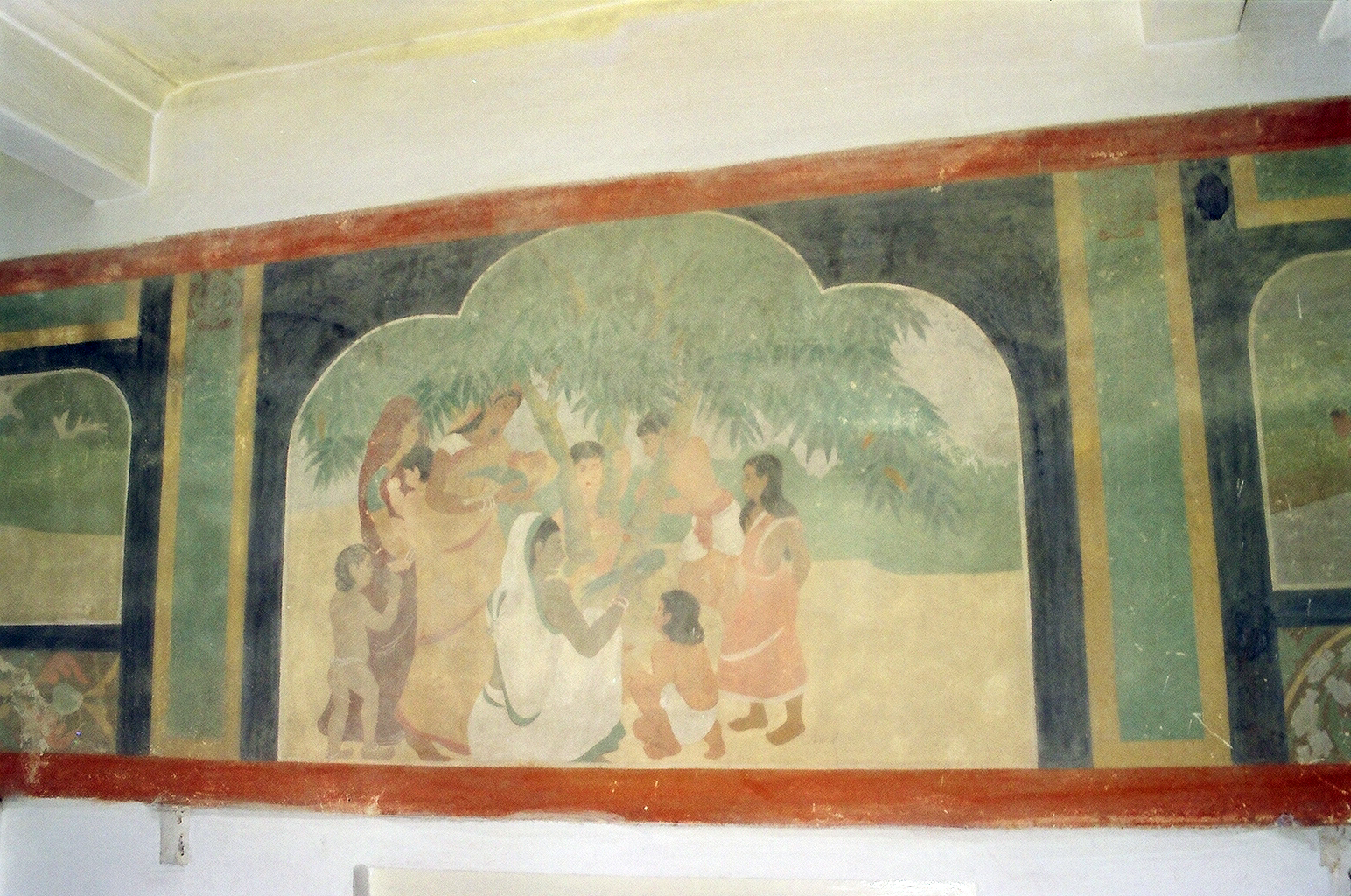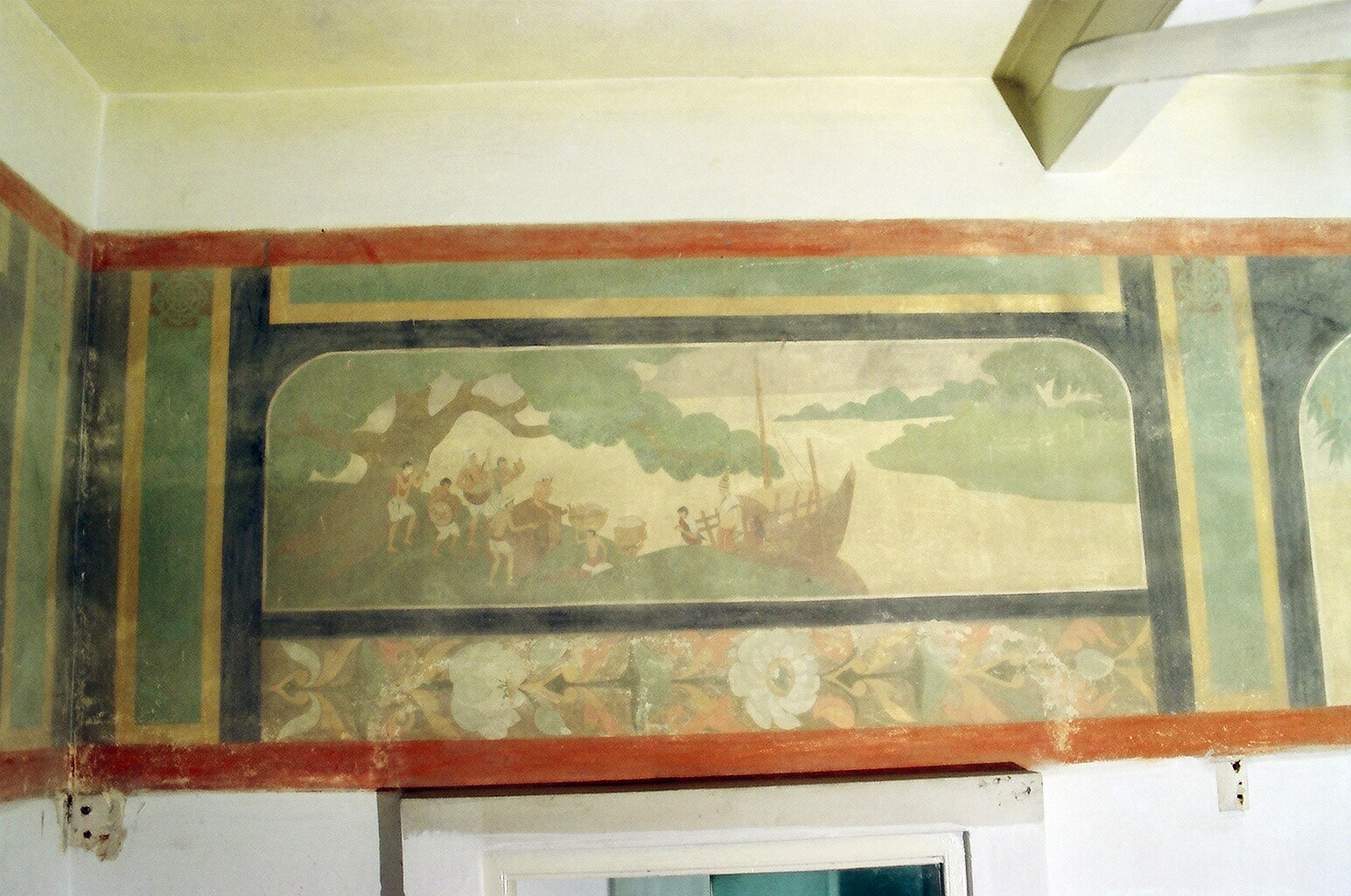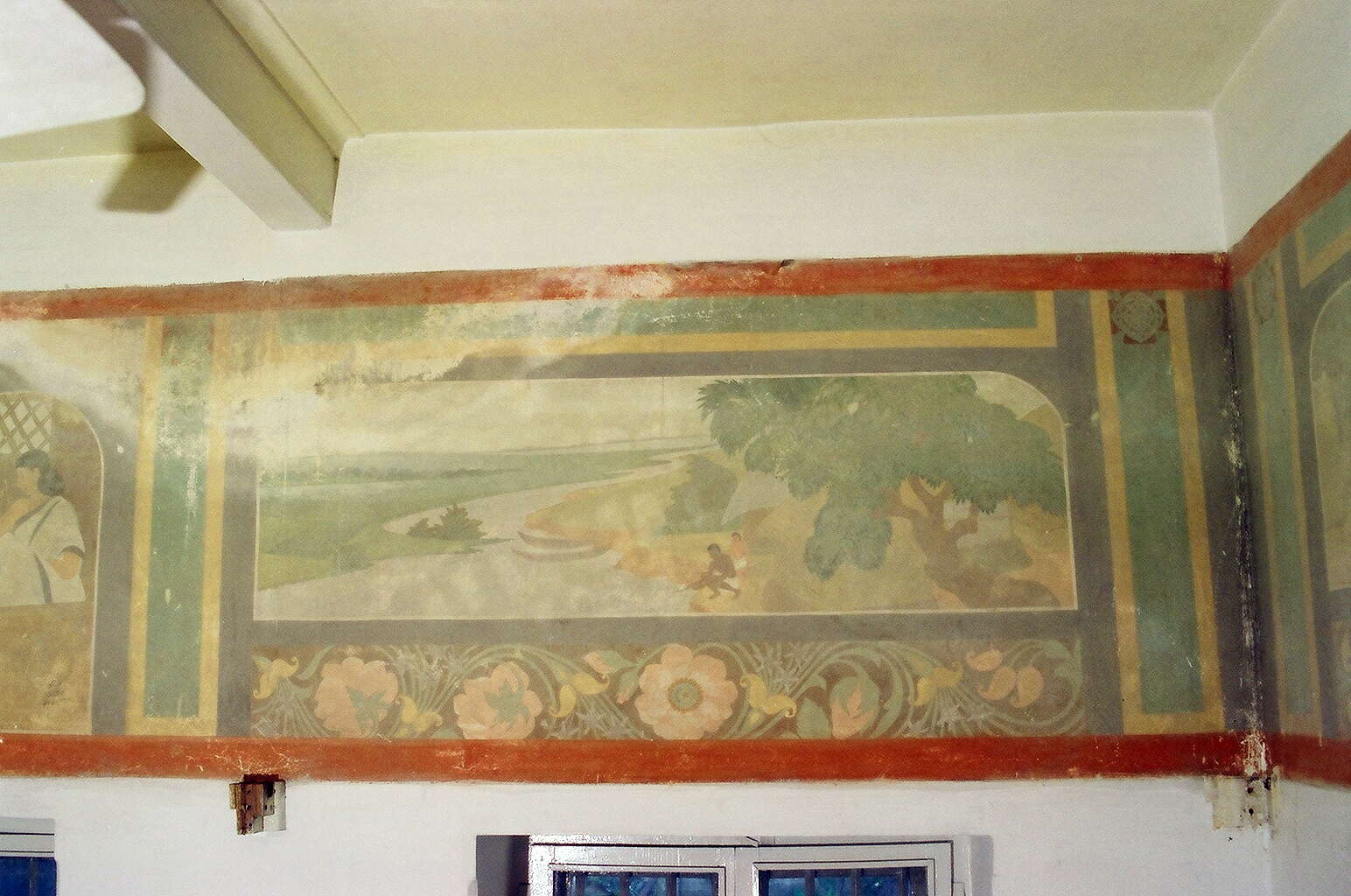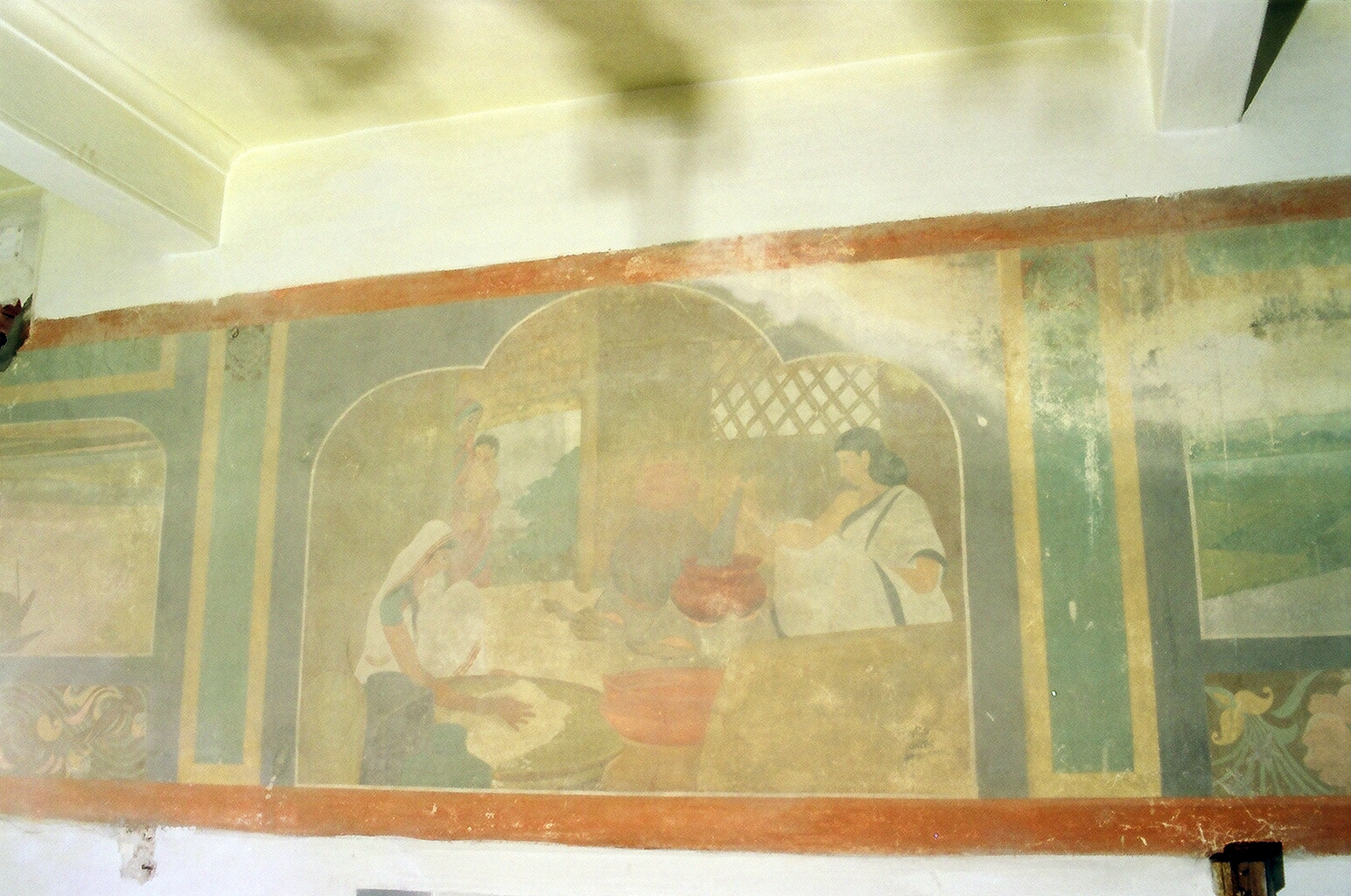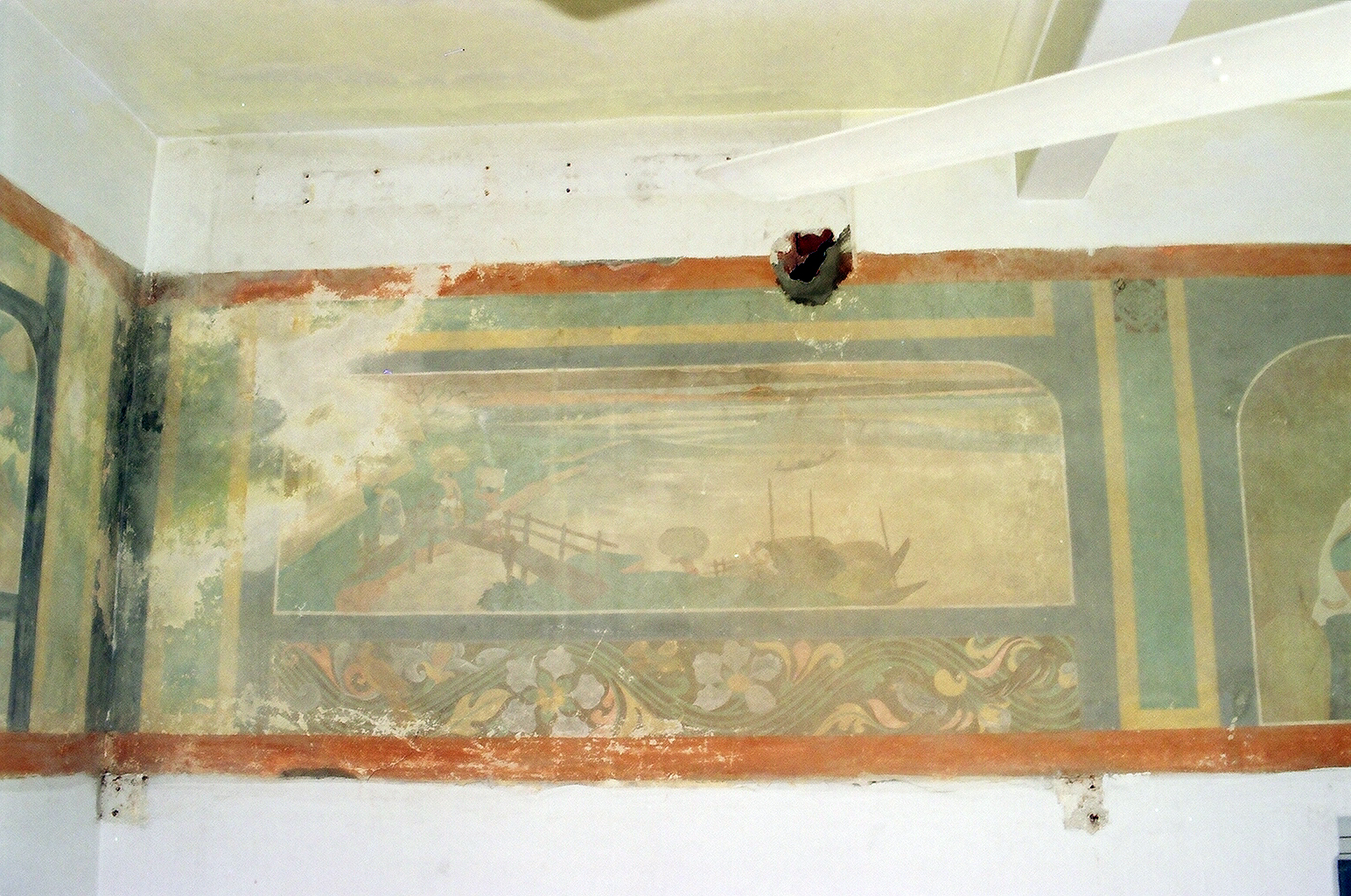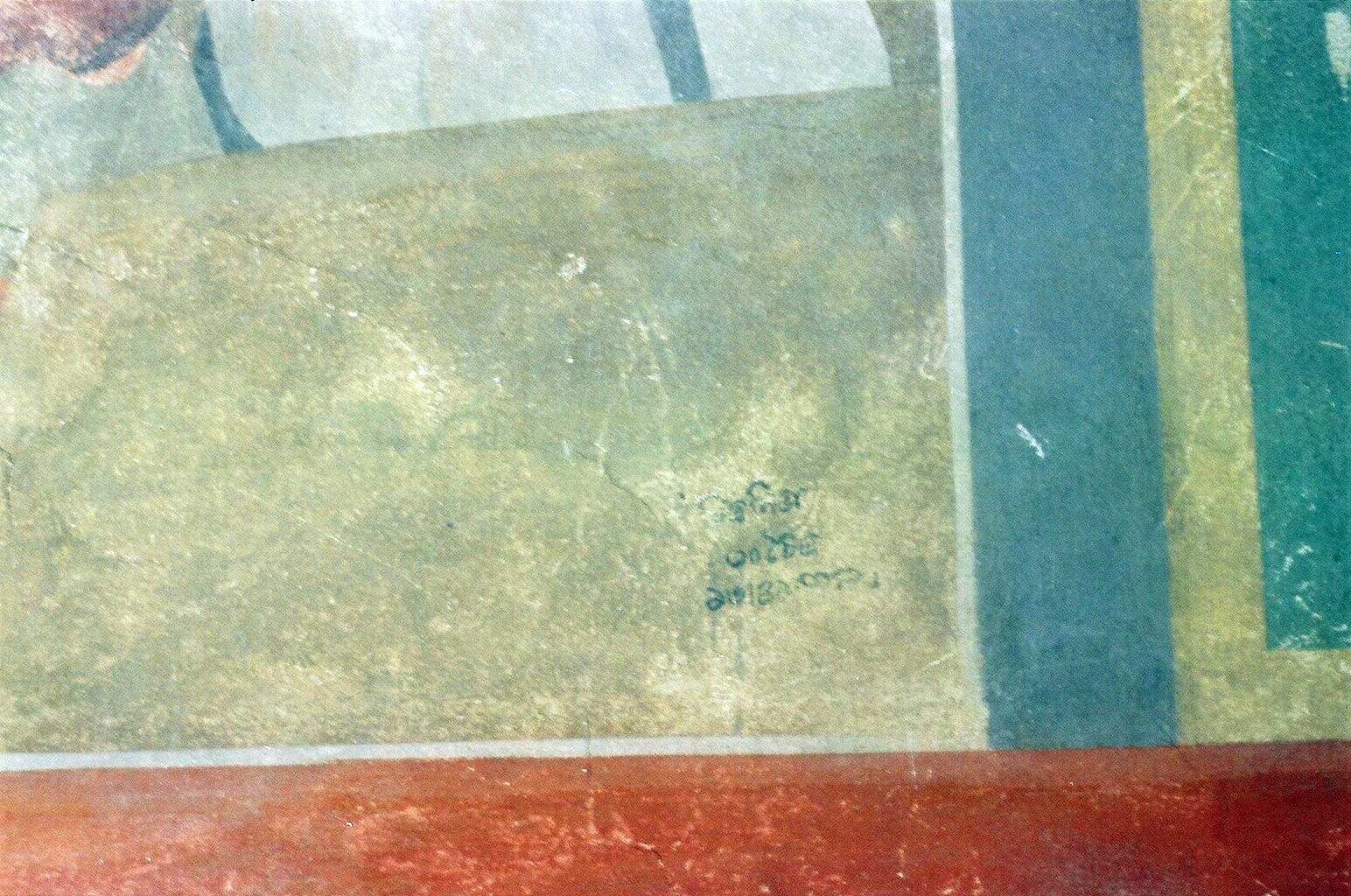Author: Moushumi Bhowmik
Savitri Govind, who later became the famous Rabindrasangit singer Savitri Krishnan, was 18 when Arnold Bake recorded her in Santiniketan in 1931. She had only just arrived from the Adyar Theosophical school near Madras (Chennai), after Rabindranath had heard her sing there and recognised what a talent she was. Rabindranath heard her sing Muthuswamy Dikshitar’s ‘Meenakshi pe mudam’ and from her song was born the Rabindrasangit ‘Basanti he bhubanamohini’, which Savitri herself recorded.
Years later, in this video recorded in Bangalore by Anjana Dey, who is related to Nandalal Bose through her mother and therefore has strong connections with Santiniketan, Savitri remembered the day Rabindranath had called her over and given her the words of his song to sing and how Dinendranath had tears in his eyes when he listened to the song.
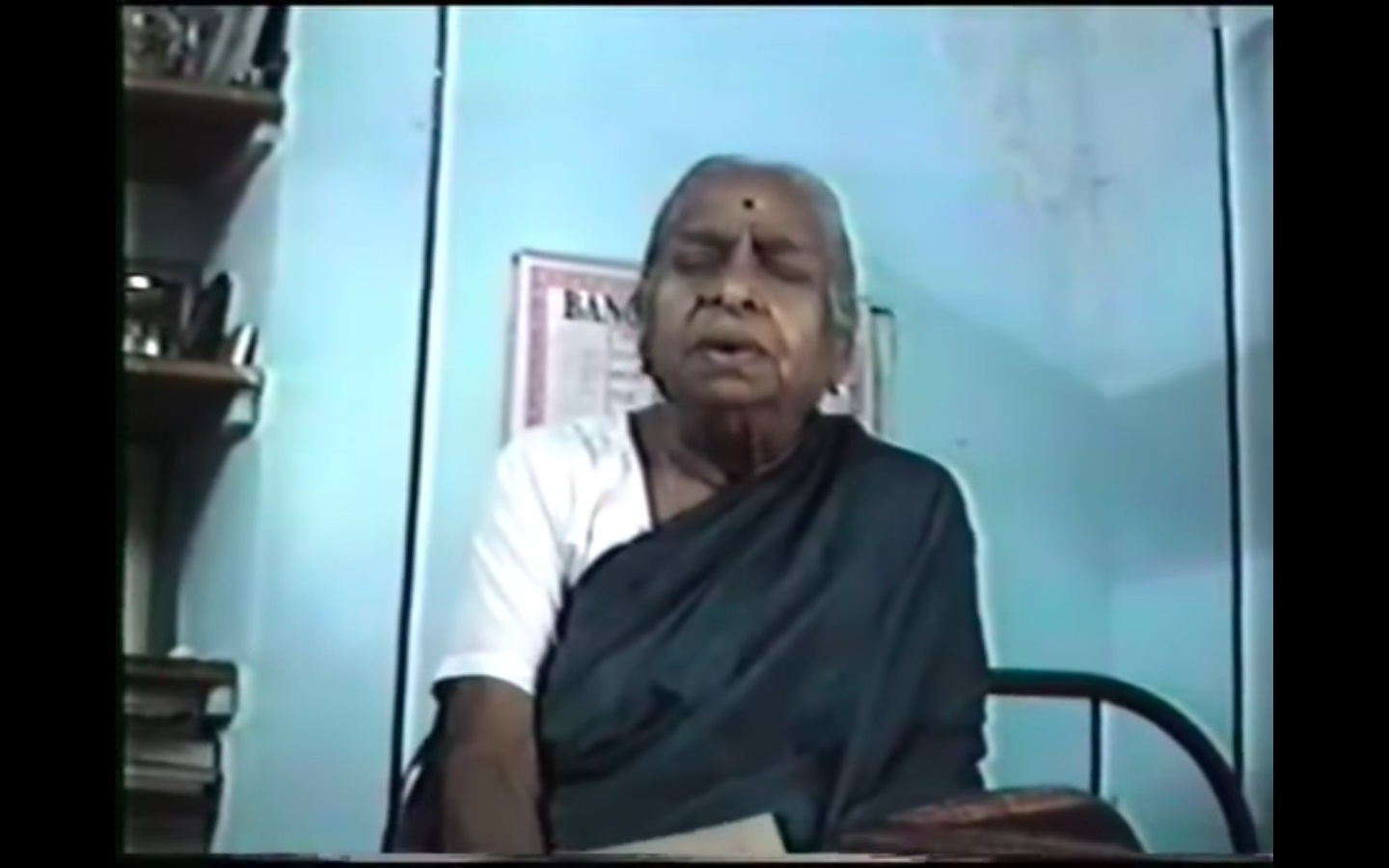
Savitri Krishnan singing Basanti he bhubanamohini in her home in Bangalore in 1992. (Still from video by Anjana Dey)
I tried hard to contact some family of Savitri Krishnan’s but failed. When I found this video on youtube, I contacted Anjana Dey, who lives in Canada, and she was very warm in her response. I asked her if there was more material with her which she would be willing to share with me and also if she knew the whereabouts of Savitri’s family. She said there wasn’t much more to tell except that Savitri Krishnan nursed a wound about never being properly recorded.
Perhaps she did not know that in the archives of the Berlin Phonogramm-Archiv and the British Library her voice as a very young girl lay preserved, never to age. How would she feel if she heard her voice coming to her from her past? What would she think of the wax cylinder recordings? Would she say, oh, but that is so noisy! What would she remember of that day or those days when Arnold Bake had recorded her? Bake recorded several of her songs, which can be heard on the British Library Sound Archives website – Mira bhajans and Kabir and Rabindrasangit and a song of Harindranath Chattopadhyay. Bake also took photos of her.
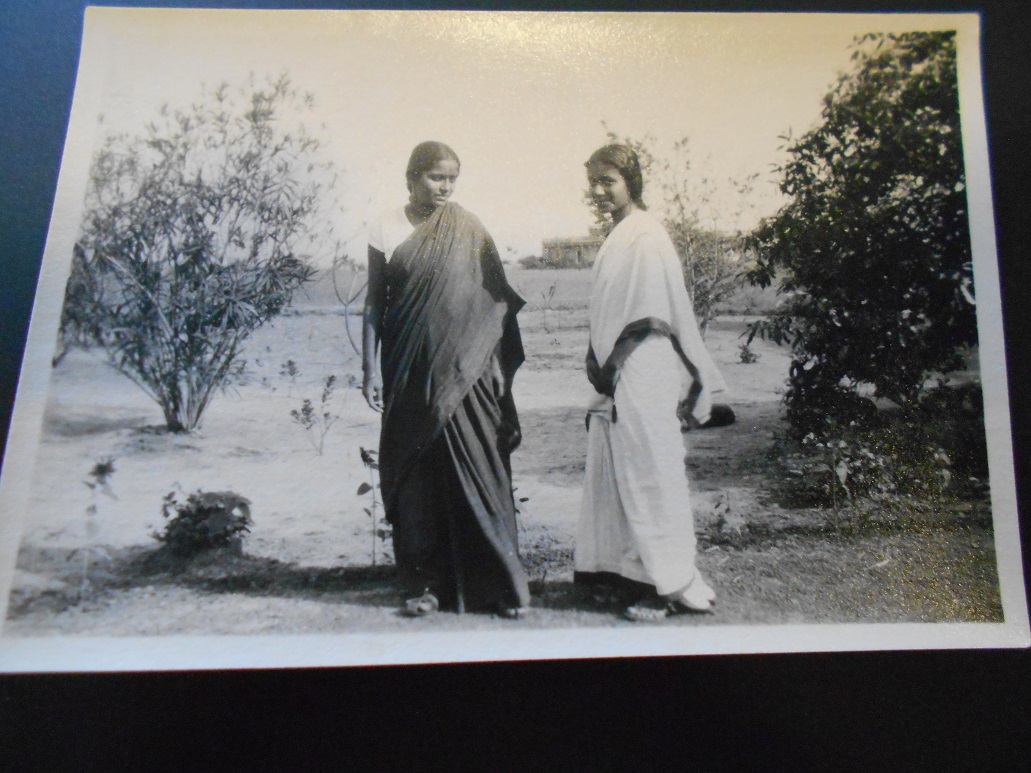
Savitri and friend, Santiniketan. Source: Special Collections, Leiden University Library. I took this photo while working in the library in 2015.
‘The South Indian girl, Savitri, with a friend. S. wears the dark Sari. She’s an enormously gifted and funny child. A while ago, I don’t know if I wrote about it already, she danced with that red shawl not quite unlike a Hungarian folk dancer. We laughed like we hadn’t in months,’ Bake wrote explaining the photo he sent to mother with his letter of 29 April 1931.
She seems to have retained this spirit all through her life. I found a blog note on her and a response I found particularly interesting: ‘I knew her well in Nova Scotia, we started a school for dropouts and exceptional students. Everyone called her Ama. She was a calming influence & encouraged nutrition with an endless supply of fresh fruit for those who sat with her surrounded by her musical instruments. Sage & yet daring. I played tennis with her when she was over 65 & she was always up for adventure. I drove her around in my old car, happily. She loved to sing and laugh.’ (Bruce Maclellan, 9 May 2019)
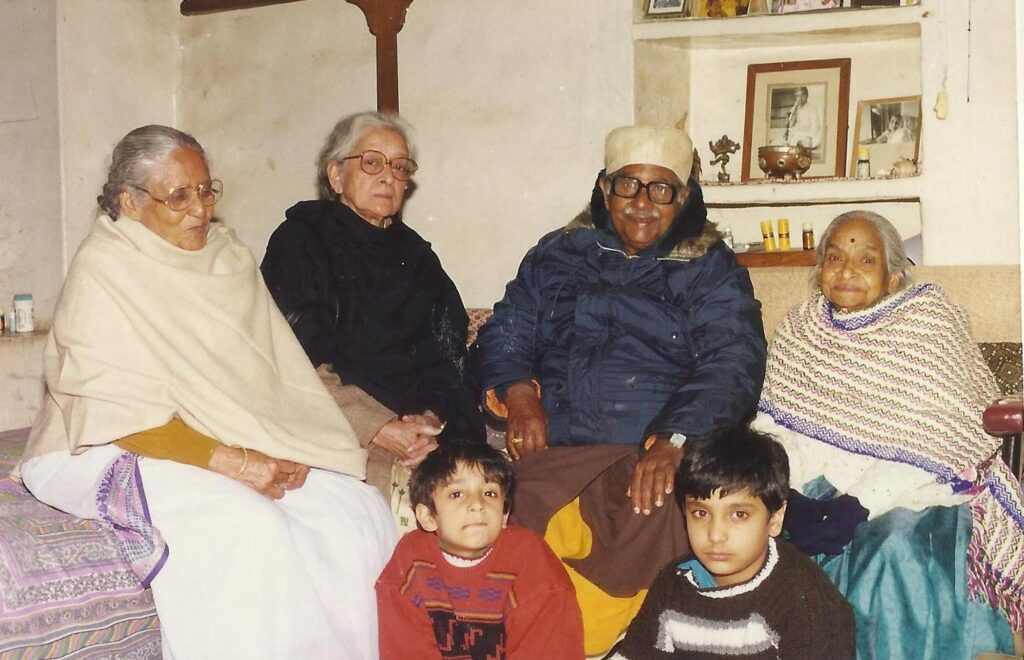
Santiniketan, 1998. Savitri Govind, Krishnan now, comes hack to the asram. From left to right, Ila Ghose, Suchitra Mitra, Santidev Ghose and Savitri. Not sure about the identity of the children. Photo courtesy: Samik Ghosh.
Arnold Bake was fascinated by the way she sang the ‘Meenakshi’ and he wrote to his mother, ‘this one Sanskrit song that Savitri sung, I would not be able to do that even after years.’ Listening with others to Savitri’s songs on Arnold Bake’s cylinders, including with young scholars of music and practitioners such as Budhaditya Bhattacharyya what was striking to all of us was that, if we didn’t know who the singer was, Savitri’s Mira and Kabir bhajans could be mistaken for a Bengali’s. In my thesis I muse on this and speculate on the reasons for this.
Budhaditya sent these voice messages to me on Whatsapp in May 2021. Around this time, Budhaditya, another PhD scholar at the University of Amsterdam, Mriganka Mukhopadhyay and I were talking among ourselves about Adyar and the connection of the Theosophical Society with Visva Bharati, Tagore’s Jana Gana Mana (which was to become the Indian national anthem) as it was notated and preserved by the Irish Theosophist and musician Margaret Cousins in 1919 and such matters. This was helping me very much to sharpen my understanding of the songs of Savitri Govind that Bake had recorded.
Carnatic vocalist and ghatam player Sumana Chadrasekhar responded on more or less these terms when she listened to Bake’s recordings of Savitri. She recorded herself and sent me her recordings from Bangalore. I am very grateful to Sumana for her perspective.
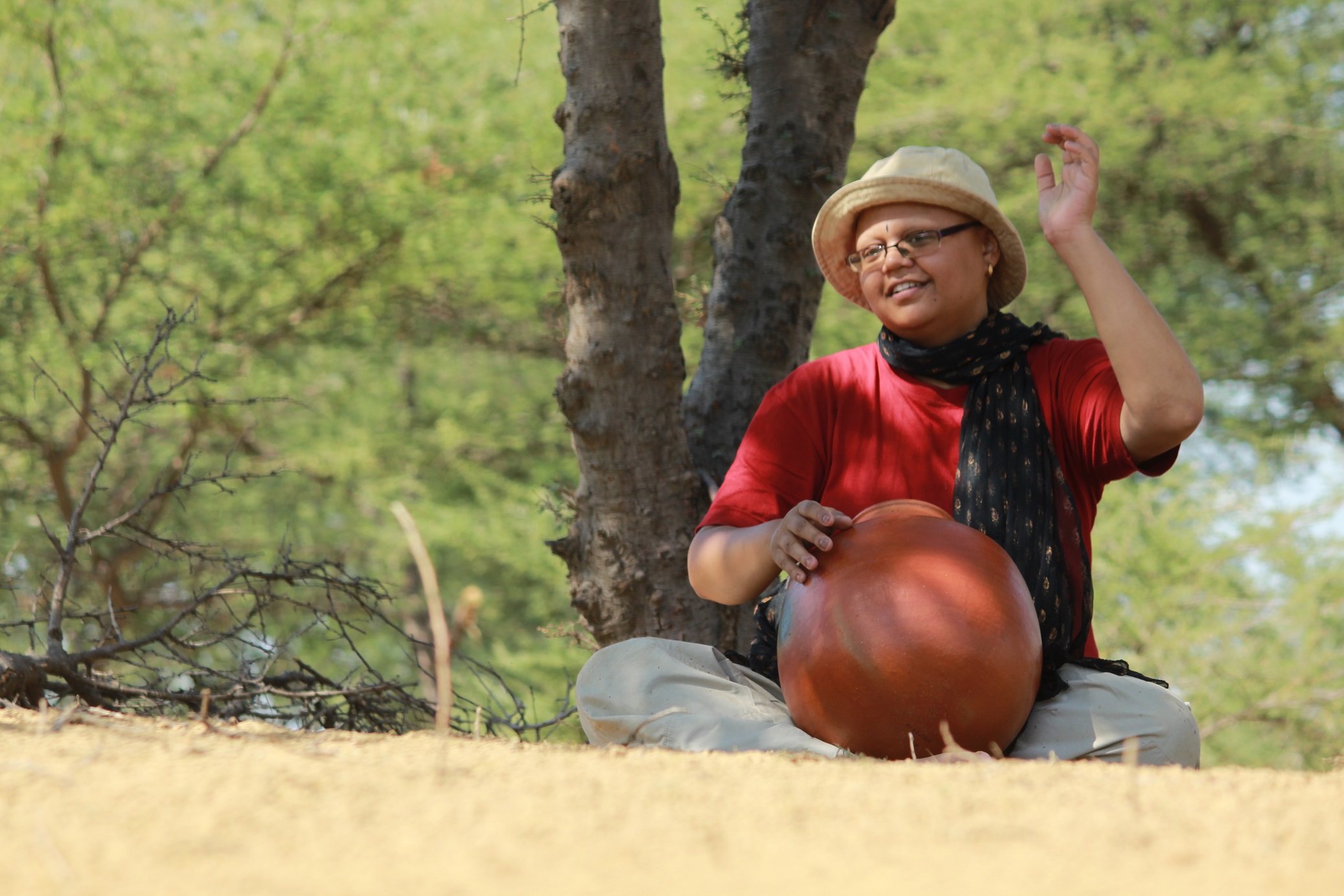
Sumana Chandrashekar also sent me this photograph.
Sumana explains the meaning of Muthuswamy Dikshitar’s Meenakshi
Sumana explains the particularity of Savitri’s style and the absence of gamaka
Sumana sings Meenakshi me mudam dehi
How Tagore uses the structure of Purvi Kalyani and liberties he takes
The Berlin Phonogramm-Archiv catalogue describes Ranjan Shaha as Bettelnder Berufssänger from Kasba in Birbhum, which suggests an itinerant singer who lives by madhukori or collecting alms. Ranjan Shaha was a honey-gatherer. Arnold Bake recorded him in Santiniketan on two cylinders (Bake India II/81 and 82) in November 1931, the exact date is not known. He sang two songs, ‘Amar nai parer kori’ and ‘Michhe keno bhabona re mon’, playing the bowed sarinda. Both songs are about making the spiritual journey through life to reach the other shore—the first alluding to the Radha and Krishna story, where Krishna is the rower of the boat on the river of life and Radha is the one making the crossing. The second is a contemplation on the mind and mindless living.
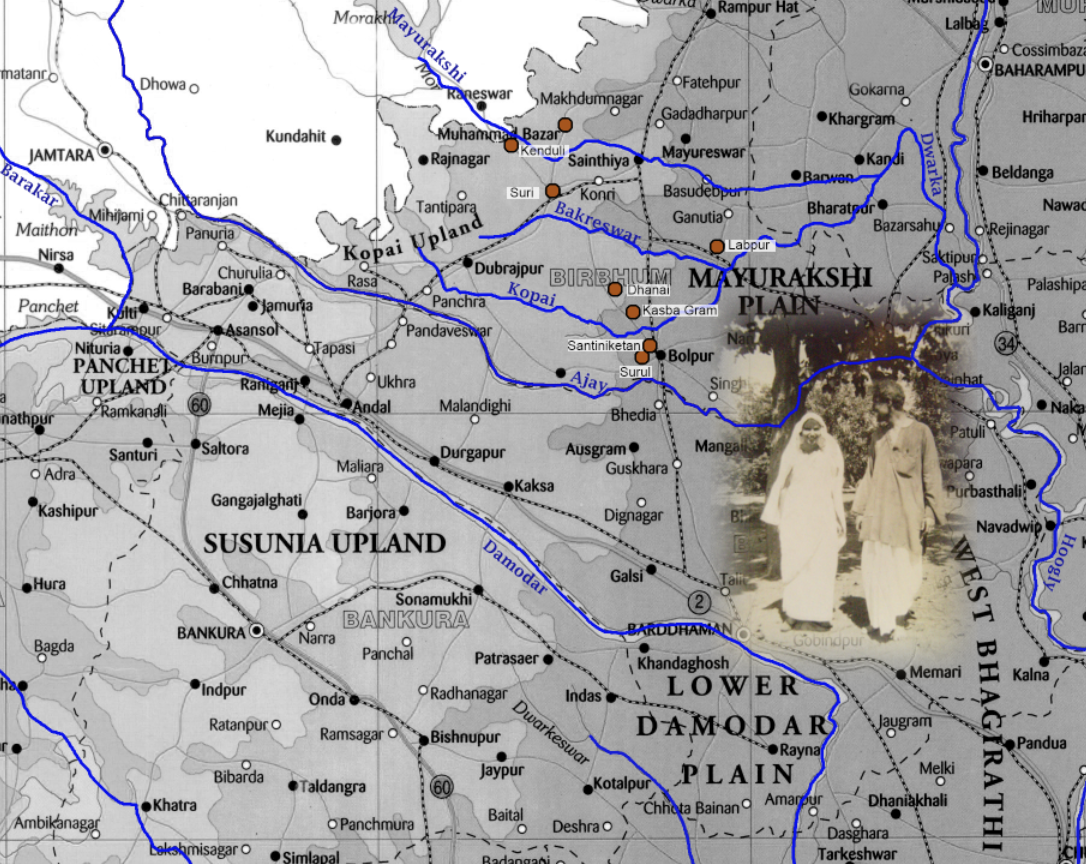
Map showing Kasba, Dhanai, Santiniketan, Suri and Kenduli. Designed by Purba Rudra.
On 15-16 June 2018, I went with my friend, field recordist Soumya Chakravarti, also a teacher in a sense, to Kasba village in Bibhum, about eight kilometres north of Santiniketan, in search of Ranjan Shaha. Soumyada had an acquaintance in the village, Anisur, who worked as a gardener. He became our guide on this journey.
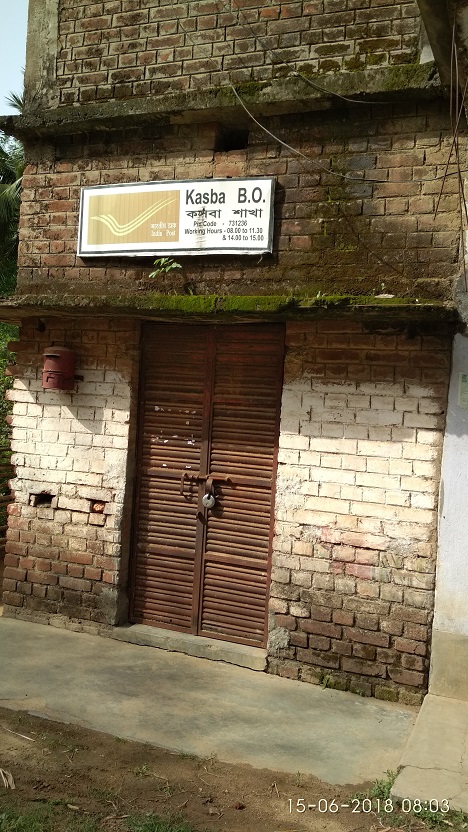
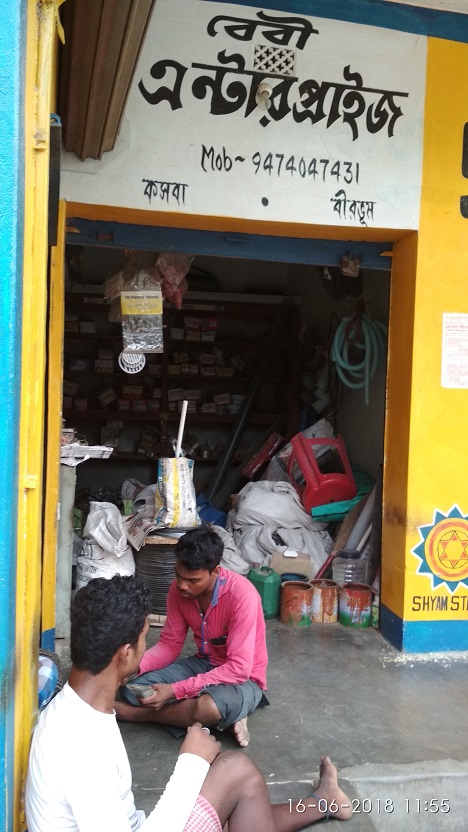
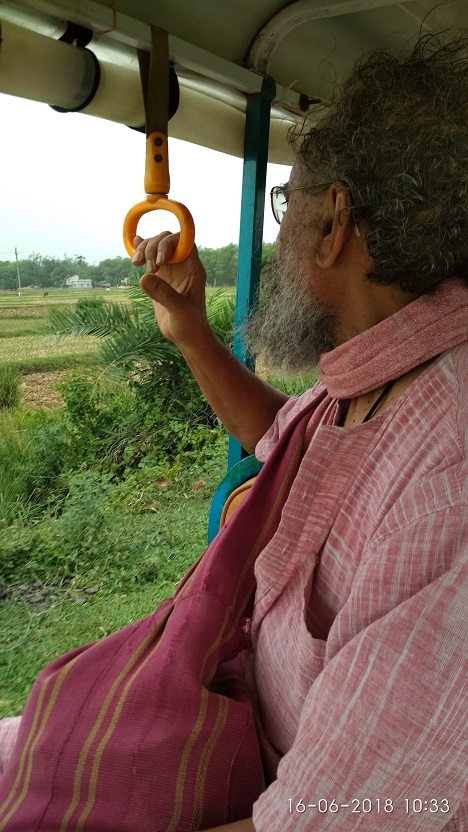
Soumyada and I went by a ‘toto’, a battery-operated three-wheeler, to Kasba. Photos, mine.
There were no trails leading from Ranjan Shaha’s voice to any certain location—no family to be found, no lineage to link him with. However, there was room for plenty of speculation. I made recordings in Kasba, of various people, mostly in conversation. They suggested we go to all sorts of places; everyone had an opinion.
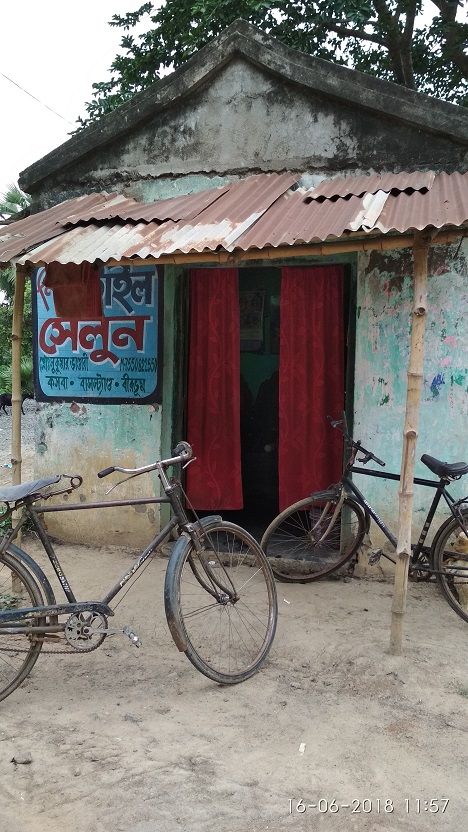
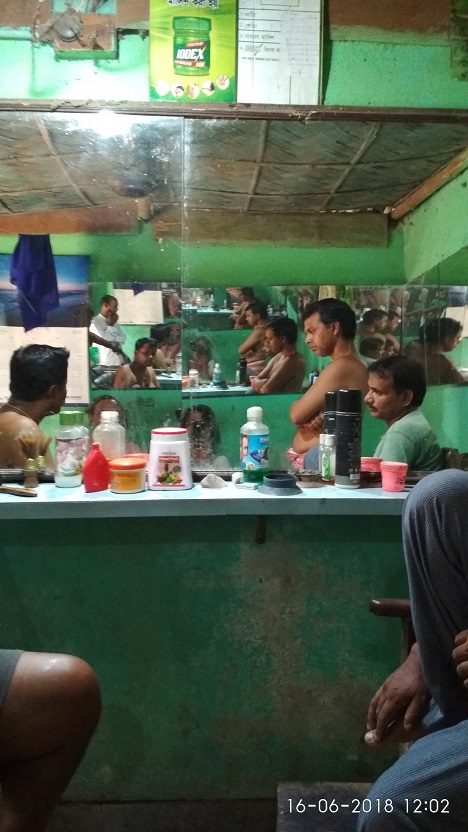
Hairdresser, Kasba. Photo, mine.
Man at hairdresser’s talks about the history of Kasba. The old zamindars who were Sahas, but they lost their fortune and dispersed. They settled near Mama-Bhagne Pahar. Take a bus, get off at such and such place, ask for so an so. Apparently Rabindranath had once come on foot to Kasba. Hard to know how far real and how much imagined these stories were. But the man was a great storyteller. Recorded on my Zoom H2N. 16 June 2018.
On the first day of our Kasba trip, what seemed most doable was to visit Dhanai, which everyone was suggesting. Dhanai was another eight kilometres north, and apparently it was a village of musicians. So, we followed that lead into Dhanai, where we were surrounded by curious listeners as we played Ranjan Shaha’s songs from my laptop. There was more speculation, but nothing concrete. This village could be Ranjan Shaha’s home too. They talked about musicians in their families, fakirs who roamed around, played the sarinda and sang. There was one prominent singer in their village, they said, Akhtar Shah, who could have told us more, but unfortunately he was away on work. Perhaps we could come back another day? Then Anisur, the gardener who grows little things in a plot which Soumyada shares with a friend, proposed a plan. No point waiting for too long. We could come back to Kasba the very next day and Akhtar Shah too could come from Dhanai to meet us. That way we could also have lunch with Anisur’s family, since the next day was the joyous Eid after the fast of Ramzan or Ramadan.
I give the recorder to Soumyada and he conducts the conversation in Dhanai, while I play Ranjan Shaha’s songs on my laptop, simultaneously making a video recording of Soumyada’s recording, with my phone. 15 June 2018.
As planned, the next day we went back to Kasba and kobiyal (singer of kobigaan or ‘a verse-duelling/song theatre genre’) Akhtar Shah of Dhanai came to meet us. He talked about generations of kobigaan singers in his family and also the use of the sarinda as an accompanying instrument. We realised that Anisur was in fact a murid or disciple of Akhtar Shah.
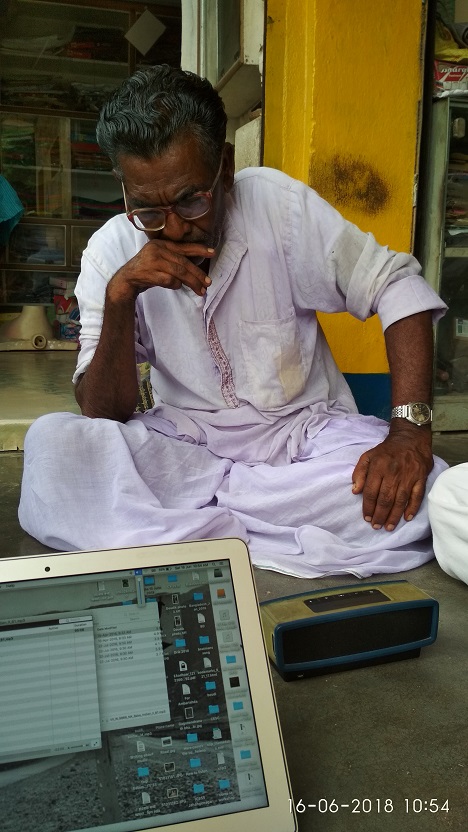
Akhtar Shah listens to Ranjan Shaha. Photo by me.
Akhtar Shah of Dhanai listens, then he starts to talk. 16 June 2018.
We do not know the exact circumstances of Bake’s recording of Ranjan Shaha’s songs; perhaps the singer was passing by his house, perhaps he was a regular in Santiniketan, came to sing like the bee and gathered honey from the asramiks; then flew back to his hive. While such songs certainly coloured the soundscape of Santiniketan, they were more like the breeze that blows over a place but does not stay. The occasional song collector keeps a record of this passing, that is all. Years later, we find traces of that voice in an archive thousands of miles away from the village.
I have tried listening to Ranjan Shaha not only in the field, but I engaged in a kind of ‘collaborative listening’ with the British composer Oliver Weeks and I also sent the recordings to Nirmalendu Mitra Thakur of Mainadal to know what he thought of the song ‘Amar nai parer kori’, especially since Ranjan Shaha sings a story about Radha and Krishna’s leela just as the kirtaniyas of Mainadal did. Within the space of an archive, multiple times and unconnected objects rest side by side without the parts knowing that they actually make one whole story. In my work, I have tried to get a dialogue going between those parts.
Nirmalendu Mitra Thakur and I had a conversation over the telephone on 19 January 2021. The starting point of the discussion was Ranjan Shaha’s song ‘Amar nai paarer kori, dayamoy Hori, paar koro nijo gune’. I asked Nirmalda to tell me the story of Hori or Krishna taking Radha across the river, to see whether what I had written down of Ranjan Shaha’s song—what I thought I heard in that recording, under its layers of noise—made any sense or not. Nirmalda says, ‘Sri Krishna, the boatman, is taking Radharani and her sakhis across the river. The cowherd maidens led by Sri Radhika come to the shore and ask Krishna to take them across. Radha says she has no money. There is some haggling—he asks for sholo ana [sixteen anas make a whole taka], he asks for all. She says I don’t have sholo ana to give, I can at best give half, I can give aat ana.’ Nirmalda shies to tell me details of this story with its erotic symbolism. There are implied meanings, they are talking about both deho (body) and mon (mind), after all. Radha and Krishna are playing with words, he is propositioning to her and she and the girls and the old woman escorting them are dodging his advances with clever retorts. Nirmalda says some, hides some, sings some, and laughs some. I cannot ask very directly either. There is a curtain between us in this exchange, and the listener will hear it fluttering in the breeze in this conversation. ‘Well, I mean, is there anything about bastra or clothes in this story? I thought I heard the word in that other song,’ I ask. ‘Indeed there is,’ Nirmalda says. ‘Sri Krishna says your blue sari is inviting the rain clouds, if the rain comes our boat will sink. You need to take it off. Radharani says, what about your blue body? Can you shed that too?’ Nirmalda says, ‘This is all about leela or divine play, you know.’
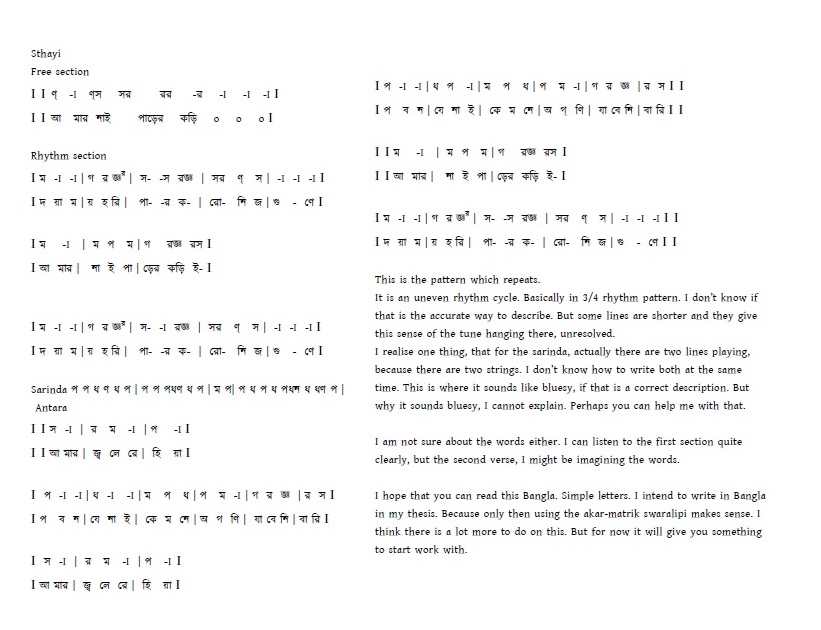
My notation, attempt at writing the words and a brief note to Olly
Sound engineer Abhimanyu Deb had done some noise reduction on the recordings for me, for enhanced listening. I zoomed into the sound of Ranjan Shaha’s songs, trying to write the words. Then I sent a note to Olly. The idea was that we would compare our listenings and our ‘translations’ across media—from sound to text and text back to sound. Moreover, the main thing for me has been to find a face and a place for a song. Where do we go in its absence?
Ethnomusicologists commonly write down their listening as notes and notation. I have very rarely tried out this exercise; I am also not equipped for it. However, Olly Weeks is such an evolved musician and composer, that with him it was easier for me to venture into the world of signs, trying to create other meanings with these old recordings, mixing languages and sonic textures. It is interesting to note how the song shifts from the source and changes meaning as it moves through different places, different perceptions and finds a place in different voices.
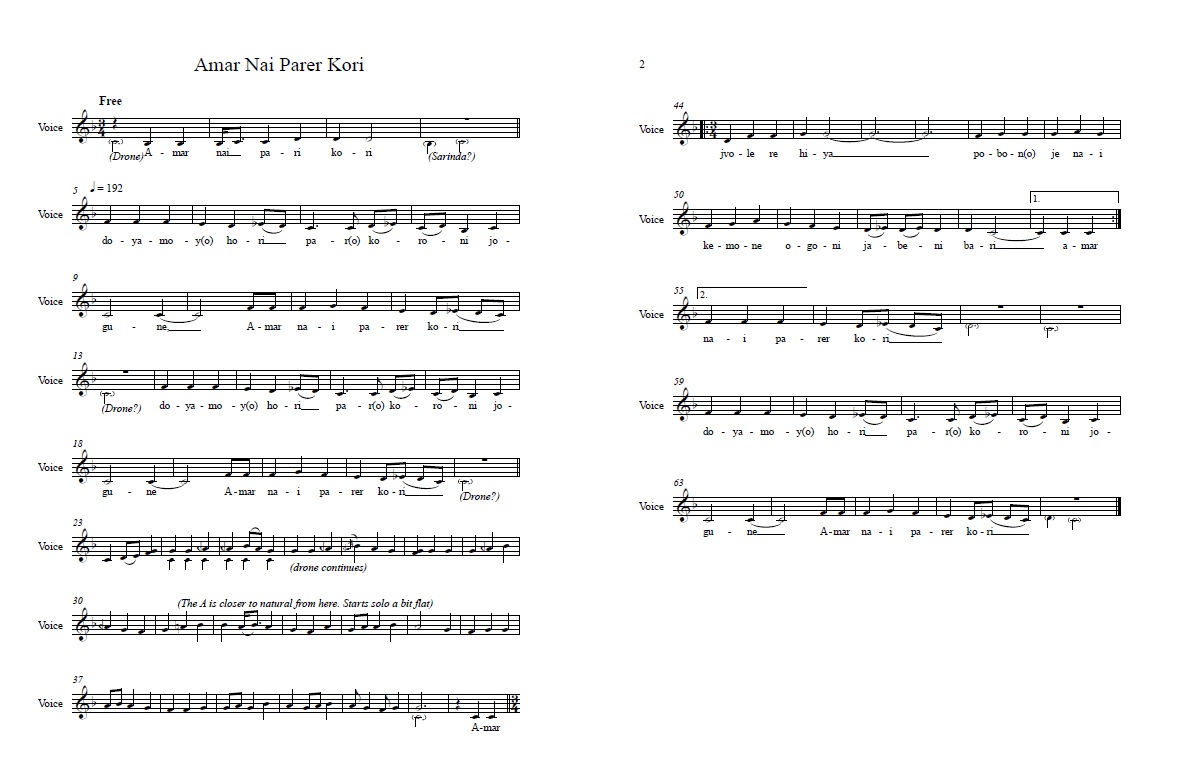
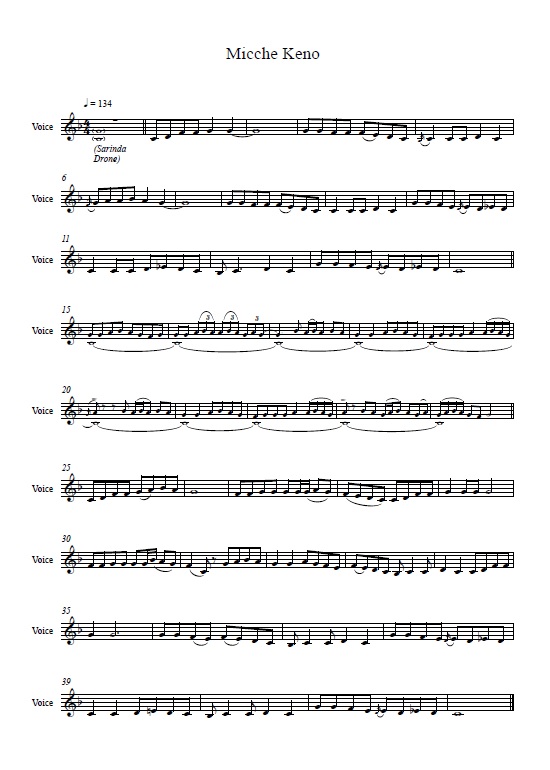
Oliver Weeks notates Ranjan Shaha’s songs and sings them too.
Meanwhile, on 16 June 2018, Anisur showed us around Kasba village: the old abandoned house of the zamindars, with trees growing in its cracks. This space inspired Anisur to sing a song for us. Soumyada said, ‘Aare, Anisur! Never knew you could sing!’ Back in his house, the family, dressed in their Eid fineries, posed for a group photo with Soumyada, while Anisur’s son showed off his bluetooth speakers.
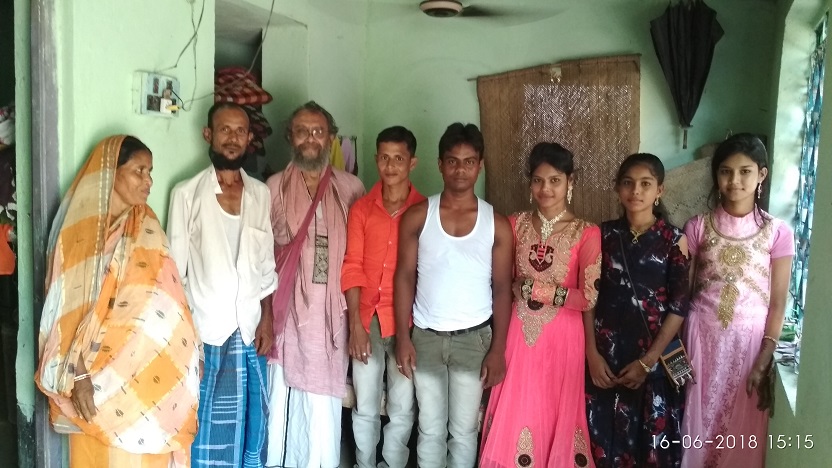
In the Bake cylinder catalogue, Kusum is described as a Bhumij woman from Bankura, who sings a ‘jumur’. Arnold Bake had recorded her in Kenduli on 16 January 1932 (Bake India II, wax cylinder 108). Bake was picking up sights and sounds from the mela. In his letter home after Kenduli he wrote about what he saw there, the kinds of people who had gathered, the entertainers and performers and the devotees. ‘Freaks and outsiders’, bathers in the Ajoy, singers and fakirs, gatherings of sadhus beneath the banyan tree. He recorded all of this with his film camera—bathing scenes, the temple, little shops, baul dancer Ganesh Shyam, Kusum, the Bhumij woman’s dance and her drummer partner. The pair must have attracted Arnold Bake enough, which is why he did not only stop at filming them (the film can be seen here), but also asked Kusum to sing to his phonograph, accompanied by the drummer. Now, it is not as though these details were all given in Bake’s notes, the audio recording had the name of Kusum, the bhumij woman, the film did not have a description with a name. But looking and listening, alone and with others (especially discussing with Amy Catlin Jairazbhoy in 2010 and then she in turn asked Carol Babiracki), it was possible for us to match the film to the audio recording. In 2011, when we first launched the Travelling Archive website, we uploaded the Bake Bengal films with permission from the Archives and research Centre for Ethnomusicology in Gurgaon. If you go to the Bake page on TTA’a Related Research section now, you will see how little we knew at the time. Ten years on, there is absolutely no doubt about the identity of the dancers and the singers or that Kusum was a nachni.
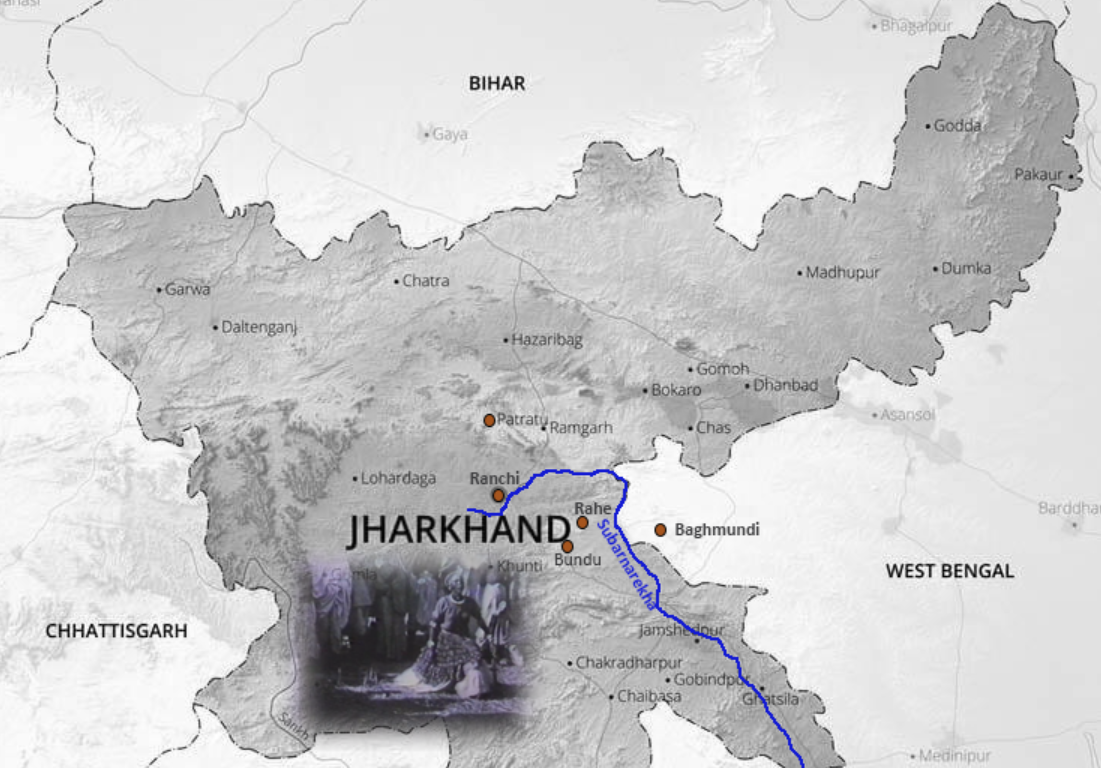
Map of all the places Kusum could have come from. Map by Purba Rudra
Who could Kusum have been? How come she was in Kenduli? Was she from Bankura or was that her temporary home at the time when Arnold Bake saw her in Kenduli? The man dancing with her, her rasik, who was he? Amy had sent me in 2010 a copy of a note her husband, ethnomusicologist and student of Arnold Bake, Nazir Ali Jairazbhoy and she had prepared on the Bengal videos of Bake for their own Bake Restudy. This note was based on Bake’s own notes.
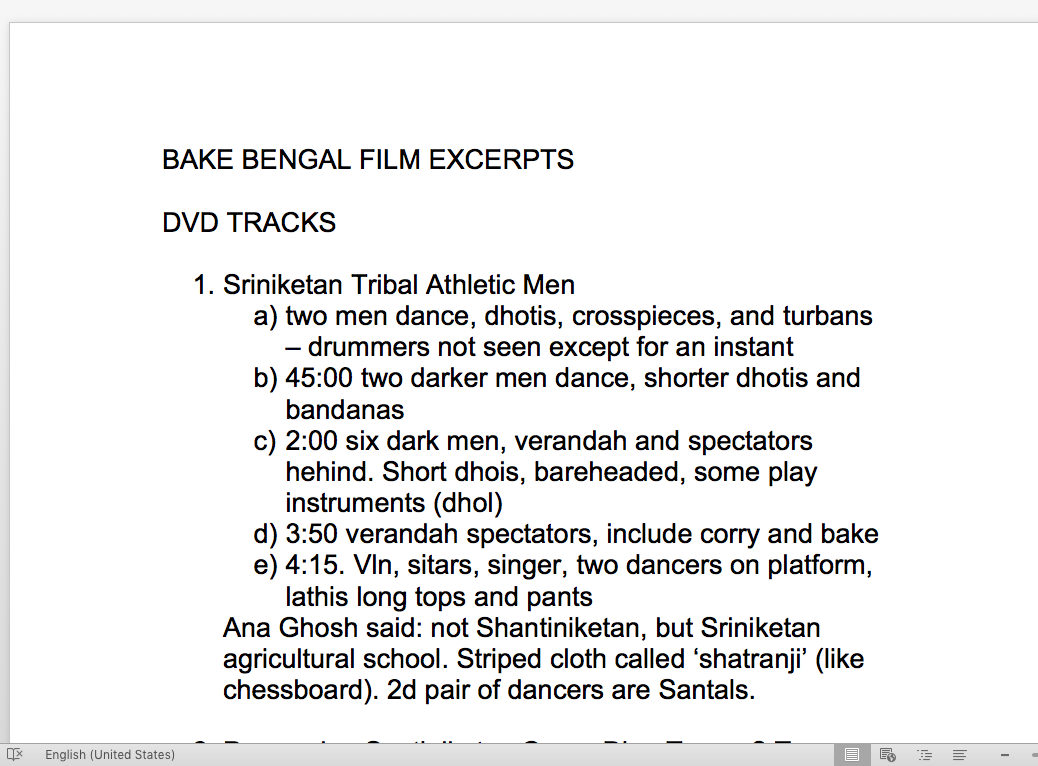
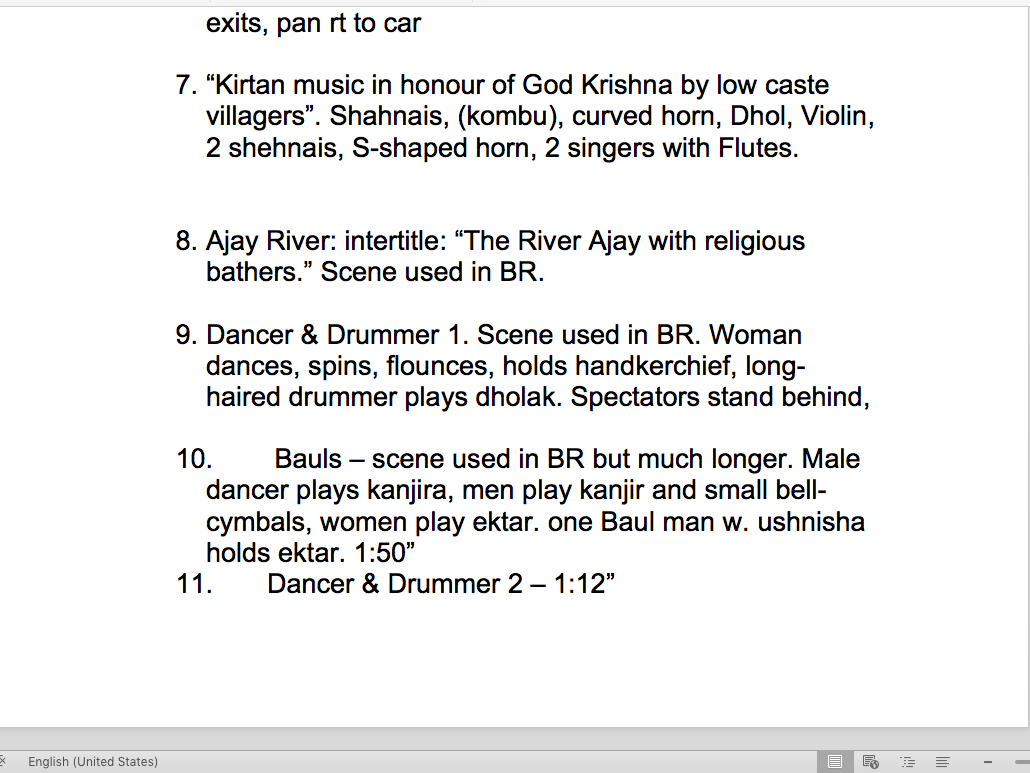
Notes from Amy Catlin Jairazbhoy, 2010
A nachni might have had many homes in many places, leading ‘an exceptionally nomadic life’, as Carol Babiracki wrote in her essay on Sundari Devi. ‘Like courtesans the world over, nacnis make an art of frustrating efforts to “know” them. Their desire to conceal in order to mitigate their triple social stigma (women, born “low-caste,” now “out-caste”) is certainly understandable, but these women actually seem to artfully cultivate the discourse of mystery that constitutes their performance culture in Jharkhand.’ (Carol M Babiracki, ‘Between Life History and Performance: Sundari Devi and the Art of Allusion’ in Ethnomusicology 52, no. 1 (2008): pp. 1-30. Accessed June 26, 2021.)
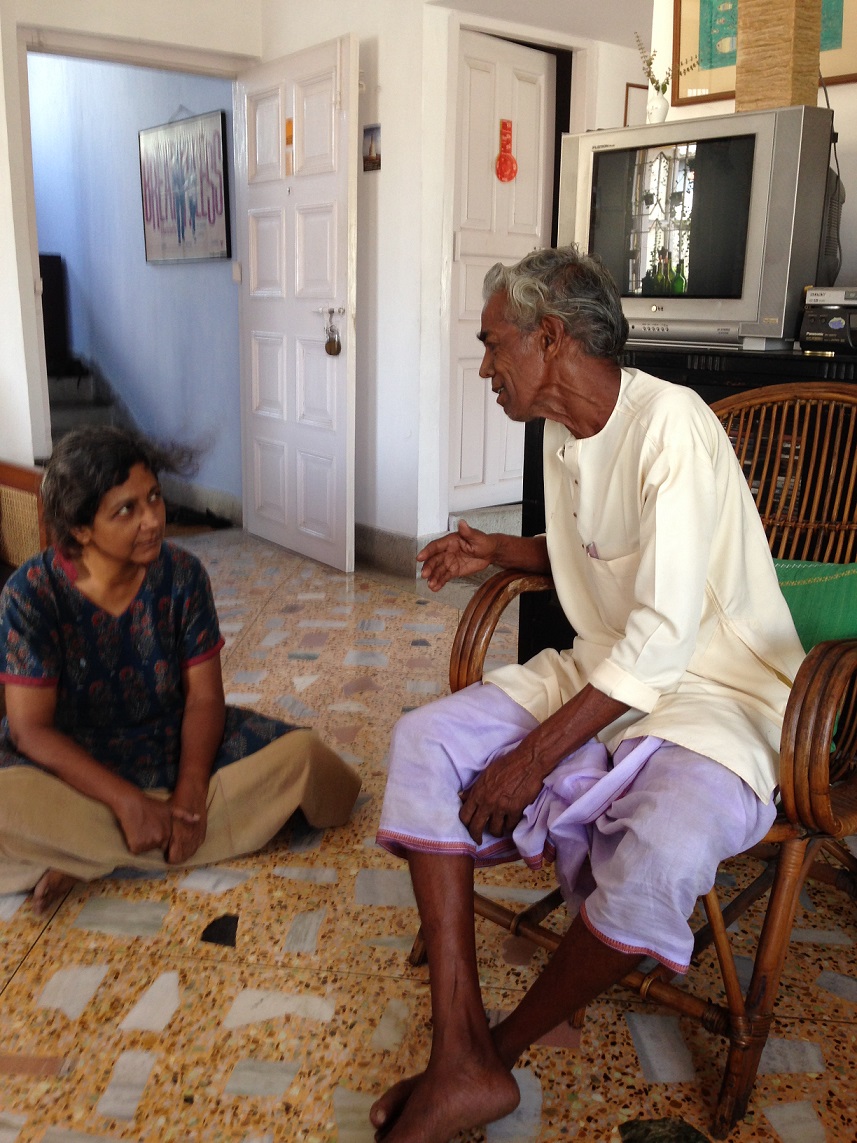
Senior jhumur artiste from Joypur, Purulia, Amulya Kumar, in my home, 2019. Photo: Abhijit Mazumdar
I had shared the song and film of Kusum with Amulya Kumar to know what he made of the recordings. I have known Amulya Kaka (as we call him) since 2005, there have been countless meetings and recording sessions. Kaka had come to my home on 5 December 2016. We had the following conversation; it is hard to summarise the content, because it so comes out of Kaka’s place and his life—he was born around 1938 and has seen and learned much. He had to just listen to the song and began to tell me the names of places from where such songs come: Bundu, Bagmundi, Rahe, Patratu, Ranchi. Then when he saw the video, he nodded in approval and said, ah! That’s what I was saying. She will have a handkerchief and not cover her head, sometimes there will be tassels hanging from both sides.
Amulya Kumar responds to Kusum’s song and dance, December 2016.
This is a ‘Tamariya’ melody, from Bagmundi. You know how the language of Purulia is different from Kolkata? Like that in these places they speak and sing in a different way—Rahe, Bundu, Patratu. He says ‘Patrahatu’. I ask him about what people there do for a living; work in the fields and forests he says, or do business. I ask about the life of the nachni, her relationship with her partner (rasik), about her song, about how she becomes a nachni. Kaka knows so much and his language is so beautiful, full of words which have a topographical dimension to them, signifying place. He hums and sings a few lines as he talks. ‘Ashadh maasher dine/Torope chhatiya’. You hear the Manbhum region in his those words and the way he utters them. Bengal is leaving Bengal and becoming Bihar—the song holds that middle place. Kaka says, it is the song which pulls the nachni out of her home. The song of the rasik. She goes with him. Lives a marginal life, is never given equal place with the wife. Always ostracised. It is a life of pain and suffering, but love too. He tells me a story about how, many years ago, 50 or 52 perhaps, when his eldest daughter had just been born, there was a girl who heard him sing and wanted to come with him. He was on an election campaign with the local candidate. He had to sing and draw crowds. The girl climbed on the jeep and said she would go wherever he went. ‘Oh my god! The sky came down on me!’ the 78-year-old man said and laughed his typical laugh. ‘My mother used to say, don’t sing when you are working in the field.’
Beautiful stories. There is an intimacy between Kaka and me—over the years, he has become a kind of parent. So, I can lovingly order him around: now you sit here, now you sing. He smokes his bidi and tells me most of the words of Kusum’s song and says we have such songs too, but we don’t sing them this way. These are biraho songs, songs of separation and longing. How does your song go? He sings a bit and stops. I don’t sing such songs. Why? Because it hurts, is it? Yes. You remember things. Your own things.
Then, there was my conversation with Bishu.
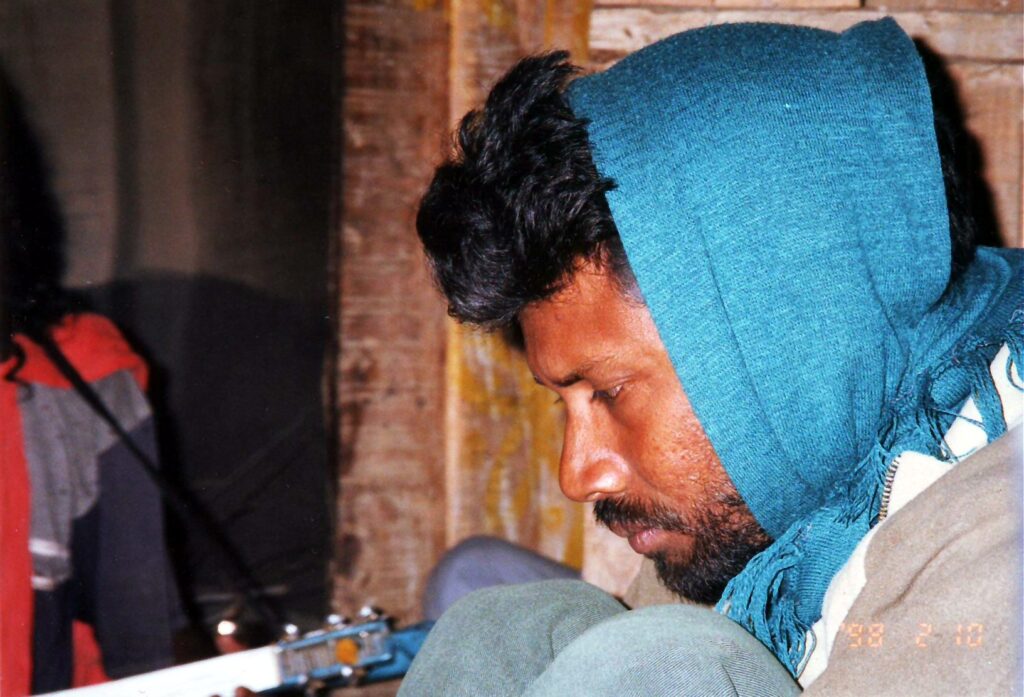
Bishu in Joypur, Bhaddi, Purulia. 2005. Photo: Sudheer Palsane
Telephonic conversation with Biswanath Dasgupta (Bishu) , 18 and 27 January 2021.
Bishu grew up in Joypur Purulia. His father was a doctor. They are not local in the same way as Kaka is, they are outsiders, arrived in this place for professional reasons, the educated middle-class. But Bishu is local in his own way. He grew to love the language and culture of Purulia, he never thought of leaving. I guess he was in his late twenties when we met, will be 42-43 now. He has deep knowledge of the folk arts of the entire Purulia, Bankura, Jharkhand regions, places of Jhumur and Chhau (the masked dance). He has worked as a theatre activist and organised folk festivals for decades. He has been a kind of conduit between the metropolis and his region. Bishu had taken us to Amulya Kaka in 2005. For about a decade we had not been in touch. Then we connected again.
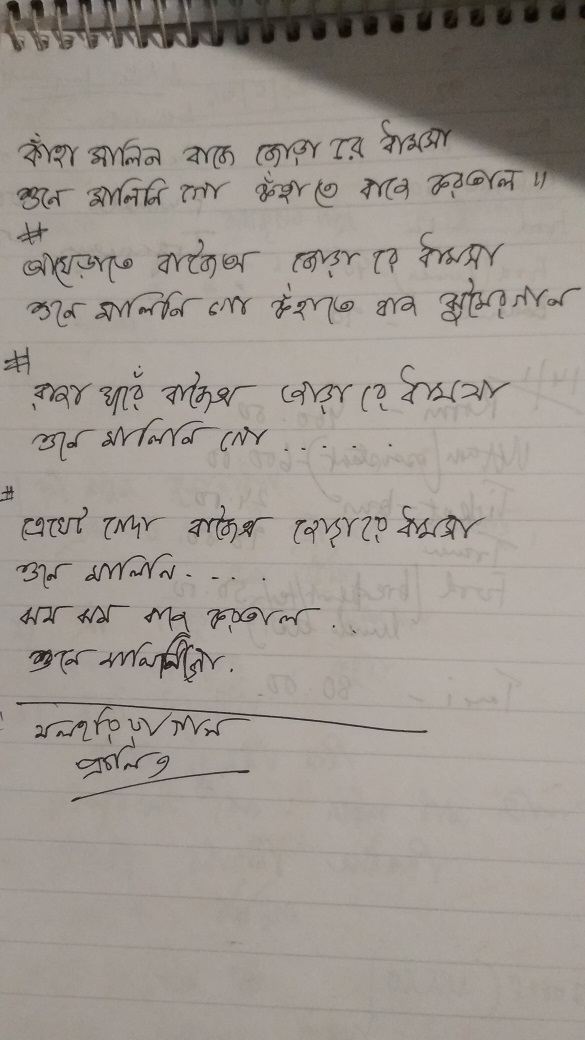
Bishu wrote this song in my notebook in Joypur, Bhaddi, Purulia in 2005.
Before I sent the file to Bishu we were talking about nachnis and why the women leave home. Bishu expresses himself in a way different from Amulya Kaka, he talked about sringar rasa—the essence of erotic love. He said they are often widows. The cry of the bhaduria jhumur pulls them out of their homes. He talked about Sindhubala, the renowned nachni who tried to bring recognition to their community and her artform. ‘She was 92 at the time and she said, you see Raja—she used to call me Raja [Bishu stresses on the ‘j’ and rolls the r, rrajjaa, he says]—she said, I am so immersed in this rasa that my life is slowly shrinking away. Rawshe thaikte thaikte shukhai gelam. And I said, how so? How can you be drowning in rasa and yet go dry? Even at ninety you are drinking, singing, and you say you are going dry? And she said, that is how it is. That is how it happens. It is this rasa which sucks the juices out of you.’ Then Bishu also talked about Kamala Jharia, the famous kirtan singer who had started life as a nachni.
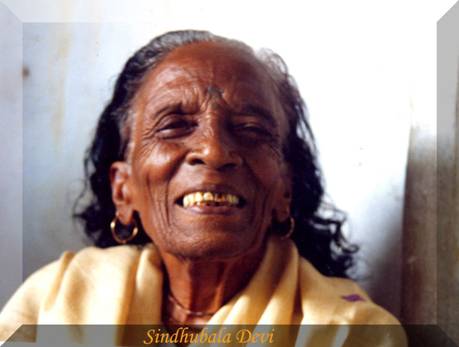
Sindhubala Debi. Source: Internet.
When we talked again, Bishu had listened to the song and seen the film. He said, it is a treat to be able to see this. She is singing in Kurmali and dancing an ‘ekoira’ dance, meaning doing a solo performance. He talked about the evolution of nachni dance, those who sang and danced for the royal court, whose who performed for the ordinary people, then how the protocols of stage performance evolved. We also talked about the last time we met, the song he had taught me and I sang some lines.
Bishu sang ‘Kahan malin baje’ in 2005 in Amulya Kaka’s house, which I had learned from him. Recorded by Sukanta Majumdar.
Gurudayal Malik (1896-1970), from Karachi, taught English to school students in Visva Bharati. Between 10-17 April 1933, Arnold Bake recorded him in the asram; he sang four mystical songs in Punjabi and Urdu on Bake India II cylinders 241-44.
During the first phase of his Santiniketan stay between 1925-29, the medieval saints of India were a major subject of discussion between Arnold Bake and Kshitimohan Sen.
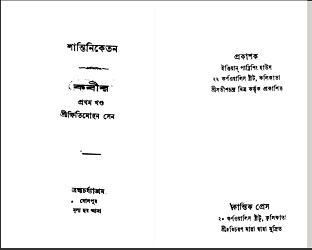
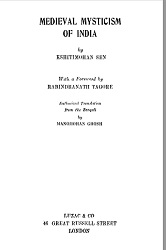
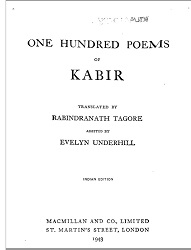
From left to right: Pages from Kshitimohan Sen’s anthology of Kabir’s songs, published in 1910; Kshitimohan’s book on the medieval poets, translated by Manmohan Ghosh; finally, Rabindranath’s translation of Kabir, with Everlyn Underhill, based on Kshitimohan’s anthology, first published in 1915.
They would go for walks together, besides having more formal lessons, and talk. Bake would attend Kshitimohan’s lectures. Bake was learning so much about the mystical poets and medieval saints of India from ‘Kshiti’, as he wrote in his letters home. For example, in his letter of 24 February 1926, he wrote page after page about Kabir, Dadu, Ramananda, Ravidas, Jnanadas and so on. Bengali author Pramathanath Bishi, one of the first students to join the Santiniketan asram as a boy, had written about how students used to be quite scared of Kshitimohan, mainly because of his sombre presence. ‘Yet it will be difficult to find someone who has not benefitted from his teaching,’ he wrote. ‘He would draw the student into the maze of difficult and dry topics and would light up the way of learning by striking the magic stone.’ Arnold Bake, we must remember, was not Kshitimohan’s student in the sense the asram boys were. He was a mature learner who had come from a distant land, who was also becoming a friend. There are some beautiful family photos of the Sens and the Bakes; Kshitimohan’s daughters would have been about the same age as the Bakes.
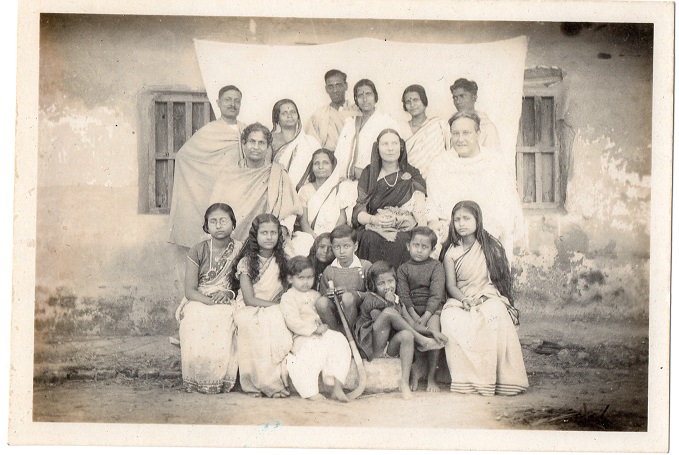
The Bakes with Kshitimohan Sen’s family, possibly taken in the late 1930s. Photo courtesy: Shibaditya Sen, my departed teacher and grandson of Kshitimohan. Shibda had dated the photo by seeing his older cousin, Amartya (later to become the famous Nobel laureate economist Amartya Sen), third from the left in the front row. Amartya Sen was born in 1933 and the boy in the photo will be about five or six–that was Shibda’s calculation.
On 28 December 1926, Tuesday, Arnold Bake had written to his mother that the previous Friday, at about two in the afternoon, they had heard beautiful songs coming from the school of music. ‘This doesn’t happen very often, so we raced to see who it was. It turned out to be Mallik [it is interesting that Arnold Bake wrote Mallik, the Bengali surname, for Malik; the catalogue too has Gurudayal’s name as Mallik], a singer with a strong mystic disposition (maybe we already wrote about him last year, his farewell party was held just a few days after we arrived. He left to help is father, who is a very wealthy merchant in Karachi). Mallikji knows volumes of mystical songs, and he sings them with a rare beauty. His voice is a hundred times better than what is ordinarily found; but even without it, it would still be more than worthwhile to hear him sing, because he pours his soul into it. It is exceptionally touching. He was here only for a few days, but his dream is to come back and work under Gurudev, when his father will grant him leave.’ (Translated from the Dutch by Jan-Sijmen Zwarts)
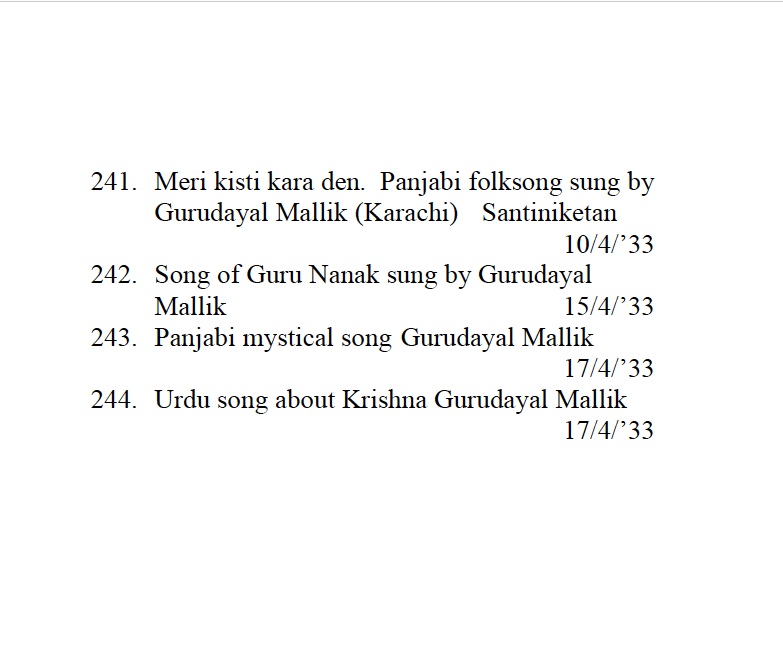
From Berlin Phonogramm-Archiv’s list of Bake cylinders.
Arnold Bake’s relationship with Gurudayal Malik’s song, which began in 1926, continued through 1933 right up to 1950. Bake kept a record of the impression Malikji’s songs made on him in his letters; he recorded him with his machine; even archived his songs in his own body. In a lecture Bake gave in The Netherlands in 1950, talking about Indian folk and classical music, he sang one of the songs that Gurudayal Malik had sung for him on 17 April 1933, ‘Meherban meherban, sahib meherban’.
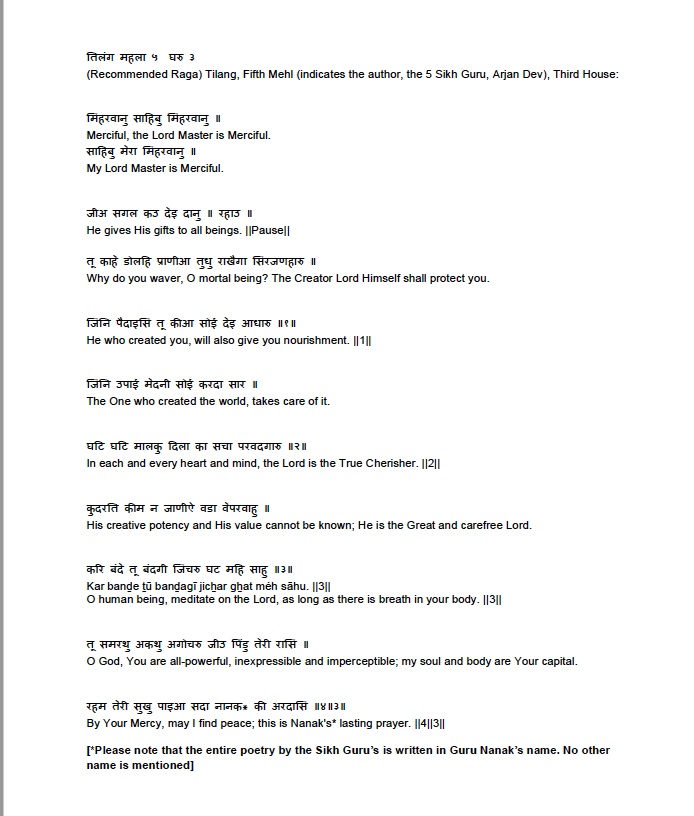
I shared the recordings of Gurudayal Mallik with Punjabi Sufi singer, Madangopal Singh to learn his thoughts and he sent me texts of the songs with some explanation (the above note is from one of his emails to me written on 3 November 2020). The song ‘Meherban meherban’, which Bake used to also sing, and which is mentioned as a composition of Guru Nanak in the catalogue notes, is in fact a composition of the fifth Sikh guru, Guru Arjan. Madanji wrote: ‘The entire text [as you can see above] is given here in Devnagri script with English translation as approved by the Sikh body, SGPC, whose knowledge of the English language is suspect in the best of circumstances. Two things could be special interest to you: a) The ‘shabda’ – hymn – is unambiguously attributed to the fifth Sikh Guru, Guru Arjan. Guru Nanak was the first Sikh Guru. He was followed in the line by Guru Angad, Guru Amardas and Guru Ramdas. Guru Arjan happened to be Guru Ramdas’s son and was martyred on the banks of the river Raavi in Lahore in the 16th century by a repressive state. b) Since the last stanza mentions the name Nanak, it may give rise to the suspicion that the author of the ‘shabda’ is Guru Nanak himself. That, in fact, is settled right in the beginning where the Mehla 5 is mentioned, that clearly identifies the fifth Guru as the author. It may be further mentioned that after Guru Nanak, no other Guru used his own name in any of the ‘shabdas’ he wrote. The name of Guru Nanak is used throughout from the second to the ninth Guru. That has been the practice.
‘A minor point finally: the recommended Raga is Tilang but it is by no means mandatory to sing in that Raga.
‘Of course, there are some textual deviations in the audio files sent by you and I can tell you that had the Sikh clergy got wind of that in the thirties, there would have been a minor storm in the poetic teacup of Mr Malik.’
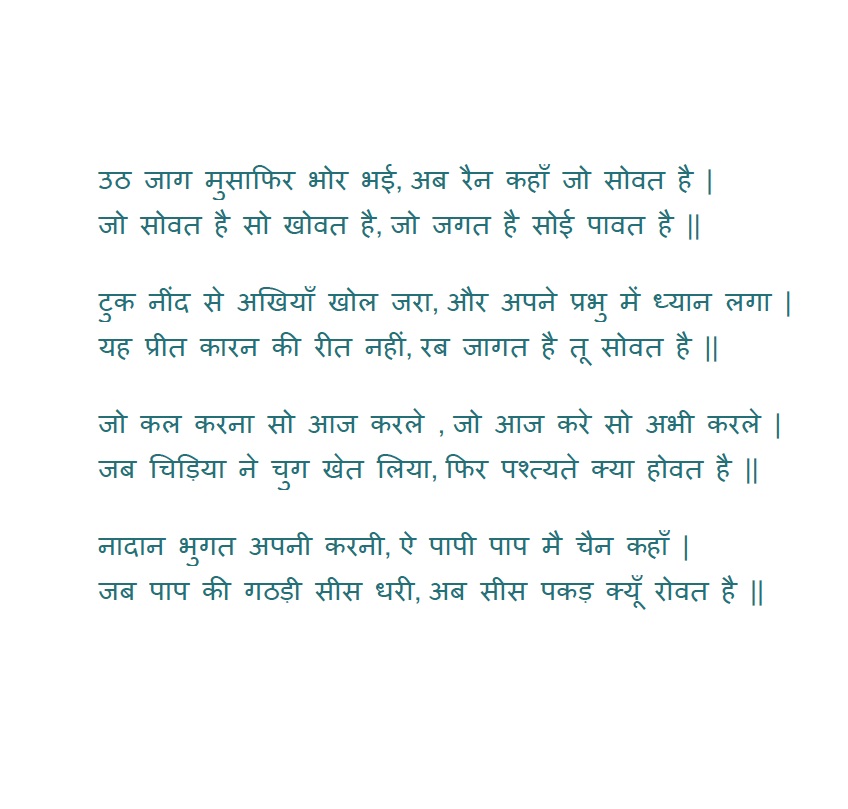
Madanji also wrote about another song from that list. ‘The other song as I mentioned is a Prabhat Pheri (literally, the Early Morning Musical Walk of the mendicants) bhajan with a cleverly concealed message for the people to rise against the British regime.’ I kept pleading to Madanji to send me a song in response to what I had sent him. He said, ‘Much as I wouldn’t want to say “no” to any of your requests, yet despite trying over and over again, I have not been able motivate myself to either respond to the voice or the melody you had sent from your archive. I will most reluctantly have to say ‘no’. With warm regards from a diehard fan of your singing, scholarship and research, Madan’. I kept at it, though, and then Madanji sent me this absolutely beautiful song of Kabir, with his own translation.
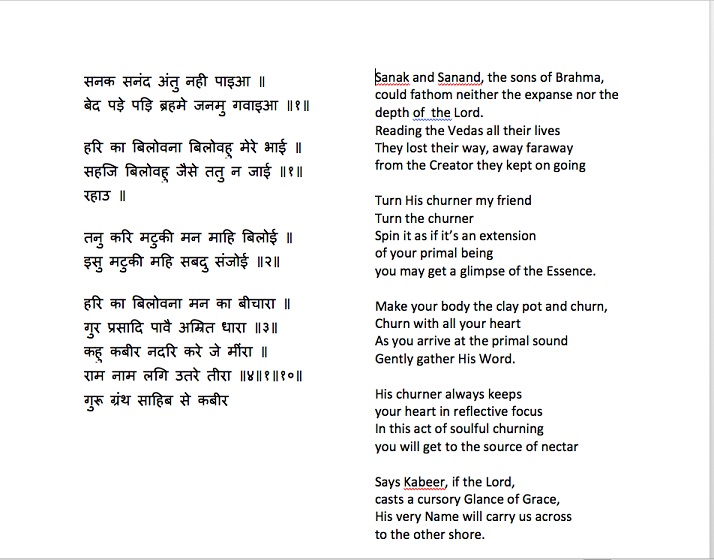
In 2016, while preparing for The Travelling Archive’s exhibition in Santiniketan, Time upon Time: Arnold Bake in Bengal, we had gone to meet the famous Tagore singer and retired professor of Sangit Bhavan, Visva-Bharati, Mohan Singh Khangura in his home.
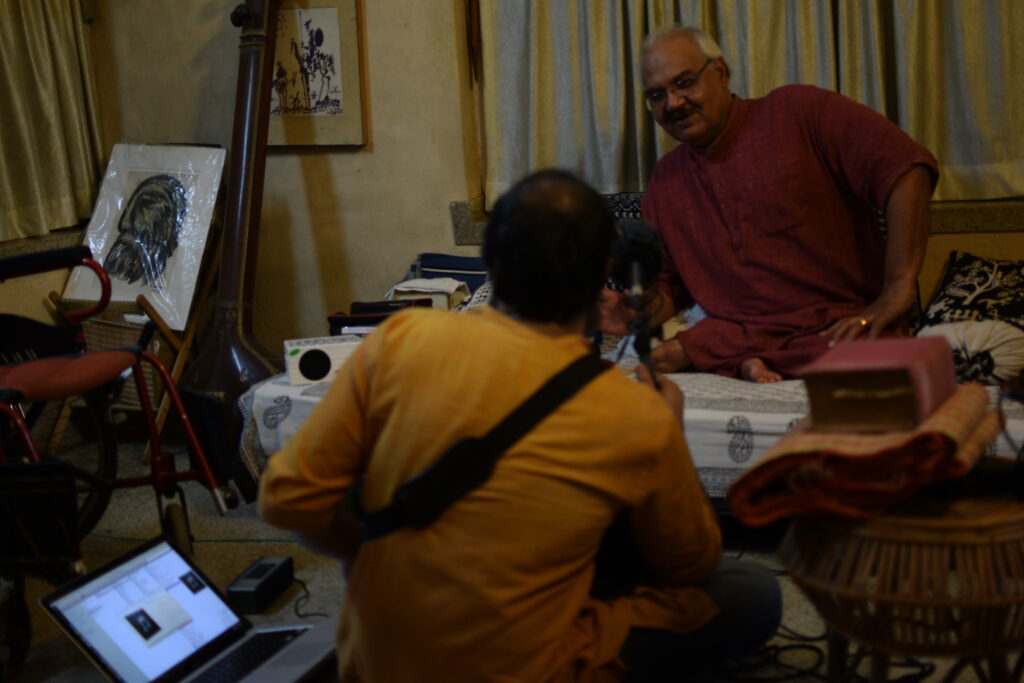
Mohan Singh Khangura being recorded in his home in Santiniketan by Sukanta Majumdar. 11 March 2016. Photo by Jan-Sijmen Zwarts.
The choice of Mohan Singh was obvious; as there was a sonic continuity from Gurudayal’s voice to his, also a geographical contiguity, as both had journeyed from Punjab to Santiniketan, even if many years apart. In 1938, singer Rajeswari Datta (then Vasudev, later married the poet Sudhindranath Datta) had also come from Lahore to Santiniketan and studied in Sangit Bhavan for four years. Again, a journey from Punjab to Bengal, pulled by the songs of Tagore. I wonder why Bake never mentioned Rajeswari, or maybe he did and I am not aware of it, since she was one of the finest singers of Rabindrasangit we have ever had and they were contemporaries too. Both of them were part of the Tagore centenary celebration in London in 1961. Incidentally, Rajeswari also taught Indian music at SOAS, but that would be after Bake.
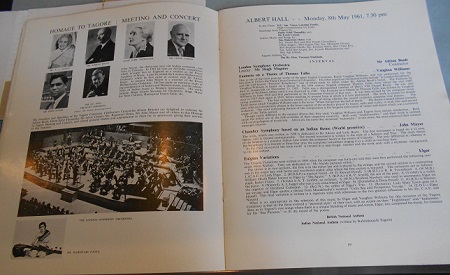
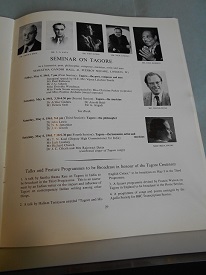
We can listen to a Rabindrasangit of Rajeswari Datta ‘Kichhui to holo na’ here
Anyway, coming back to Mohan Singh, or Mohanda, he sang some examples of Punjabi kirtan or ‘Asa di var’, and then he sang a ‘shabda’, and a song of Bulleh Shah and one of Kabir. These are absolutely precious recordings; they were made by Sukanta Majumdar in the presence of Mohanda’s older son Abir and the Director of the Archives and Research Centre for Ethnomusicology, Gurgaon, Dr Shubha Chaudhuri. The date of the recording was 11 March 2016. I cannot remember the name of the tabla player.
A test recording, as Mohanda wanted to make sure the sound was alright
Mohan Singh sings a Punjabi ‘shabda’ or devotional song as is sung in gurdwaras
Mohanda sings a song of the 17th century Sufi poet of Punjab, Bulleh Shah. Then he says, no one to learn such things here, none to listen even. But I sing for myself.
Mohan Singh sings ‘Awal Allah noor upaya’, a song of Kabir
The celebration of the plurality of faiths and engagement with the Bhakti and Sufi saints and poets has been part of the culture of Santiniketan from its inception. It found its fullest expression in Binode Behari Mukherjee’s ‘Medieval Saints’ mural, which adorns the walls of the university’s Hindi Bhavan. The work was completed in 1947.
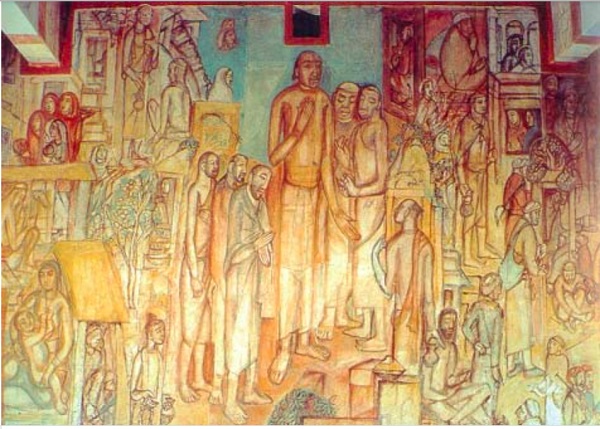
Source: Chakrabarti, Jayanta, R. Siva Kumar and Arun K. Nag eds., The Santiniketan Murals (Kolkata: Seagull Books, in association with Visva-Bharati, 1995). I thank artist Syed Taufik Riaz for lending me his copy of this book.
Slowly the sessions are moving towards listening to listening, layering recording upon recording. Now the tapestry has started to form. Seema Acharya is a renowned singer of kirtan and we went to her home in south Kolkata; we meaning sound recordist Sukanta Majumdar, I and Jan-Sijmen Zwarts, who has come from Utrecht to stay with me and help me read Arnold Bake’s letters. He took all the photos of the day. There were many with all the sweets and goodies we were treated to, which J-S’s lens especially saw, which I am not including here, although story goes that the older Dutchman whose footsteps he was following was also attracted to Bengali food.
On 8 February 2016, I took the recordings Olly had sent from London, singing Arnold Bake’s notation of kirtan to Seemadi, to see what she made of them.
A vibrant personality and of course a very fine and equally knowledgeable singer, Seema Acharya enriched us with songs and stories. She broke into song as she heard Olly play and sing, filling in with details about kirtan, endorsing Arnold Bake’s notation; thus endorsing Bake’s listening and interpretation. Our recordings of the day were made by Sukanta Majumdar.
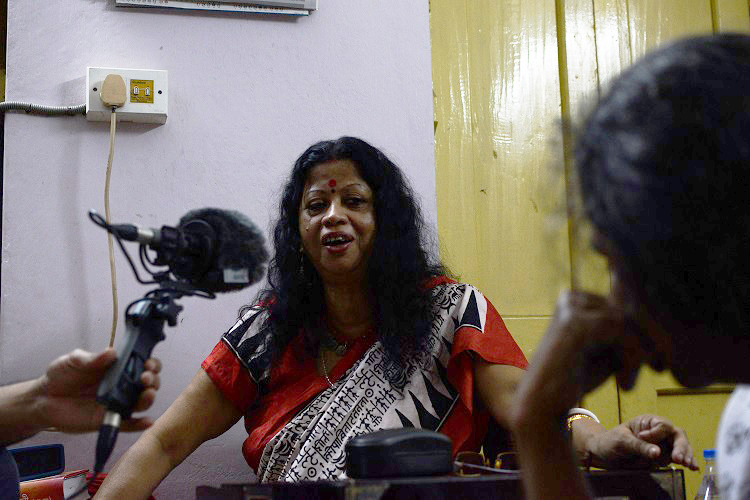
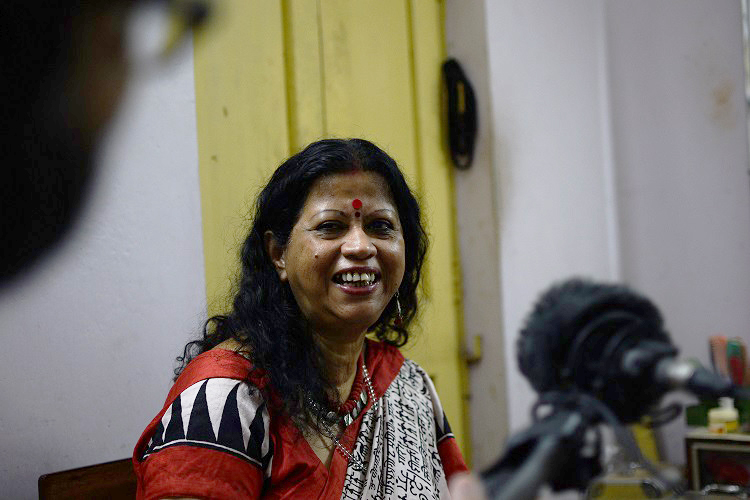
Seemadi knows these melodies, she recognises them as being of the style of kirtan she has been trained in.
After the Nam Sankirtan played in Rag Pilu and Sindhu Bhairav, we come to ‘Esho duti bhai Gouro Nitai’ and before we can even start Olly’s song, Seema Acharya starts to play the harmonium and sing. She explains that this is the ‘adhibash kirtan’, a song about friendship and love, and without these true devotees, Gour and Nitai, no celebration of the divinity of Krishna and Radha is ever complete. When Olly’s song starts, Seemadi is amazed that what he is singing is so similar to her song. We come from the same school after all, she says. What she means is, Bake was taught by Navadvip Brojobashi and her guru Chhabi Bandopadhyay was also taught by him.
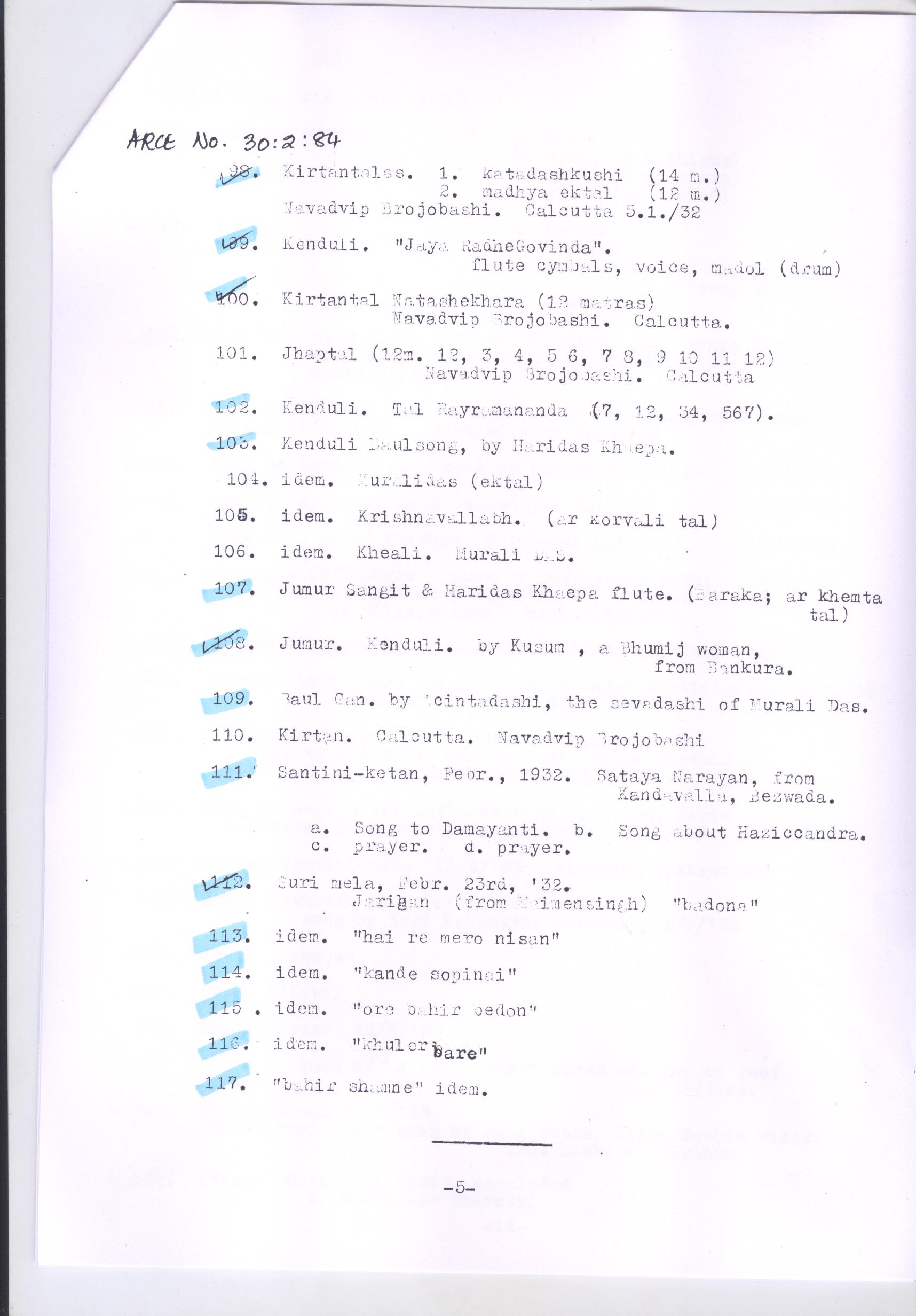
Here is a Brojobashi recording of Arnold Bake, which we got from the Archives and Research Centre for Ethnomusicology (ARCE) in Gurgaon. First, ARCE’s archivist then, poet and sonic archaeologist, Uma Shankar Manthravadi makes an announcement for the recordings he sent for our website in 2010.
The comes Navadvip Brojobashi’s kirtan, recorded in Calcutta by Arnold Bake on 5 January 1932. Another recording can be heard on our Related Research page on Arnold Bake.
Seemadi talked about the far-reaching impact of kirtan, how it can touch so many hearts at the same time.
There is a short piece in Rag Behag and it sounds so Tagorean.
Seema Acharya talks about her family—her mother who sang, her father, Phani Bhushan Bhattacharya, who was from Mymensingh, from the bottom the Garo Hills, who was a natural musician and could play many, mainly string instruments.
Seemadi then sings the Mathur—songs of separation, longing and love.
She then talks about growing in a family of musicians, playing the guitar, forming a band called Green Leaves Orchestra, also singing English numbers such as the Jamaica Farewell! Then one day she listens to Chhabi Bandopadhyay and her life begins to change forever.
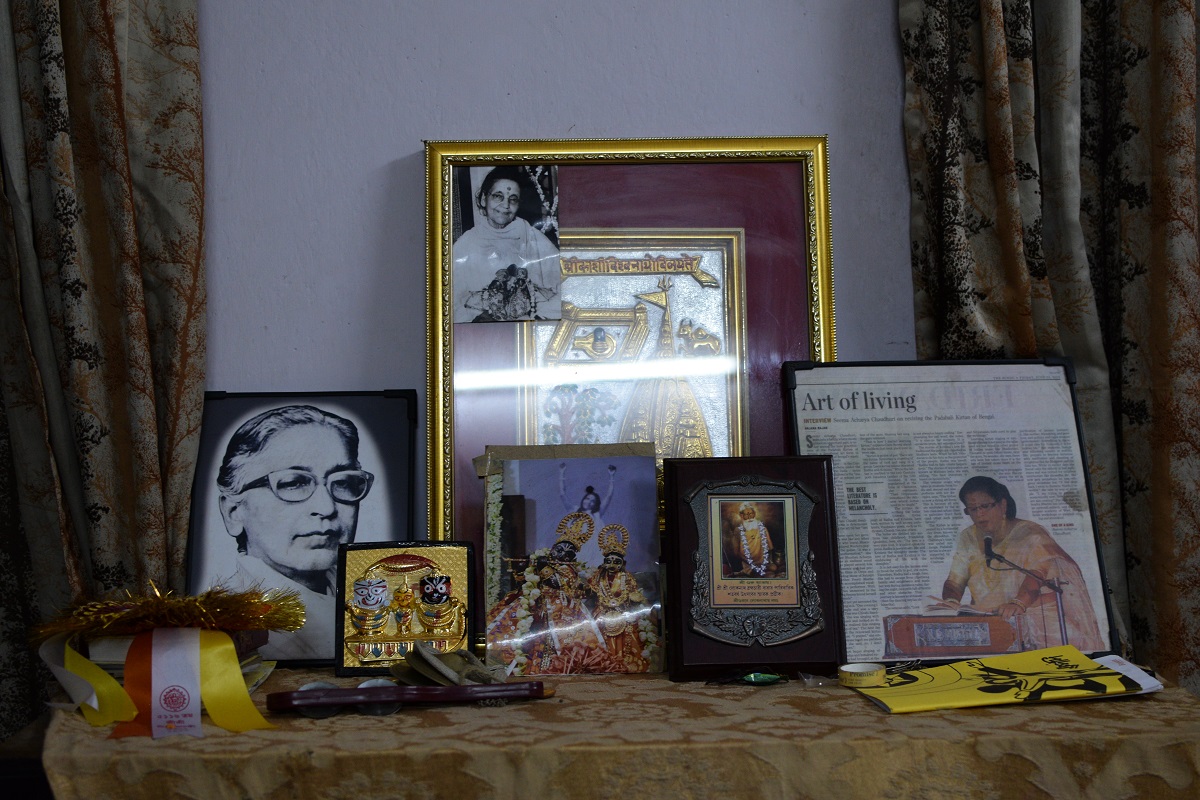
The shrine in Seema Acharya’s home, with her gods and her guru and a framed newspaper article about her.
Oliver Weeks is a British composer and multi-instrumentalist with whom I have been collaborating since 2002. We had a band called Parapar, between Kolkata and London, and even now we continue to make music together. I have learned so much from Olly and consult him on various—mainly Western classical music related—issues.
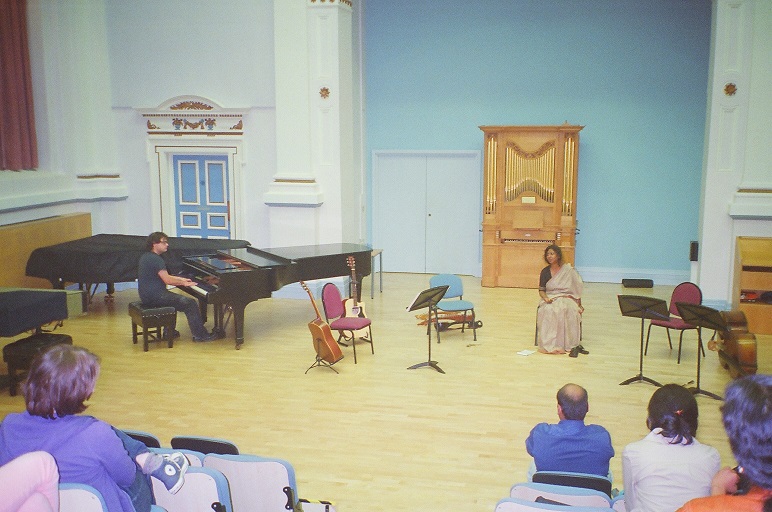
This is an old image, of Olly and me performing at Leeds University in 2010. Our other band members were also present, but I wanted to use an image of Olly at the piano.
In 2015, I had worked at the Arnold Bake archives at the School of Oriental and African Studies (SOAS) and found in his files some handwritten notation of kirtan from the 1940s, when Bake was taking lessons from his teacher in Calcutta (I write Calcutta, not Kolkata, as that is how the city was called at the time), Navadvip Brojobashi (1863-1951). (I am using the spelling on Bake’s list of wax cylinders at both the British Library and Berlin Phonogramm-Archiv, although the name is spelt Nabadwip Brajabashi by historian Bob van der Linden in his biography of Arnold Bake and Nabadwipchandra Brajabashi by the scholar of kirtan Eben Graves. Earlier, in 1932, Bake had recorded Brojobashi on his wax cylinders (nos. 98-101, 110)—that is when they might have first met. As Bob van der Linden writes, ‘Arnold notated some kirtan songs as sung by the guru of Shashanka Chatterji, his Bengali teacher. He had met the guru before in Calcutta but only knew him as Sadhu Baba. From him, he learned nam kirtan or the singing of the holy name, a far more popular but unsophisticated singing style than that of lila kirtan, which he learned from Brajabashi. It is to lila kirtan, Arnold wrote, that “Bengal owes the best of her lyrical poems’ and it continued to be ‘an outlet to arefined and intricate, but most certainly very deep, religious feeling, not equalledin any other part of India”’, quoting Bake’s 1948 essay ‘Cri Chaitanya Mahaprabhu’. It is these notations which are kept at SOAS. I took photographs of the pages and gave them to Olly to find out what he made of them. Archival rules restrict me from putting my photographs of Bake’s papers in a public domain and in any case here I am trying to do something else.
In the published version of ‘Cri Chaitanya Mahaprabhu’ Bake he did present some of the notation and here are two pages from that essay.
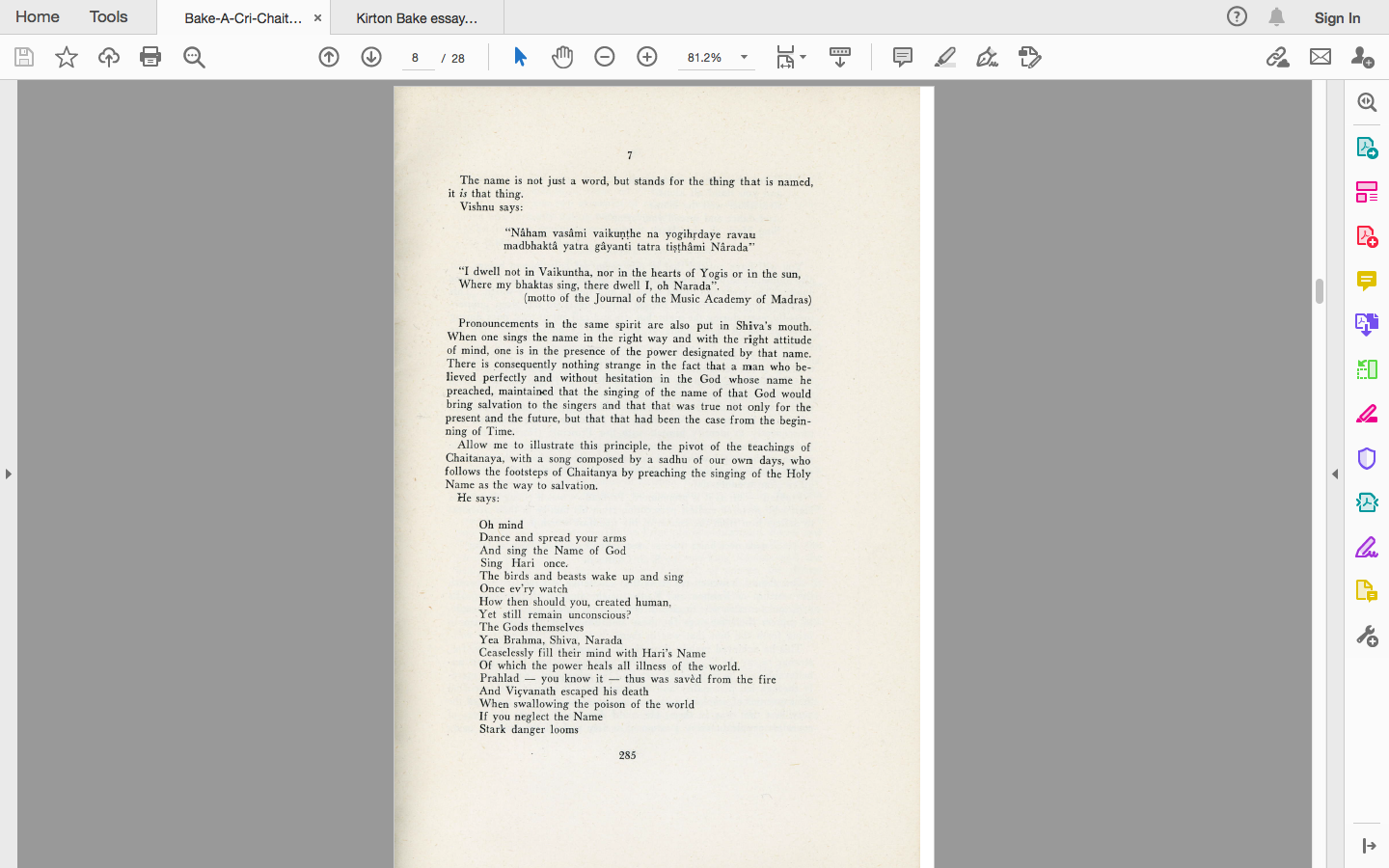
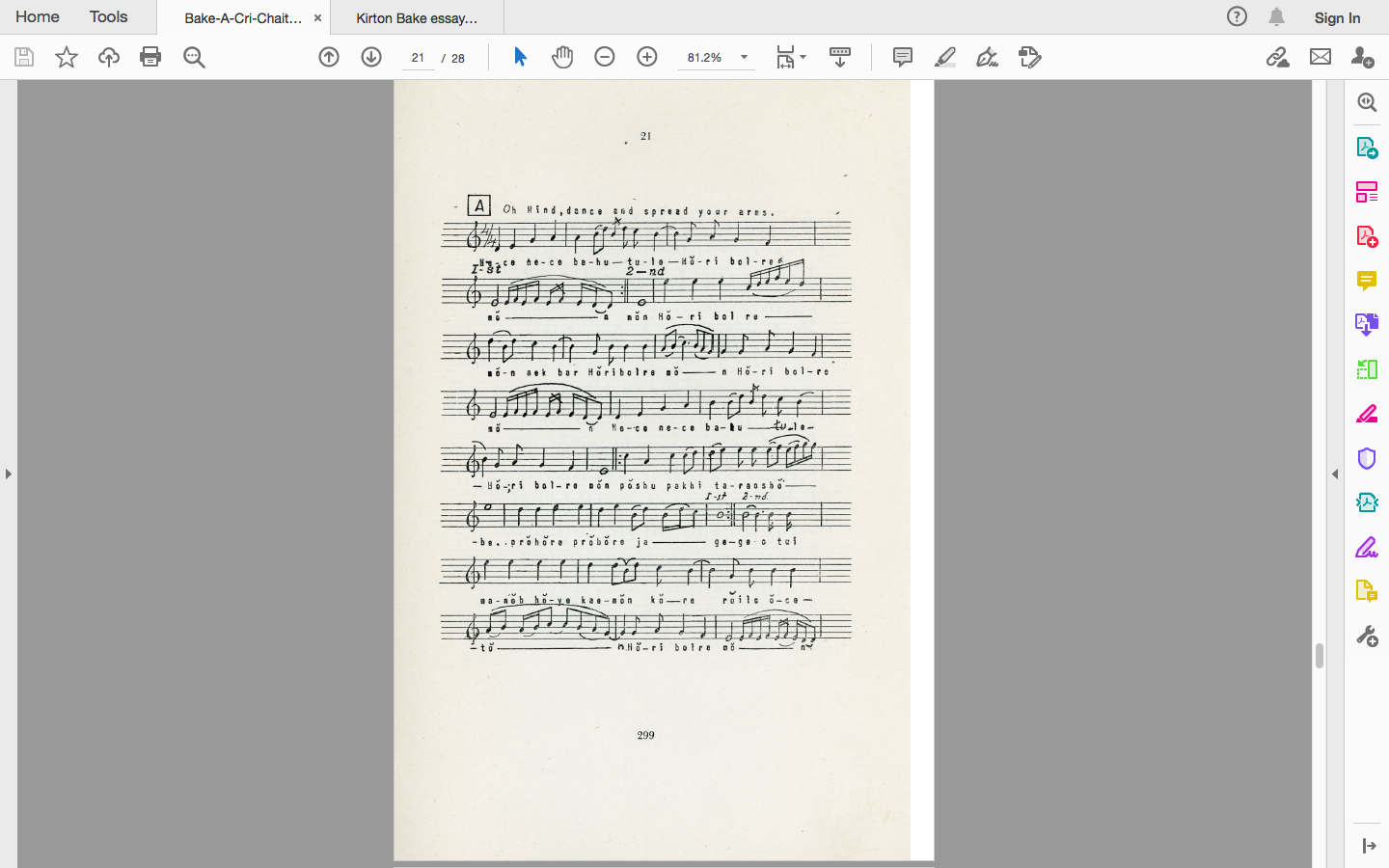
The notation that Bake made was a translation of sound into sign, and here the sign is being sung again, transformed back to sound. Between all these listenings and interpretations, so much has happened. To me, for example, if I were to listen to Olly playing the nam kirtan notation in Sindhu Bhairavi, I would never think of kirtan. Rather they bring to my mind Tagore’s melodies.
Arnold Bake had sung kirtan for two hours at Vrindavan in 1945, supported by his teacher Brojobashi on the khol. Bob van der Linden writes about how he sang five to six songs, sitting ‘in a cross-legged position among the musicians in front of an audience of a few hundred Indians. He did not feel very secure and was especially scared that he would not be able to join in on time after the rest of the group had finished their reply to his verse. Even so, he thought that he made few mistakes because Brojobashi’s drumming had led him through it all. Two years later, he wrote to the former American Consul in Calcutta, Edward M. Groth, that the performance was ‘one of the most cherished memories’ of his life.’ Linden, Bob van der, Arnold Bake: A Life with South Asian Music. (London, New York: Routledge, 2019), p.83.
I wonder how Bake’s kirtan might have sounded. I have heard his recordings of Rabindrasangit on Pathe, made in 1930 and for his lecture-demonstrations in the 1950s, he has sung both Tagore and other songs that he learned during his days in Santiniketan. The familiarity with the language and the music is evident in the renditions; I hear both a closeness and a distance, an insider-outsider voice in those songs. Olly too has been working with Bengali music for many years and he too has an insider-outsider location in this music, although this material is far more unfamiliar to him than it was to Bake. The announcements of numbers that he makes at the start of the recording are the file numbers for my photos of the notations from the SOAS archives. Olly made these recordings at his home in London and sent to me.
On our first trip to Naogaon, there was a man in our train compartment with whom we had got talking. He was a Bangladesh Railways staff who worked in the signals section at Ishwardi station, but he was on leave that day. His name was Mohammad Enamul Kalam and he told us stories about how he also practiced acupressure and healing and was returning from a patient’s house. He talked about many mystical things and I somehow felt there was more to this encounter, it would not end with this one conversation. So I asked for his phone number. Before this second trip Enamul bhai and I spoke on the telephone and we arranged to meet at Ishwardi station. I was anyway fascinated by the idea of a man who signals trains to halt and pass. Also, the name of these stations.
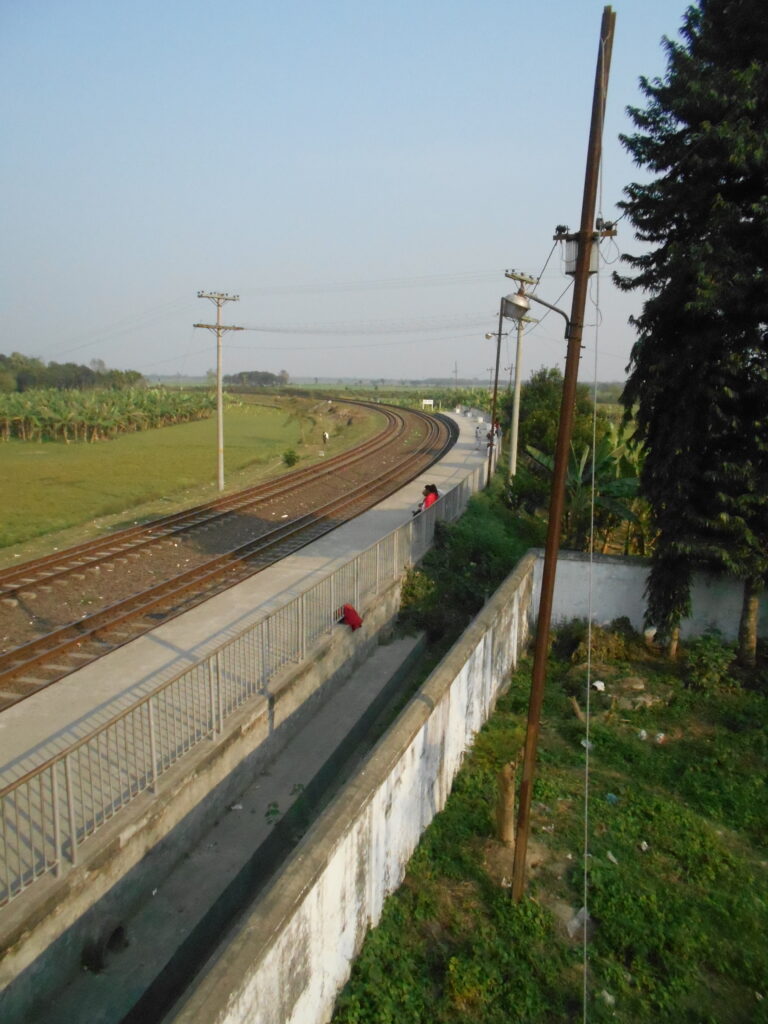
After last year’s trip and the visit to the Naogaon Ganja Society Cooperative office, I had a feeling that I would now have to look elsewhere for the fakirs on Bake’s cylinders and maybe I would be able to come back to Naogaon at some later stage. The folk music collector Muhammad Mansooruddin (1904-87) – this is the spelling he might have liked to use, with a double o, as I have seen his letter to Arnold Bake signed thus, although the conventional spelling is Mansuruddin—was Arnold Bake’s companion on his 1932 Naogaon trip. He came and met the Bakes at Santahar station, then took them in a carriage to Naogaon where they would be staying with the Sub-Divisional Officer, Annada Shankar Ray, himself a reputed poet and essayist, and his American wife Lila, also a writer. Mansooruddin was with Bake when he was making his recordings on 28 February 1932. He was making his own recordings, albeit in his notebook, as has been recorded by Annada Shankar in an essay. My thoughts were that perhaps the songs Bake recorded later appeared in some volume of Mansooruddin’s Haramoni?
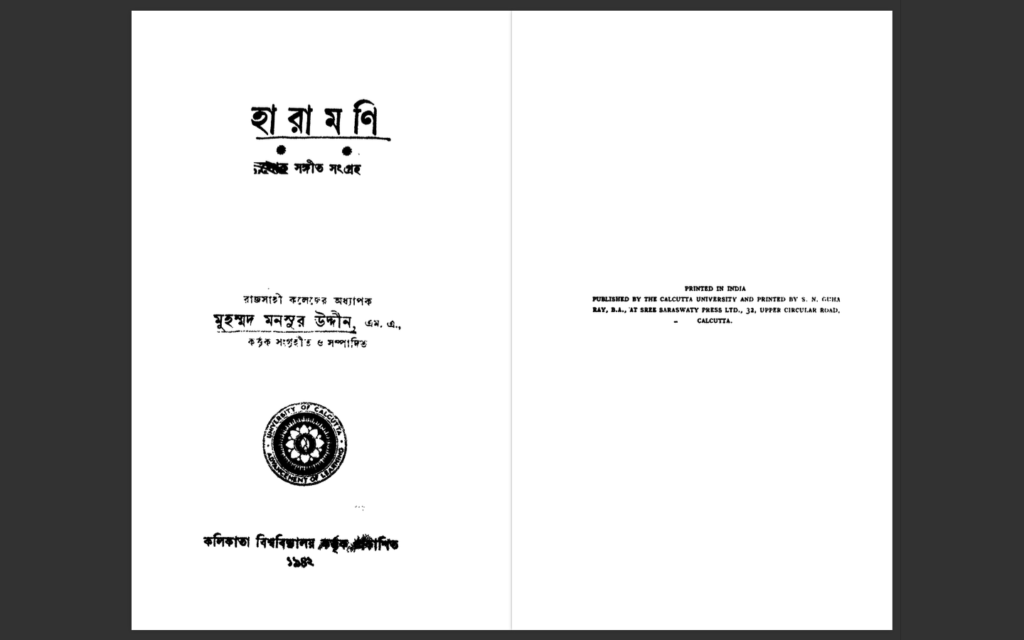
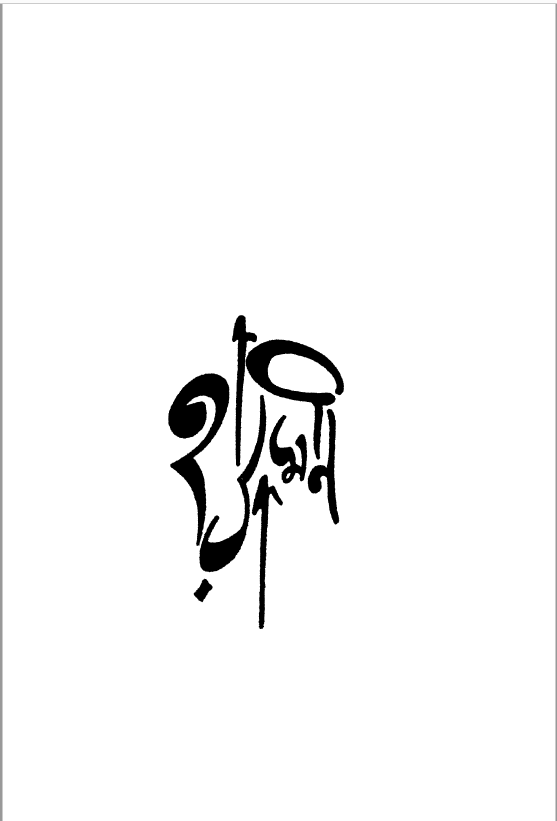
I was accompanied on this trip by Dhaka-based filmmaker-photographer Moti Rahaman, a nephew of Mansooruddin’s, and his wife Nowrin Oshin, a young writer and editor of a journal on environment. Moti had been trying to work on Mansooruddin, but the rest of the family weren’t so keen to build an archive with the papers and correspondence of this man’s amazing collection of folk songs, published in 13 volumes, between Calcutta and Dhaka. Much of the material must be either lost or scattered beyond retrieval. I thought we could look for the songs Bake recorded in Mansooruddin’s volumes, itself a difficult task. Before that we would have to be able to listen to the songs, get a sense of the words and thus know what to look for. All of this would take time. Going to Mansooruddin’s home, seeing his grave, going to the station where he had met Bake, tracing the route the Bakes would have taken—that would give a sense of a lost time, I thought. Moti, Oshin and I took a bus from Dhaka to Sirajganj.
From these recordings, the listener will get a sense of place and time. As I am listening again, I can listen to my mind, formulating the questions. I am moving bit by bit, looking, listening, feeling, searching and finding too.
We had to wait for a long time at Ishwardi Road station and Enamulbhai told us stories about trains and stations. Oshin and Moti joined in, Enamulbhai read Oshin’s palm and told her, her story!
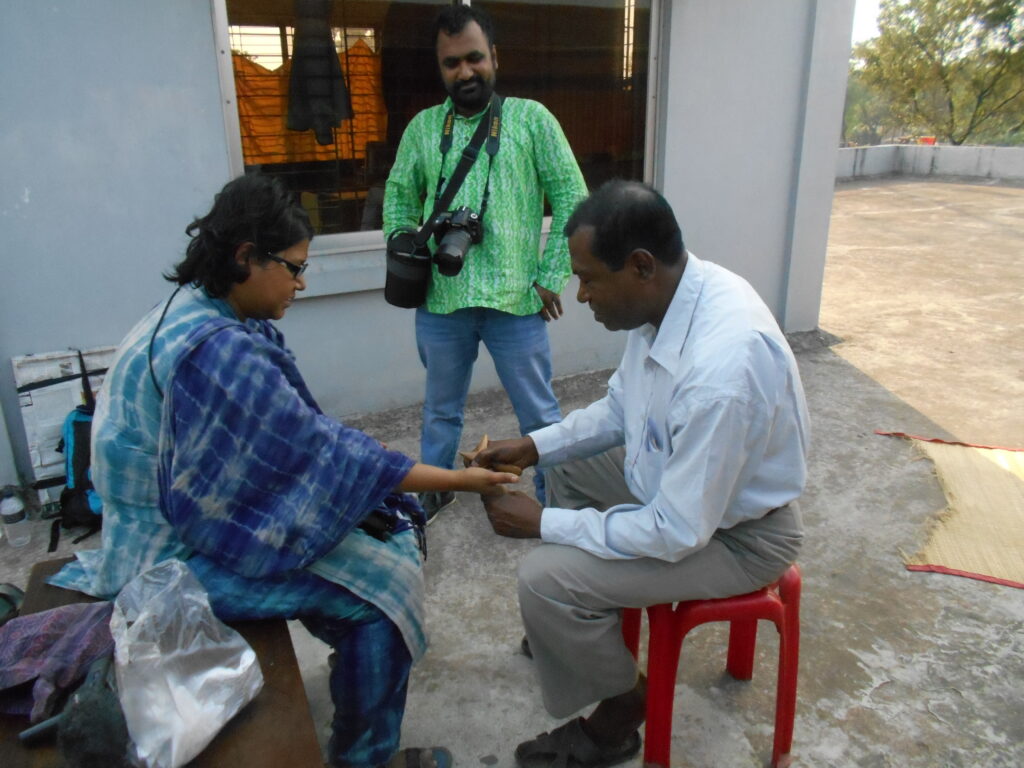
Then on the train to Santahar, Enamulbai and I chatted with a man from Joypurhat about the land and crops and catching fish in Chalan Beel—the estuaries which form when water from the hills flow down and flood the fields, transforming them into lakes. Then the villages become little islands and people go from place to place in boats. I asked the man if they grow ganja in Joypurhat and he said no. Then Enamulbhai told us a story about tasting ganja for the first and only time in a friend’s house near Akkelpur, near Naogaon.
At Santahar station I wanted to get a feel of what the place must have been like when Bake came here all those years ago. We went for a walk and Enamulbhai talked about the railways and old stations, Jagatee and Pakshey and the Hardinge Bridge, built in 1915.
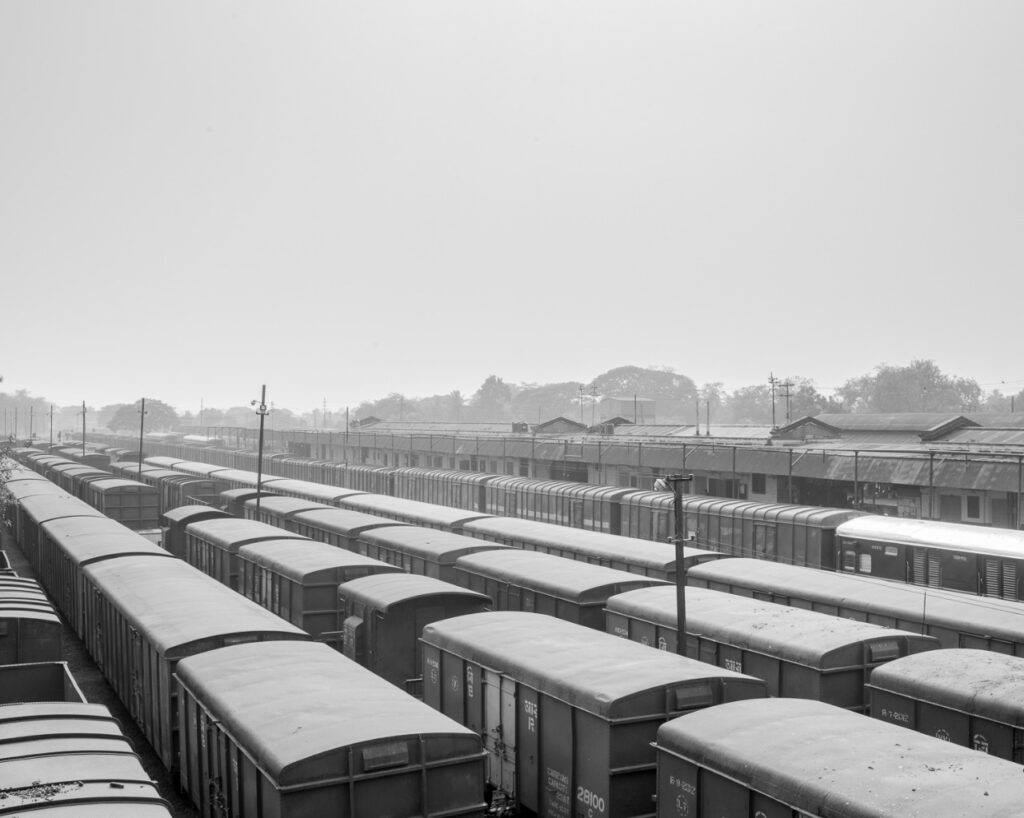
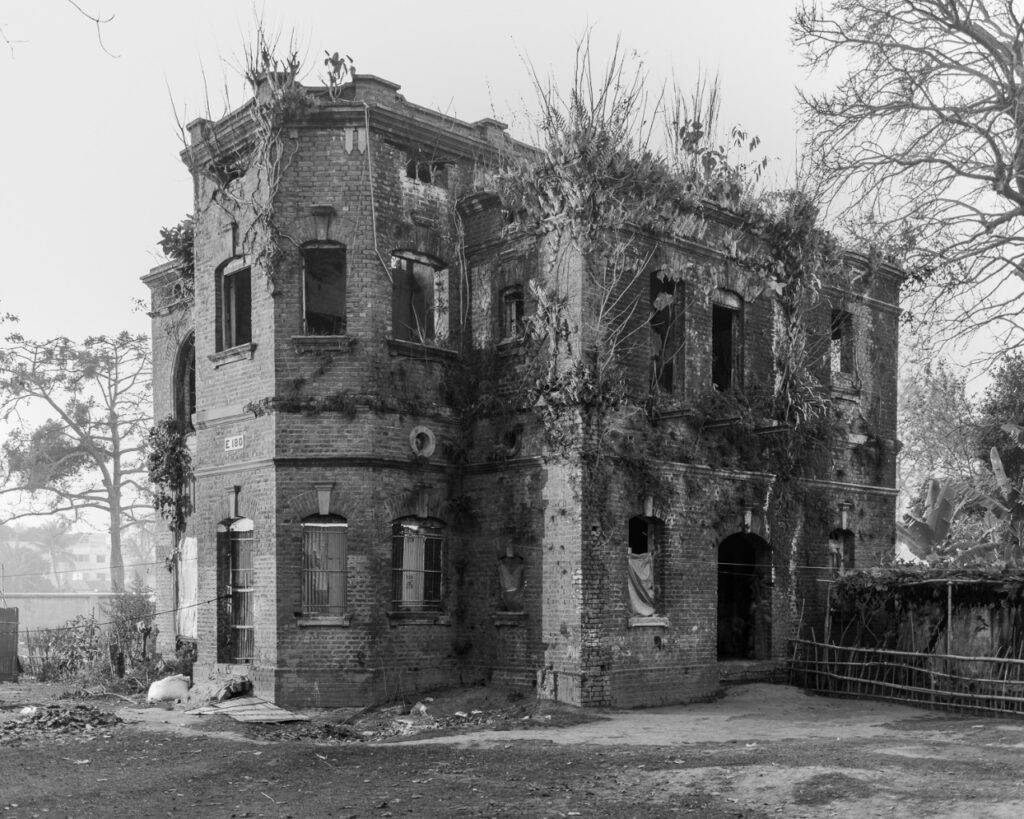
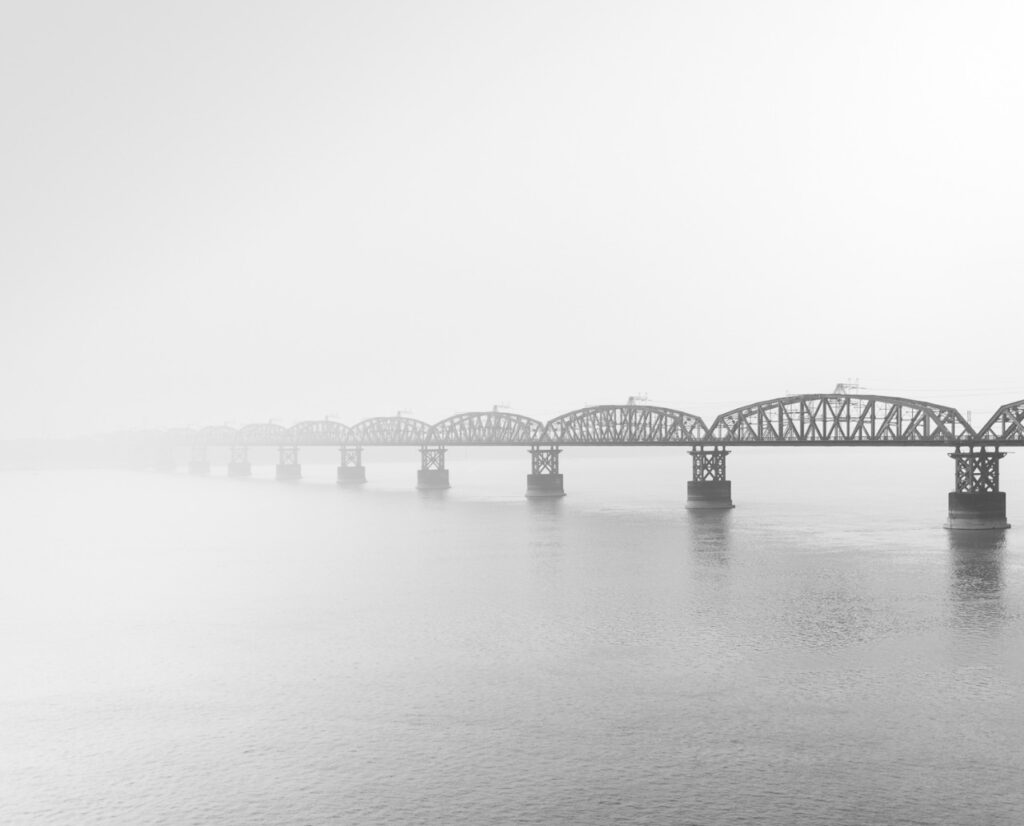
These photographs by Sarker Protick capture for me something of that old time of what we were talking, although they were taken some time in 2018-19.
We took a real roundabout route to Pabna that evening, first going by bus to Bogura and another bus to Pabna. We would stay with Moti’s cousin Shariful Islam Bablu that night. Then the next morning folklorist Uday Shanker Biswas came to meet us from Rajshahi; we had met on our first Naogaon trip. We all set off for Sujanagar, Mansooruddin’s home, where Moti’s cousin Babul Mandal lives now. The women of the house had cooked a huge meal for us while Babulbhai told us stories about the Padma river.
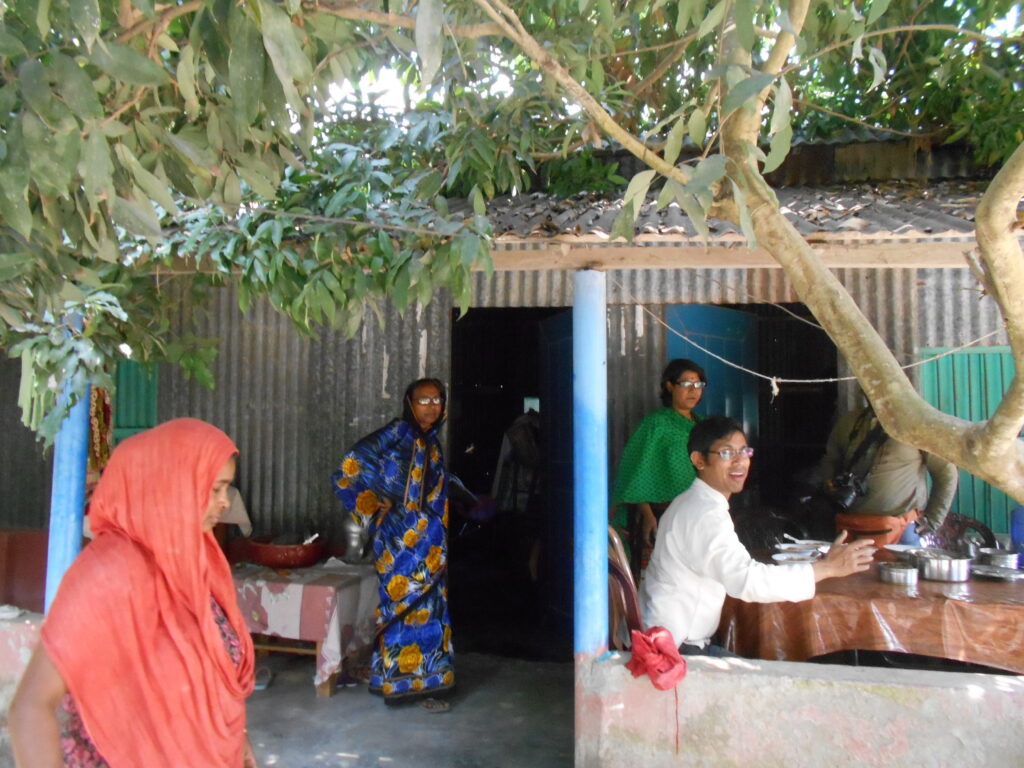
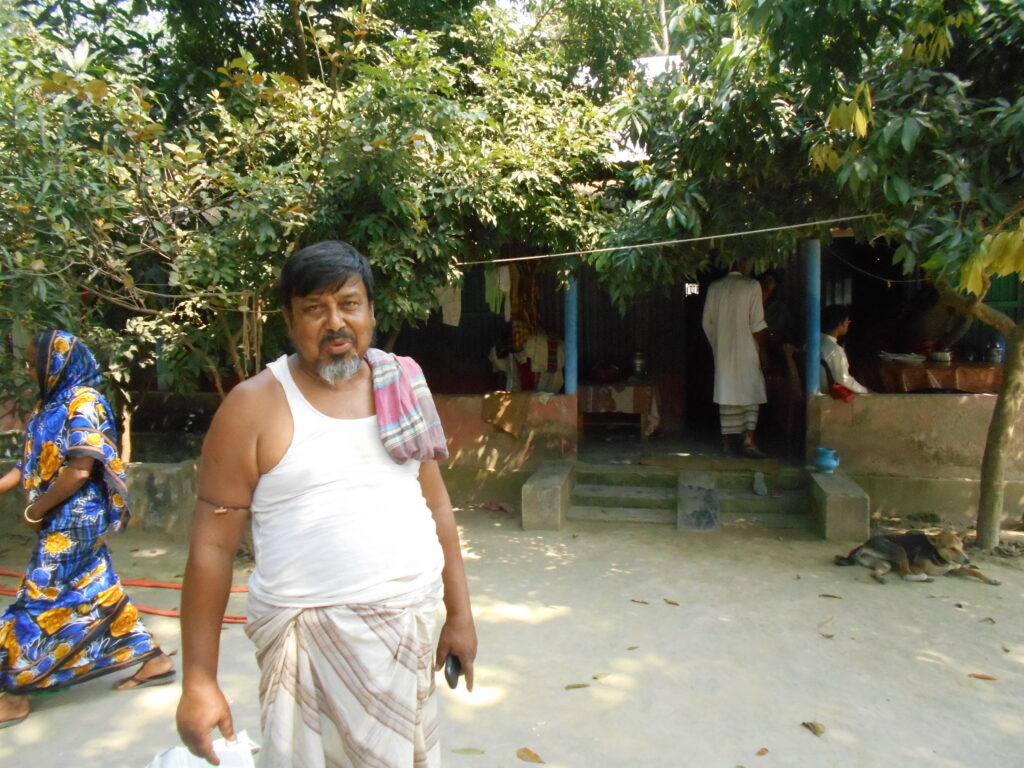
And we went to see Mansuruddin’s grave.
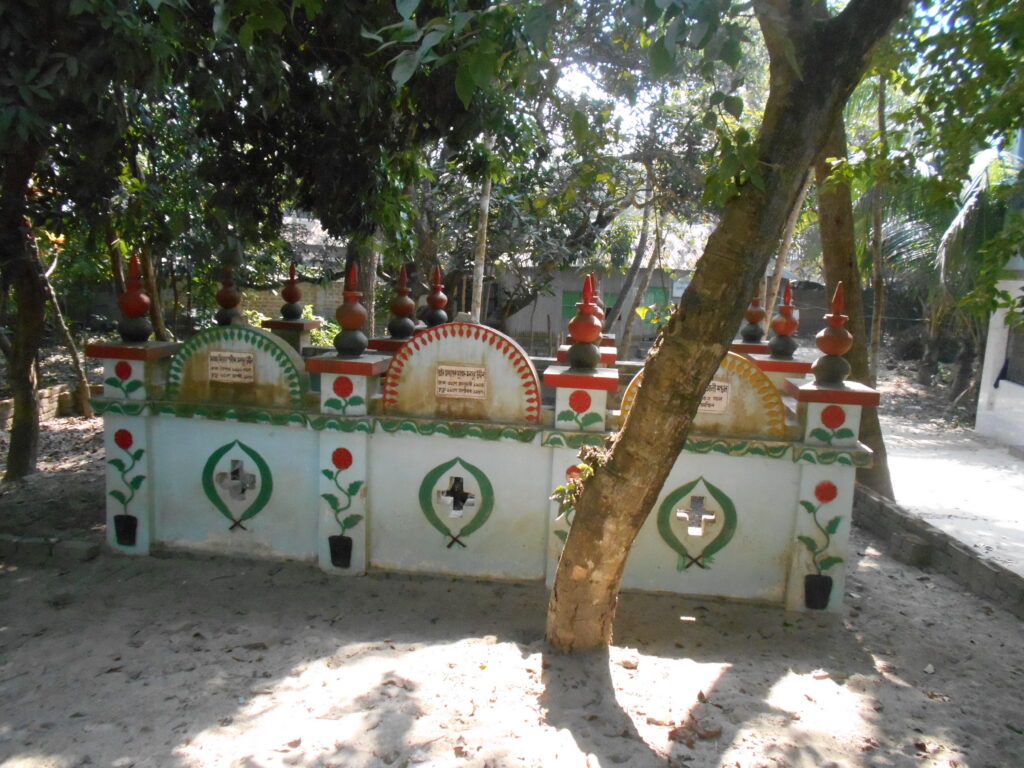
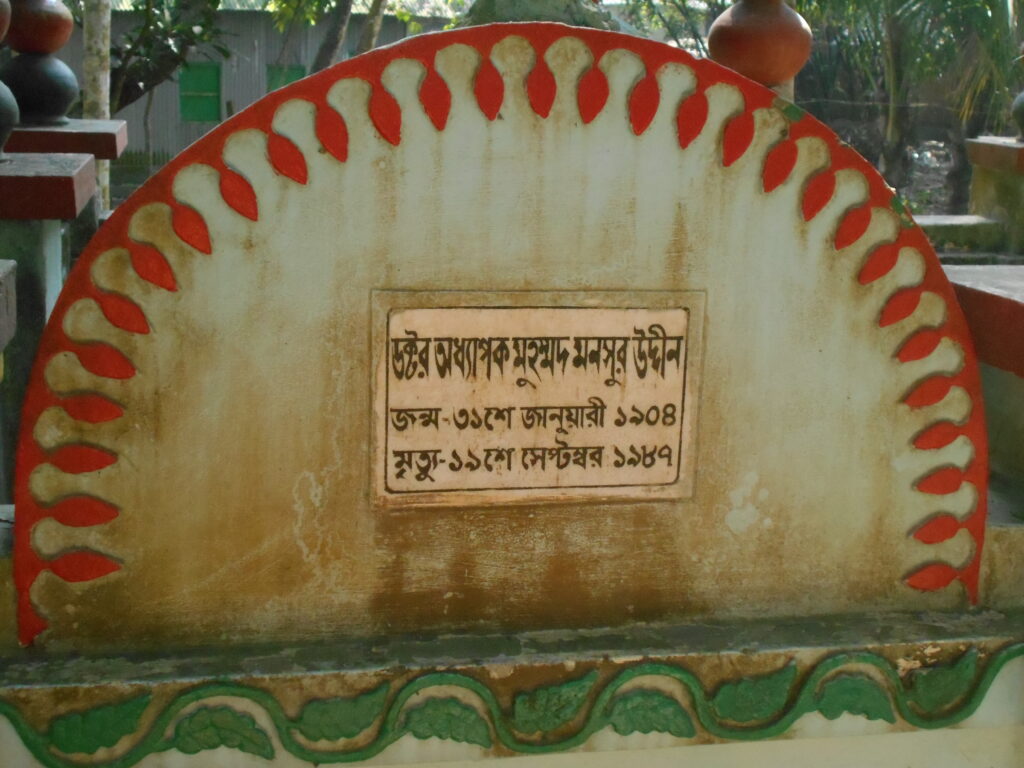
From here Uday, Moti, Oshin and I went to look for a place in Sirajganj by the name of Bordul, which was in Pabna once, and which might have been my father’s village, but found ourselves amidst green fields and broken tracks. I could not find any trace of my father’s village, but tried instead to listen to the way people talked. Had my father stayed on here, would he too have talked this way?
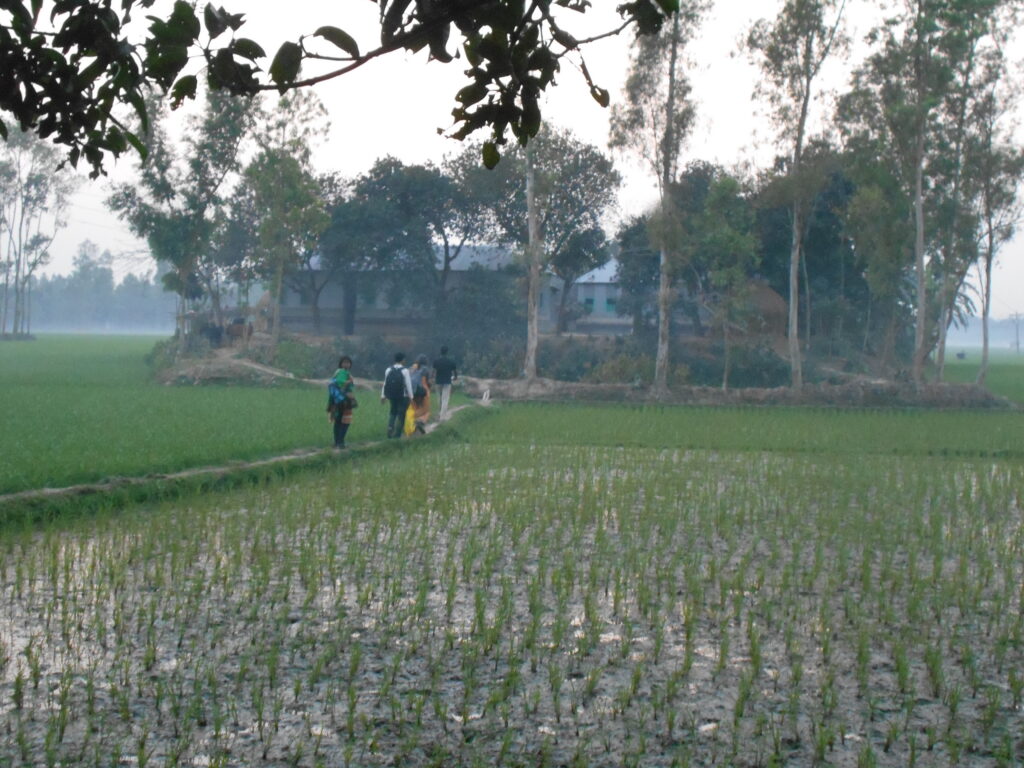
There was Arnold Bake’s footage of kirtan that we had taken to show to the kirtaniyas of Mainadal in 2014 and the then oldest singer of the Mitra Thakur family, Sri Manikchand Mitra Thakur (died 2018), had said that perhaps the singers in Bake’s film were from Muluk village (not far from Bolpur-Sriniketan). Musicians are seen playing multiple instruments including the shinga (the S-shaped horn) and shanai (shehnai), and a violin and khol (clay drum played with the hands) and dhak (played with sticks), and it looks like a veritable orchestra. There are singers too.
The Arnold Bake archive catalogue of the Berlin Phonogramm-Archiv gives the following details for Cylinders 76-79:
76. Mongoldihi, Nov., 1931.
Kirtan (tal Lopa.) Rag jhingit
77. idem. One Shannai, tal lopa, rag jhinjit
78. Kirtan idem.
79. idem. Instrumantel. 3 shannai, one khol, one cymbal
Could this film be from Mongoldihi? Could these songs be from the same place, recorded on the same day?
When we launched this website in 2011, we had this film from ARCE , we did not have enough knowledge to judge the opening lines: ‘Kirtan music in honour of God Krishna by low caste villagers’. Yet, these instruments did not seem to corroborate with our own limited the idea of the sound of kirtan. Hence, we superimposed our own judgment on the footage: ‘…this does not look like kirtan. Even Bake’s own recording of kirtan does not match the instruments shown here.’ I am not erasing that subtitle now, in 2021, as it shows something of my way of working–going to the same place and same song and same archival recording over and over, because that is the only way for me to learn and correct past errors. I have uploaded the film here again, this time the version I had from Amy Catlin-Jairazbhoy, with Bake’s opening statement inverted.
The reason I could not see this footage as Mongoldihi’s is because I had not heard the Mongoldihi recordings, even till the time of my visit to Mongoldihi. What I had from ARCE for cylinders 76-79, and what I also have from the Berlin Phonogramm-Archiv are recordings from Nepal (I think) instead of the kirtan and so some mix-up has happened somewhere along the line. The British Library opened their listening platform after 2016, perhaps in 2017, and now the actual Mongoldihi recordings can be heard here. Click on 11/31 and you will find a range of sounds—the shinga and the Santal flute and kirtan—and you can feel the presence of the many people who were part of Arnold Bake’s field that day on 26 November 1931. Not just the people we see in the film, but others too. About this day he later wrote to his mother: ‘We were too tired to go out in the evening. The next morning started with a performance before the magistrate; first by school children, then all kinds of musicians, singers and instrumentalists, with whom I was occupied until about one o’clock. I got six cylinders worth of material, if I’m not mistaken, and a bit of film too.’ So this indeed is that film that we are seeing.
In his letter of 26 November, he also wrote: ‘Wednesday evening was the great procession. The statues of Balarama and Krishna were carried out of the temple with music and song and taken to a little place …[which had been prepared for their landing]. There they were put down, and the conch was blown, while fireworks were lit to celebrate and honour the deities. Mr Datta [Gurusaday Datta, the then District Magistrate] could get very close, and we were allowed to get close all over, much closer than we have ever dared ourselves. There was a hell of a crowd on the way, but not as much as the other years, because this year the country has just been decimated by malaria. Mongoldihi was only at half strength, and just yesterday we heard that in Surul fifty people had died. [Here the poor] People have very little resistance.’ (Translated from the Dutch by Jan-Sijmen Zwarts). Bake was describing the Raash Utshob.
We heard stories about the tradition of Raash Utshob in Mongoldihi, the tradition of the music, the shinga players and where they came from, the Santal flute, and dance and what has become of the place now. I went to Mongoldihi on another 25 November, 84 years after Arnold Bake. I went with the painter Milan Mitra Thakur, whom we first met in Mainadal the previous year and who had by now become someone I could call anytime and ask for clarification and advice—a mentor of sorts. Also someone who was emerging as their own archivist (See how Milanda is taking a leading role in gathering recordings and other material related to the Mainadal Mitra Thakur family’s heritage). Many of the photographs of my Mongoldihi trip were taken by Milanda.
Sukumar Banerjee, Diptendranath Narayan Thakur, Samitendra Narayan Thakur and others talked about their Raash Utshob in Mongoldihi. They also talked about the spontaneous participation of the Santals in the festivities in the past, their flute sounds, and how some of that spontaneity is now lost, giving way to caution.
They talked about their house deity and showed the family tree. Milanda poured over this genealogy chart with Sukumar-babu. It reminded me of Mainadal and how they sing their ancestors’ names at the end of their Nandotsav festival.
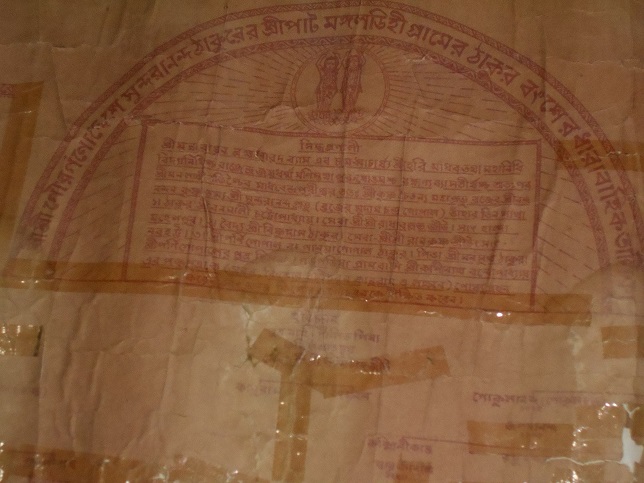
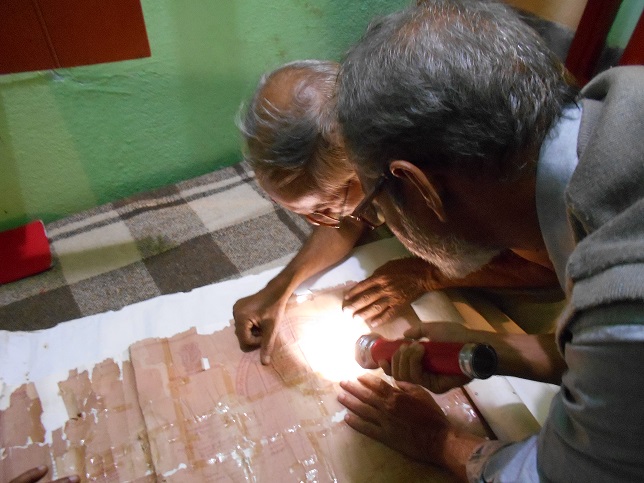
Then we watched Bake’s film together.
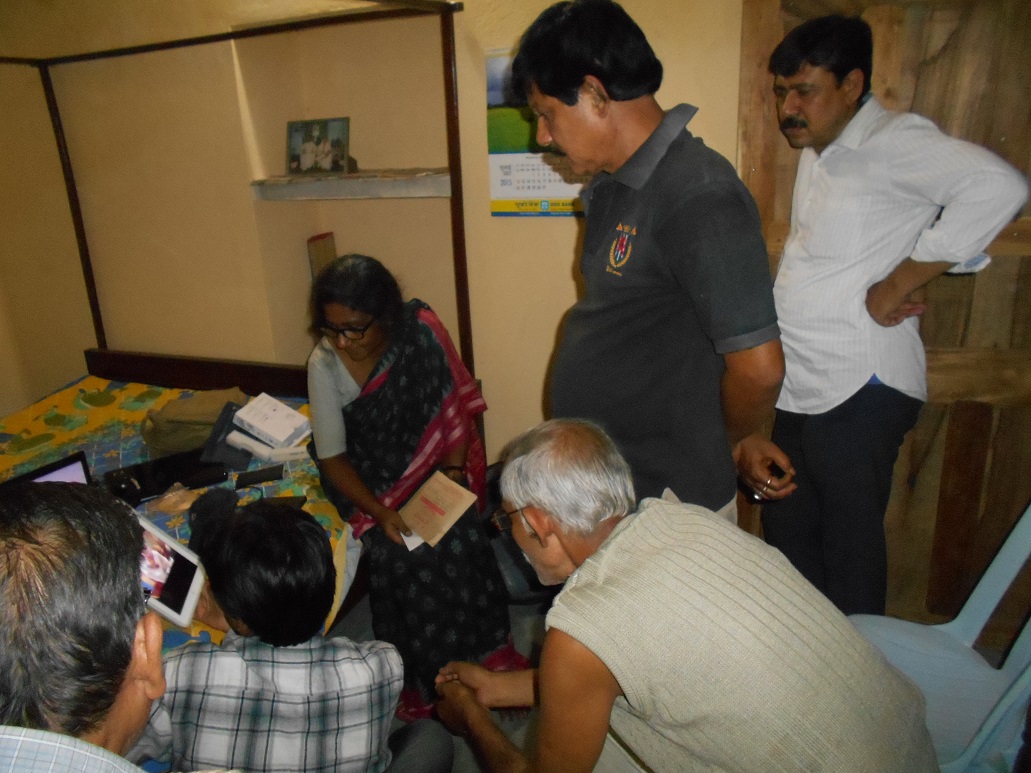
Watching Bake’s film with the Mongoldihi family. Photo: Milan Mitra Thakur
The Mongoldihi people were excited to see the musicians and the musical instruments, but they were disappointed that none of their ancestors had been filmed.
Music and conversation with musicians Dhiren Das, Dhorai Das, Manik Das. Dhiren Das said his family had been playing at Mongoldihi’s Raash Utshob for generations.
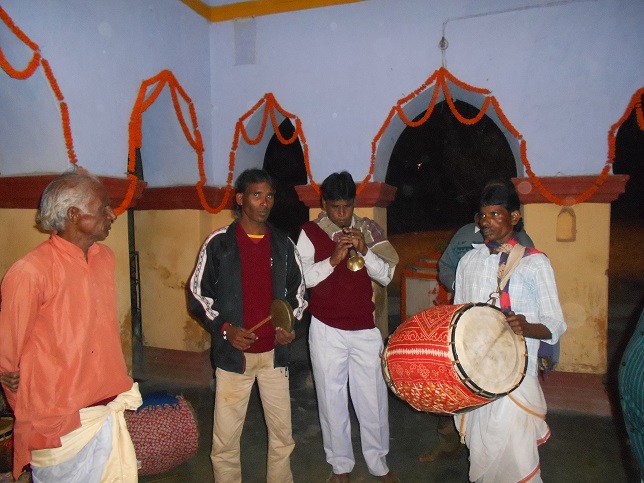
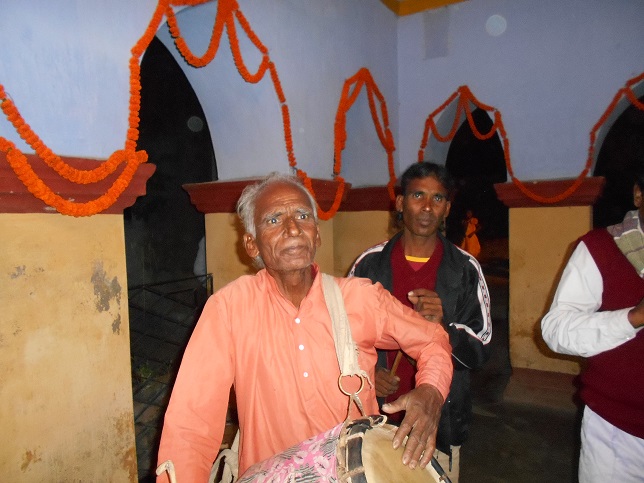
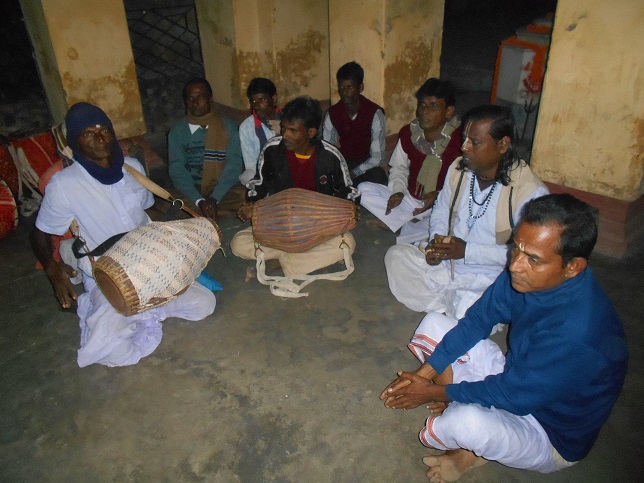
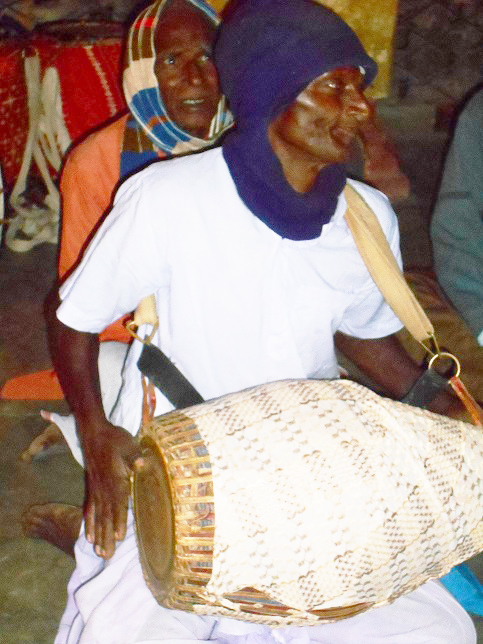
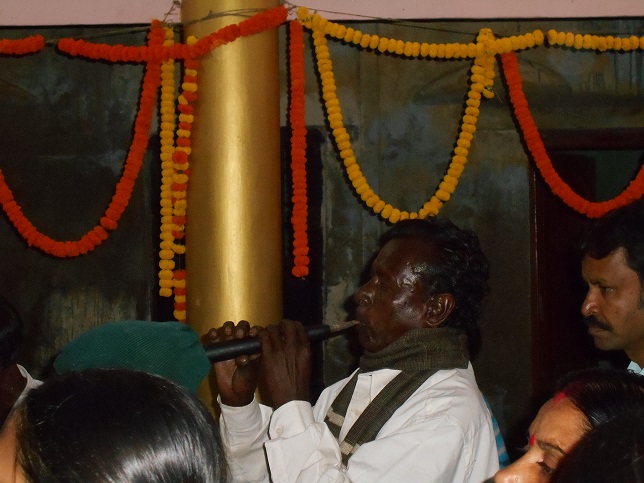
Some faces bear shadows of the faces in Bake’s film
The conversations in Mongoldihi happened before the main festivities began. Then Milanda and I went roaming to see the mela.
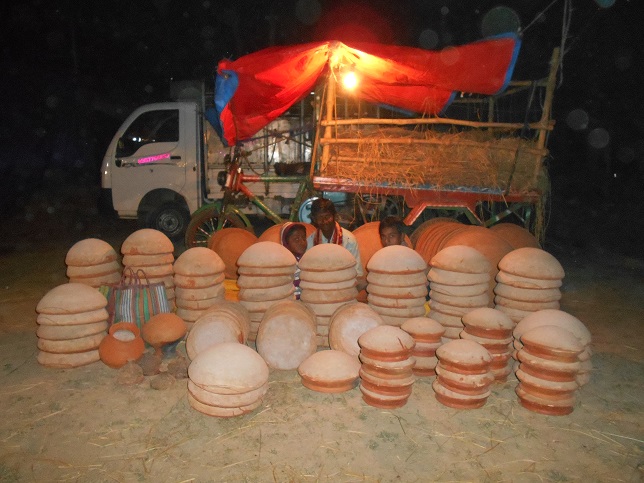
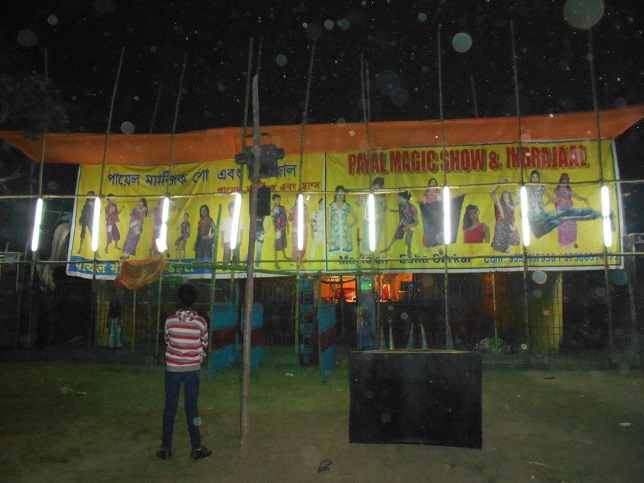
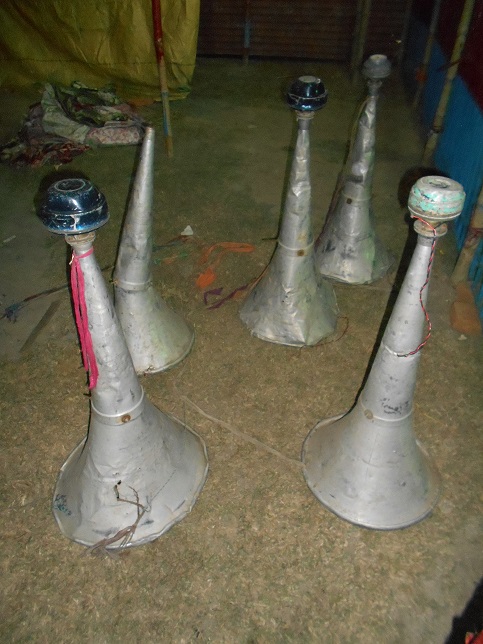
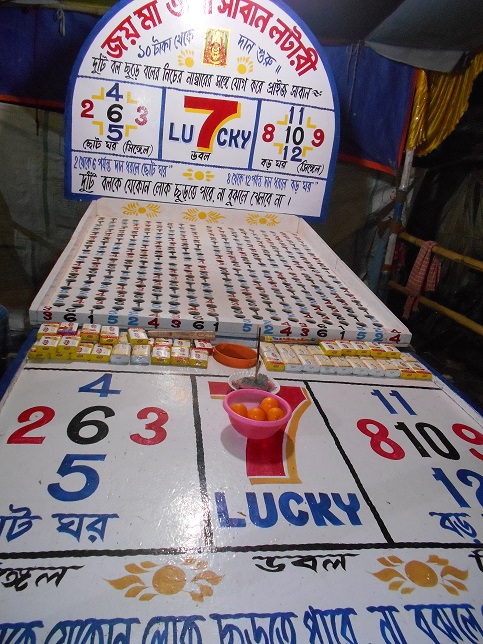
Then the gods were taken out and crowds of people walked in a procession, much like Bake’s description in his letters.
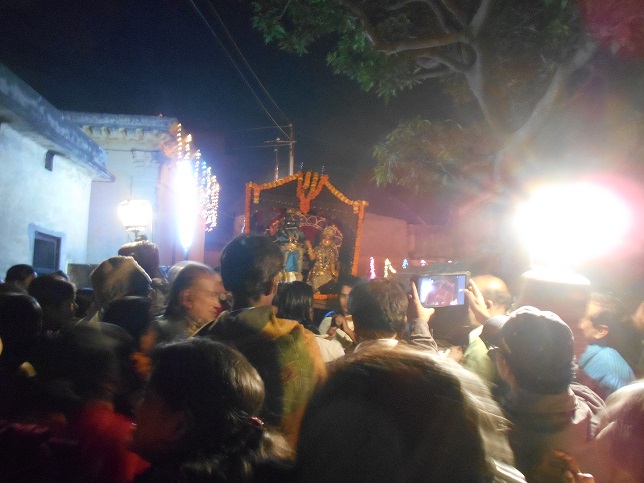
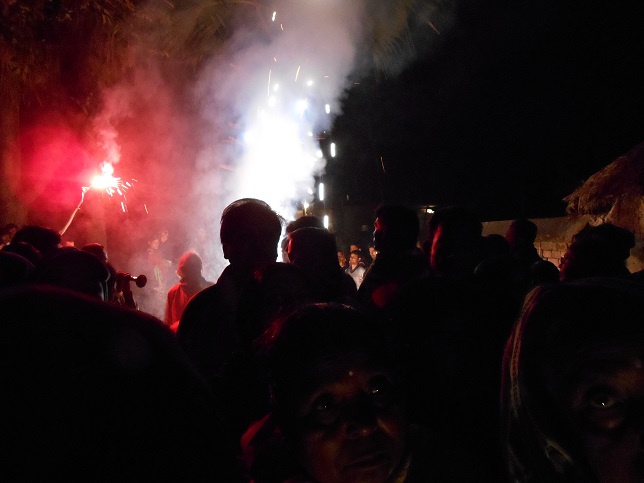
It was in 2015, while researching for The Travelling Archive in East London exhibition that I came across two recordings of Arnold Bake from 1956 which were from Bengal—there were two more recordings from that trip, which I did not notice till 2018. To those I have dedicated another sub-chapter.
The artist’s name for item number C52/NEP/70 C1 was Chitra Chaudhury. According to the accompanying archival note, she recorded a Tagore song for Arnold Bake in Santiniketan on 7 March 1956. C52/NEP/71 C1 was marked as a Tagore song sung by Indira Devi Chaudhurani, recorded on 10 March 1956. The place of recording for Indira Debi was given as Nepal, but that was obviously an error; I assumed this would also be Santiniketan, because I knew that Bake was visiting old friends in Calcutta and Santiniketan at the time.
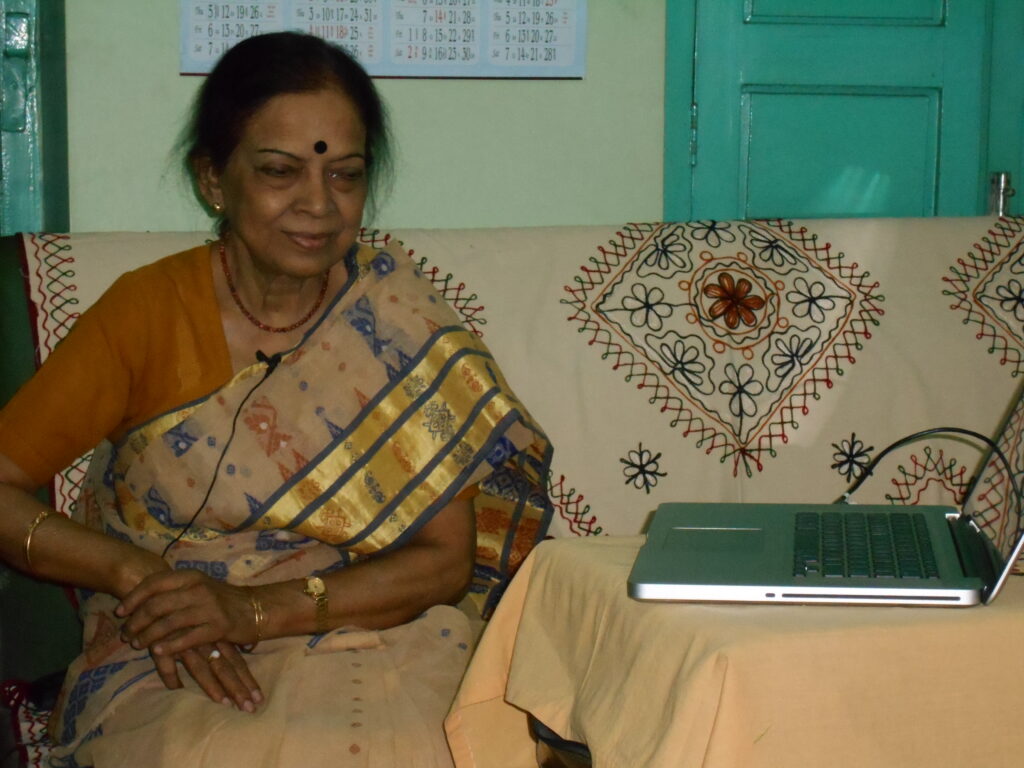
Chitralekha Chaudhury in her home in Sinthi, Kolkata on 16 November 2015.
As with many of the other Bake recordings, it was the archival note which came to me before the sound; hence, speculation began from the text. Could Chitra Chaudhury be the renowned Tagore singer Chitralekha Chaudhury is the first thought which crossed my mind. When I listened to the recording, I felt I had probably guessed right. In the recording, the singer is young, so I had to make some more inquiries before I could be certain. After the exhibition in London in June-July 2015, I returned to Kolkata and sought out Chitralekha Chaudhury. She was my old friend, also a singer, Nabanita Chattopadhyay alias Tuku’s teacher, so I asked her to find out if her guru remembered ever being recorded by Arnold Bake. Tuku said Chitralekhadi was keen to meet me and so sound recordist Sukanta Majumdar and I went to her home on 16 November 2015. The recordings of that evening in Chitralekha Chaudhury’s home were all made by Sukanta, the photos were taken by either of us. Chitralekha’s daughter Patralekha Reena was also present and we all listened together to the 1956 recordings of Arnold Bake and other recordings too. The recordings were keys to long-unopened vaults of memory. Chitralekha was listening to herself and remembering the day of the recording, her painter mother, Chitranibha, life in Santiniketan, old teachers and so much more. Those days people mostly called her Chitra; in 1956 she was a student of the secondary school of Visva Bharati, Patha Bhavan. Her mother, the painter Chitranibha Chaudhury, was among the early women graduates of Kala Bhavan, who also taught there later. ‘She was the first lady professor of Kala Bhavan,’ her daughter said with great pride.
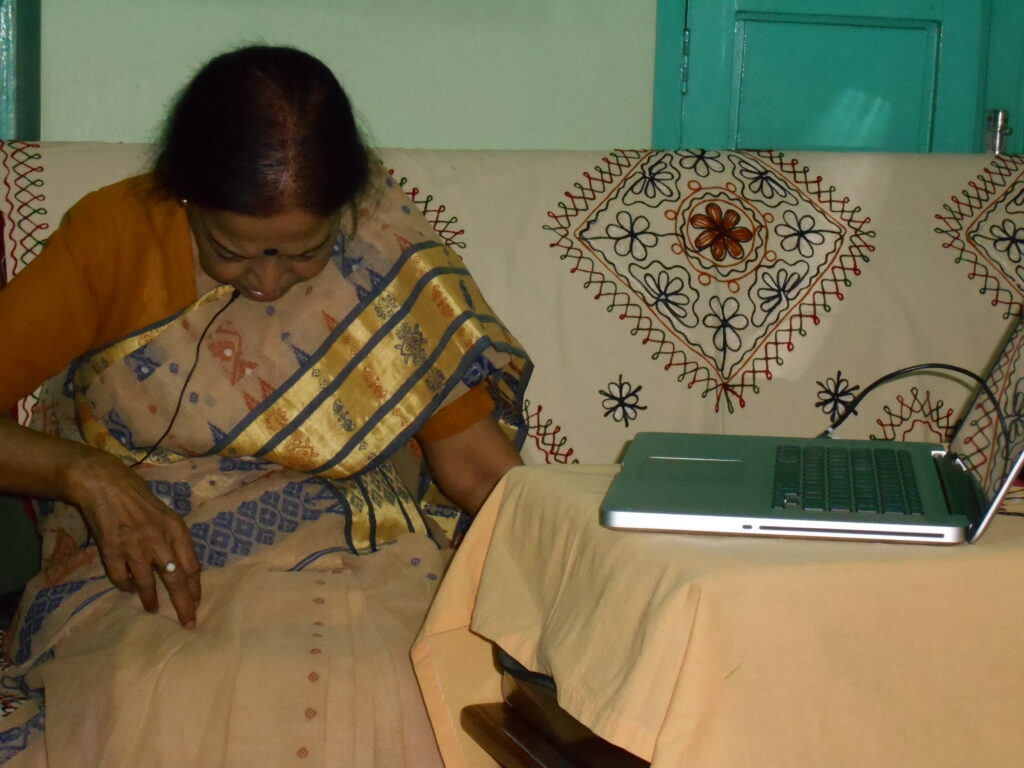
Chitralekha Chaudhury listens to her song, ‘Amala dhabala paale legechhe’, and she begins by talking about how this was the song she would often sing in those days. Born in 1940, Chitralekha was fifteen going on sixteen at the time of the recording. She talks about early music lessons in Santiniketan from master teachers and how her mother made every effort to arrange for the best music education for her daughter. She sings a few lines of the song she had sung as a child for Allauddin Khan, ‘Jago jago’, when the master came as a visiting professor to Visva Bharati. She recalls the transcendental quality of his music and the depth of his sadhana and his total humility as a person. She especially mentions a performance one autumn evening where the master sat and played for over two hours, his white robe turning green as seasonal flies landed on him and bit him to their fill. The artiste was totally impervious to such mundane matters; after his performance the lord stood up and shook the flies away. Chitralekha also remembers the singer of the Bishnupur gharana, Gopeshwar Bandopadhyay’s visit and how he gave her individual lessons because she was too small to learn in a group and how he slowly prepared her to sing with him during performances. She recalls her ‘guru bon’, fellow student of Gopeshwar Bandopadhyay, the famous Hindustani classical singer Malavika Roy (later Kanan), already on her path to fame.
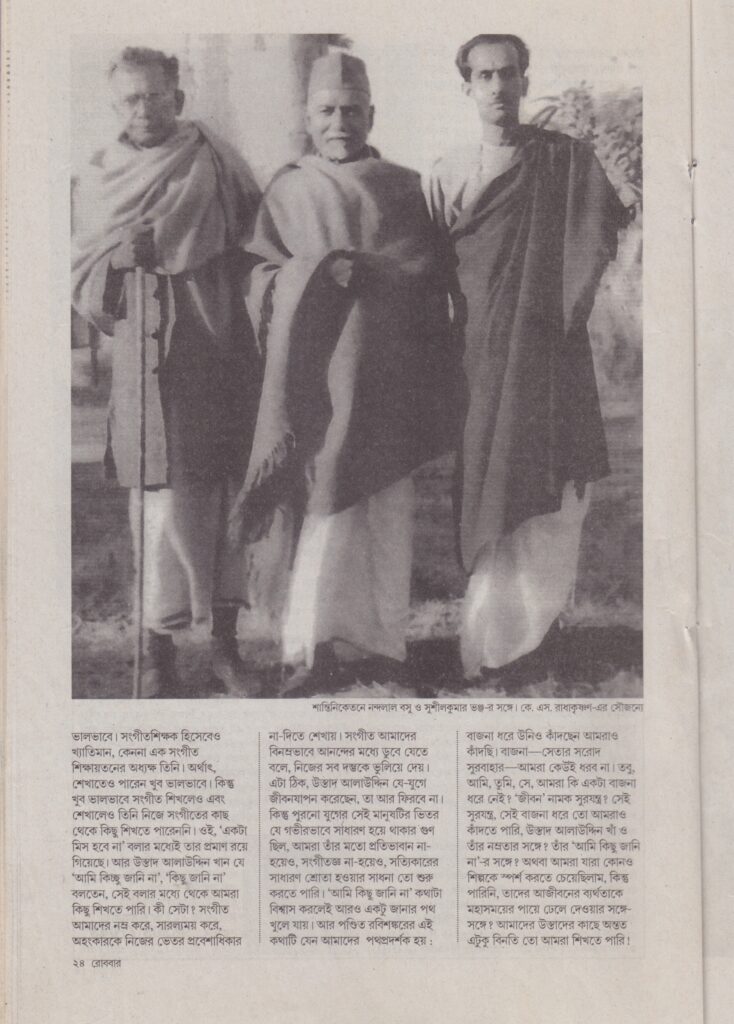
Allauddin Khan in Santiniketan, with the painter Nandalal Bose on his right and Tagore singer Sushil Kumar Bhanja on his left. Scanned from Robibar, the Sunday magazine of Sanbad Protidin, 2 March 2015 (Kolkata: Protidin Prakashani Limited, 2015), p.24.
Chitralekha tells us the story of how her mother was married, how Chitranibha’s in-laws recognised her potential as an artist, and how they believed that in the struggle against British rule, women would play a vital role, so they had to be prepared for it. That is how she came to Tagore’s school in Santiniketan to study at Kala Bhavan with Nandalal Bose and others. She also learned to sing from Dinendranath and Rabindranath himself.
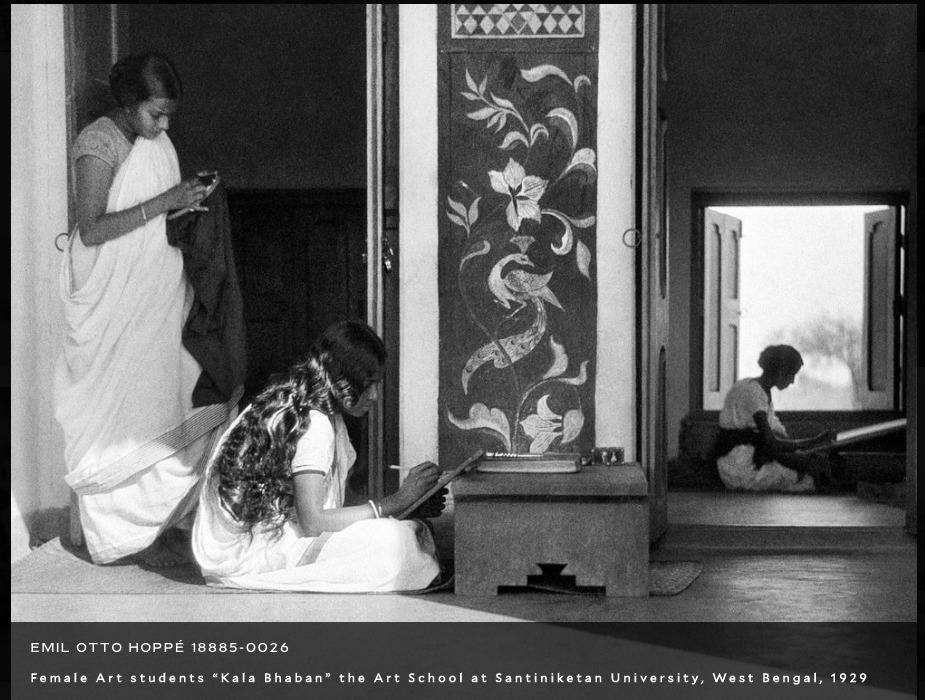
This photograph is from E. O. Hoppe’s book, Santiniketan; it was on the cover of the book. The photo was taken in 1929 and it struck me that one of the unidentified women could be Chitranibha Chaudhury. As we hear in this telephonic conversation on 12 February 2022, Chitralekha, has identified the woman with flowing hair and shankhaa (conch shell bangles), sitting on the floor, as her mother. Image source: Internet.
Chitralekha continues to tell her mother’s story. How her mother had to regularly report to Rabindranath about her progress. She would go and show him her work. One day she took a design of a rectangular frame, with nothing inside. Rabindranath said, why this empty space? Maybe you should write a poem. She said, but I can’t write poems. He said, then leave it on my desk. The next day she went and found that Rabindranath had written a beautiful song about blindness and the awakening of sight to fit her frame.
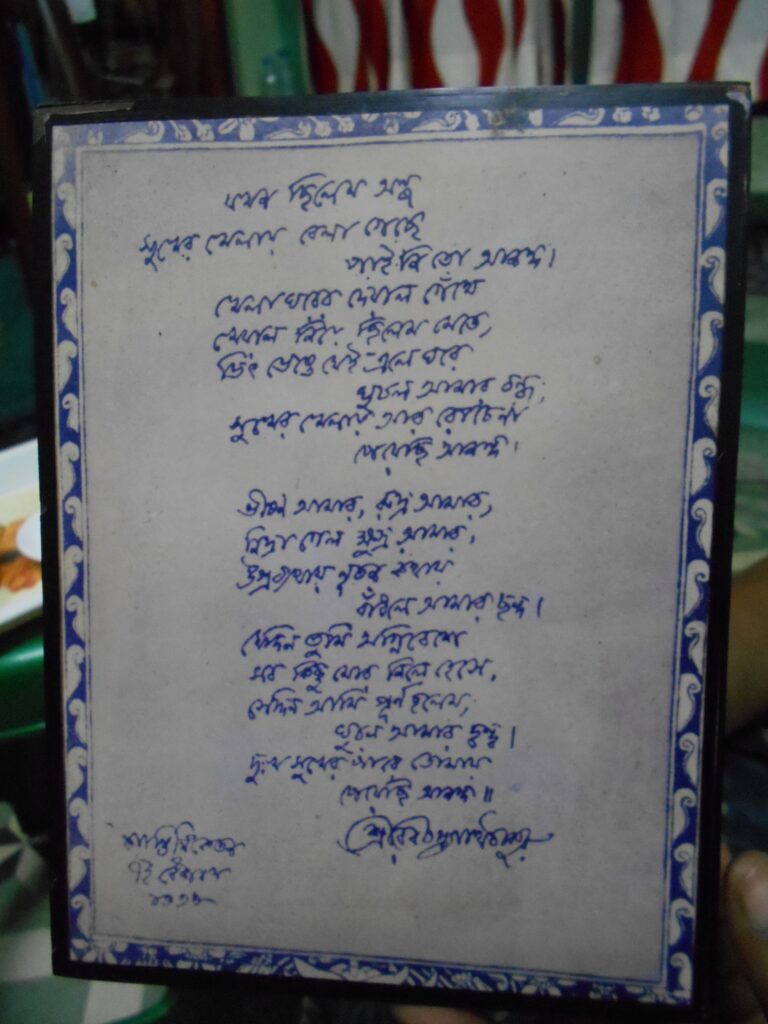
Chitralekha talks about their family estate in Lamchor village in Noakhali, now in Bangladesh. This was a prominent zamindar or landowning family. On her father’s side of the family they were all scientists and educators, they had set up schools in the village, their house was like a boarding for students who were also trained in rifle shooting, because they would have to fight the British. Her father, Niranjan Chaudhury, was a member of the Anushilan Samiti. She said, later that training came to use during the communal riots of 1946. All around them there was killing, arson and looting, but their lives and property were saved. Chitralekha tells us how her mother went home to her in-laws after five years in Santiniketan and the house seemed like a hostel to her. Chitralekha also tells us how her mother’s original name was Nibhanoni but Rabindranath changed it to Chitranibha, because she was such a good painter. That is the name she came to be known by later.
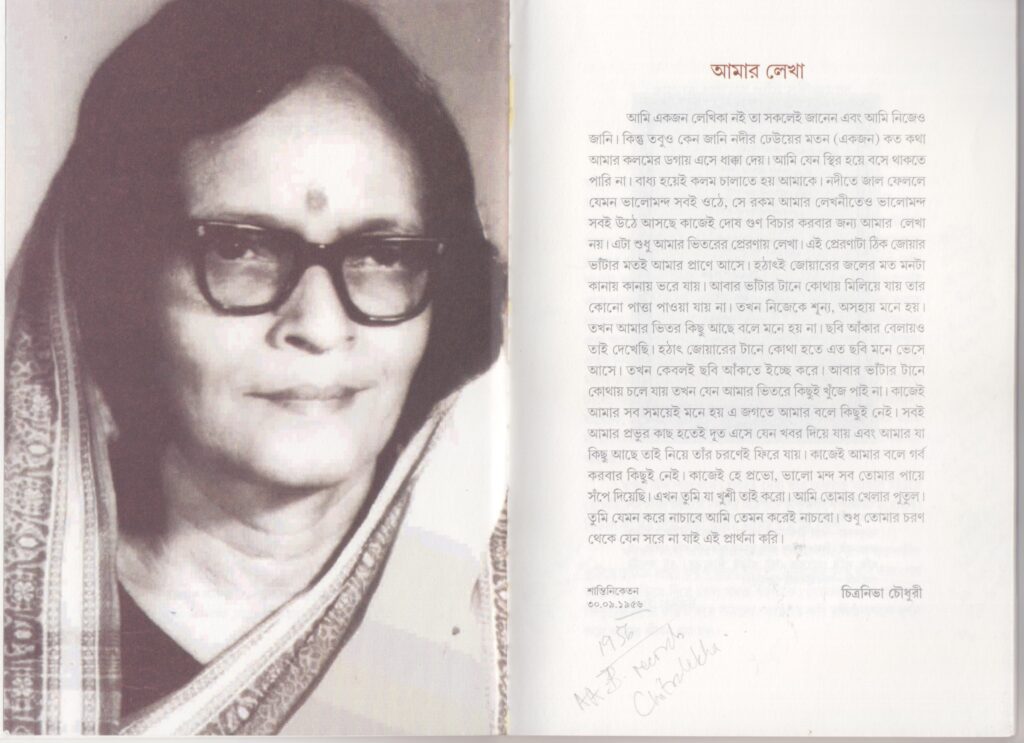
Page from Chitranibha Chaudhury: Smritikatha (Kolkata: Rajya Charukala Parshad, 2015)
Chitralekha briefly mentions the fresco that her mother had painted in her uncle’s house in Dhaka. Chitranibha’s husband had studied mathematics and his elder brother, Chitralekha’s jethamoshai or uncle, Professor J. C. Chaudhury, was head of department of chemistry of Dhaka University. The fresco in question was painted in his house. This fresco and its disappearance have slowly come to hold metaphorical meanings for me in my research, symbolising history buried under history, but we will come to that later. For now, Chitralekha goes on to talk about the riots in Noakhali, about how Gandhi had stayed in their house after the communal riots of 1946. Her father, Niranjan Chaudhury’s room was where Gandhi had stayed, she says, her uncle’s room (I believe she meant her uncle Manoranjan Chaudhury, who was a friend of Gandhi’s) became his private secretary’s office (Chitralekha could not recall the name, but of course she meant Nirmal Kumar Bose). She says, the memory of the riots was too bloody, which is why she has never been able to go to Bangladesh.
As I was listening back to these recordings in 2021, I realised that there were some gaps in my understanding of the Lamchor Chaudhury household, of Chitralekha’s father Niranjan Chaudhury’s circumstances and so on. So I called Chitralekhadi and we spoke on the phone about things. It is interesting to think how memory works. She repeated some of the things she had said in 2016, such as her mother proposing to her father that maybe they could think about exchanging their Noakhali house with her friend Firoza Bari’s in Park Circus, Calcutta. Her father had apparently said, are you crazy? This is all temporary, Hindus and Muslims will come back together again. And then she told me again on the phone how her father really did not want to come and how Gandhi had said to them that you must not leave and how he finally said. ‘I can part with one of my limbs but I cannot part with my party.’ Whether or not this is historically accurate is not for me to say, but this is how Chitralekha knows and tells and retells her own history, the history of her family as well as the history of a nation.
Conversation with Chitralekha Chaudhury on the phone, 31 May and 1 June 2021.
This is again from 16 November 2015. Chitralekha Chaudhury tells us the story of how this elaborate fresco that her mother had painted in the house of her brother-in-law, Professor J. C. Chaudhury, in the late 1930s after she had graduated from Santiniketan, was finally ‘lost’.
When Partition was imminent, Professor Chaudhury exchanged his property in Dhaka with a family in Calcutta. Apparently, when leaving the house and the country, he had told the new occupants to look after Chitranibha’s fresco. ‘Murals are not just paintings or relief on the wall; they generate in the building or its surroundings a new kind of vitality. Their role, therefore, is organic, not ornamental,’ K. G. Subramanyan had said. There are many styles of mural painting; fresco is one of the toughest, as artist and scholar Professor Nisar Hossain, who has written on Chitranibha’s lost fresco, was explaining to me. The fresco of Chitranibha in Dhaka became shrouded in mystery after Partition—people talked about it; Chitralekha and her mother heard stories about it from visitors from Dhaka. Meanwhile, the house changed hands again. Parallel to these happenings, Nisar, who teaches at Charukala, the art school of Dhaka University, had set out on his own journey to find this bhittichtro or fresco, of which he had heard so much. The house was located on 12 Topkhana Road, Segunbagicha, Dhaka. He reached it through a circuitous route and the journey was not easy. The room with the fresco was found—it used to be a large hall, according to earlier descriptions, but now it had been partitioned and it was the office of a company which sold water pumps. The room with the painted wall was now a storage piled with boxes to the ceiling. The wall with the painting was found, but problem was that it had been whitewashed.
Caption: While the walls of the house with the mural have now been whitewashed, these faded photographs of the mural which lie behind the white wall have been shared with me by Nisar Hossain. Nisar had these from Abdul Hamid of Bitopi advertising agency, who were working once on a calendar project on Dhaka’s murals (I do not know if the calendar was printed. One panel bears the signature of Chitranibha and the date is 7 Chaitra 1349 (BS), which would be March 1943. However, Chitralekha insists the fresco was painted before she was born. Hence the assumption is that Chitranibha had signed the mural during a later visit to Dhaka.
There were traces of Chitranibha’s village scenes behind the coating of lime and blue; there were pencil-marks still visible on the wall. On 20 February 2016, I went with Nisar to the house where the largest fresco panel of Bengal had been painted around 1939, prior to Visva Bharati’s Hindi Bhavan mural, painted by Benodebehari Mukhopadhyay in 1946-47. Nisar showed me signs of the fresco, which his expert eyes could see. Everything hinted at a history now impossible to see, but a history that lies under the surface of the obvious and the visible.
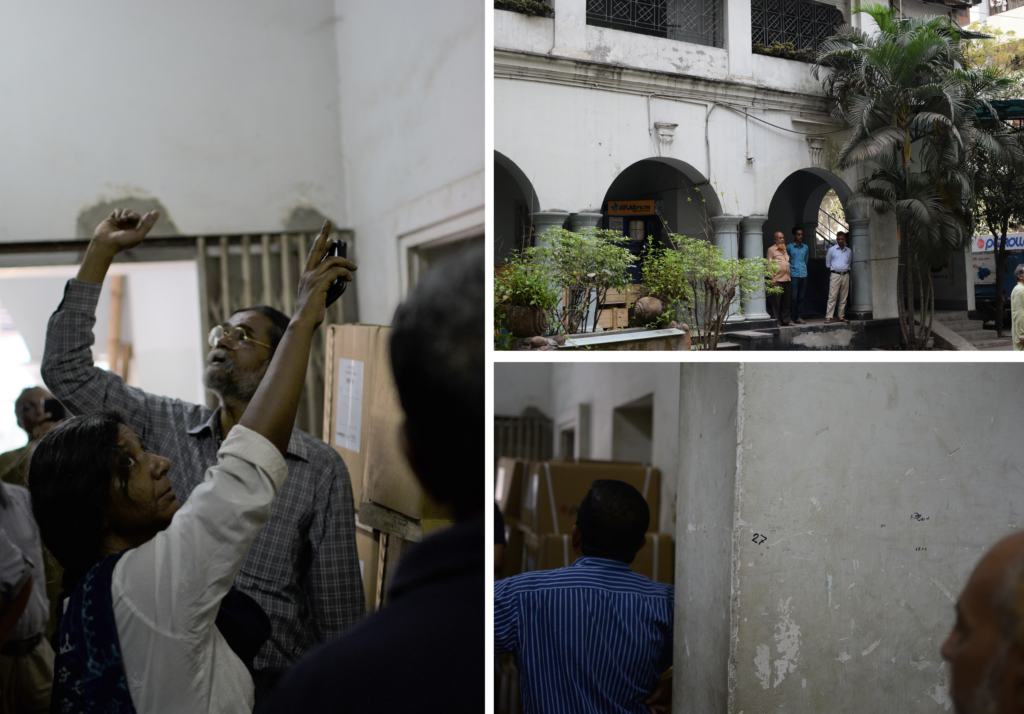
What used to be Professor J. C. Chaudhury’s house. 2016. Photos: Jan-Sijmen Zwarts
Visiting 12 Topkhana Road, Segunbagicha, Dhaka with Nisar Hossain and others on 20 February 2016. Jan-Sijmen Zwarts, a young Dutch scholar, who was staying with me at the time and helping me read Arnold Bake’s letters, had also come to Bangladesh. I made this recording on my Zoom H4N recorder.
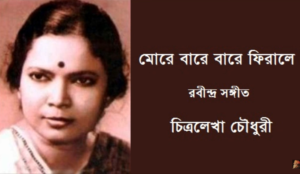
On 16 November 2015, Chitralekha Chaudhury had talked about her first album, a 78 rpm record. The Tagore songs on the two sides of the two sides of the album were ‘More bare bare phirale’ and ‘Ei je kalo matir basha’. She narrated her father’s initial objection, her mother’s encouragement, and finally how she was recording record after record and her songs were playing all the time on the radio, while she was studying for her Masters and then she started to teach in a college and went on to do her PhD and so on.
Chitralekha Chaudhury tells a funny story about how she ended up going for military training and how she carried her harmonium to the camp and so on.
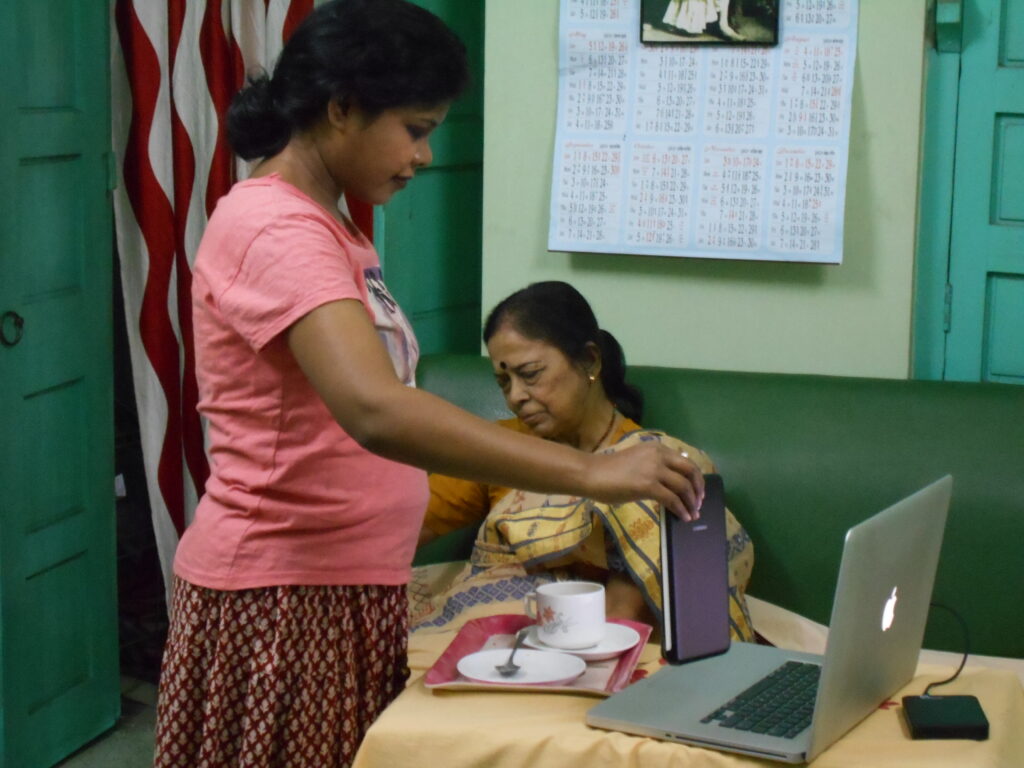
Finally, we come to Arnold Bake’s recordings, we listen again, I explain to Reena that I cannot give her a copy of her mother’s songs but she records while we play. Interestingly, after I sent Chitralekha Chaudhury’s postal address to the British Library after our meeting in November 2015, they sent her a copy of her 1956 recording with a standard letter explaining what was being given to her and how she must keep it and how she must not make further copies. Rules are rules, but we have to also find our own ways of dealing with these systems. Reena, also a singer, wanted to keep a copy of Indira Devi’s song too, and how else could she do it other than by recording on her tablet while I played the song? Chitralekha talks about Bibidi (Indira Devi) and about learning songs from her. I ask her about some of the other people Bake had recorded in Santiniketan. She tells me what she remember. Laksmisvar Sinha used to talk about the land of endless sunrise and endless sunset. Gurudayal Malik was very sweet and kind and when my little brother touched his feet and did pranam to him, he touched my brother’s feet in return and said, god lives in the heart of the children. I also play them Arnold Bake’s own recordings of Tagore’s songs and ask her, if he is singing in Dinendranath’s style? He is and he is not, she says. He is also a Western trained singer, she clarifies..
Chitralekha is married, she has gone for post-doctoral research to Laval University in Quebec and thinks she should learn some Western classical music. She goes for voice training but realises that is not for her. So, she takes to learning the piano. Then her teacher, Marie, asks her one day about Tagore and asks her to sing one of his songs. Chitralekha plays the piano and closes her eyes and sings ‘Chokher jole laglo joar’. There is total silence. When she opens her eyes, Chitralekha sees tears streaming down her teacher’s cheeks. Here was someone who had never been anywhere outside her own world of sound and listening, yet here she was so deeply moved by a song.
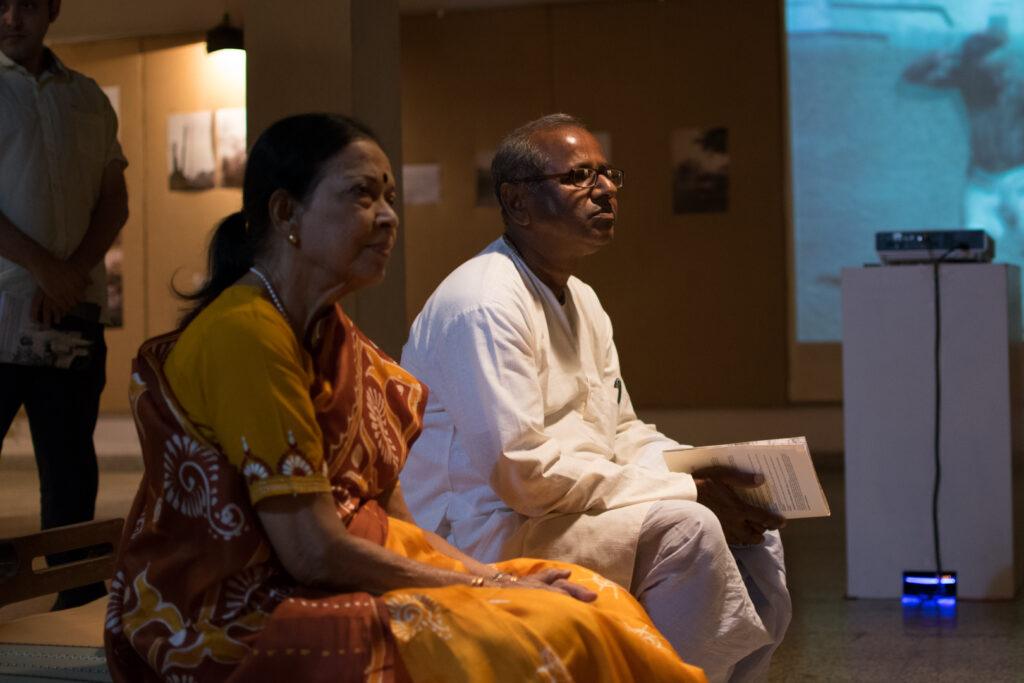
‘Time Upon time: Arnold Bake in Bengal’ is an exhibition we had in 2016 in Nandan gallery, Kala Bhavan, Santiniketan. Our main guests that evening were Chitralekha Chaudhury, who had been recorded by Bake in 1956 and Nirmalendu Mitra Thakur, whose father and grandfather and uncles and cousins had been recorded in Mainadal, Birbhum in 1933.
Arnold Bake had recorded the fakirs in Naogaon on 28 February 1932. Naogaon was a subdivision of Rajshahi district till 1984 and is now a separate district in northern Bangladesh. Bake India II Cylinders 83-94 are from Naogaon; 83-87 are names of male fakirs, 88-91 are of a woman named Jaura Khatan Khaepi, a fakirni . The rest, 92-94 are of ‘ganja workmen’ Azimuddin, Saura Ali and Komaluddin Sardar. Again, these are recordings I have heard at the British Library and ARCE, but now we also have copies of three cylinders, as we have just come back from an exhibition in London where we had some Arnold Bake recordings from the British Library as exhibits.
The word fakir is also written as fokir, even phokir in its Bengali to English transliteration, to bring it phonetically closer to both the ‘o’ sound and the closed-lip pronunciation of the Bengali letter ফ. However, Fakir is how Arnold Bake wrote, hence that is the spelling I have used to write about his work. I am also using Bake’s spelling for the name of the fakirni, Jaura Khatan Khaepi. But the name would possibly be written as Johura Khatun Khepi even at that time. My hunch is that Bake tried to write a spelling closest to what he heard and in those parts, they probably say Jaura for Johura.
Anyway, fact is that I was especially drawn to Jaura Khatan and had been musing on her for several years. Way back in 2013, the essay I wrote for the ‘La Presencia del Sonido’ (The Presence of Sound) exhibition had included some thoughts on her. She was for me the main point of this journey. Who was Jaura Khatan, mistaken as male in the BLSA catalogue notes (‘Āmi nāmāj parete jāi calo re Khaepi, Jaura Khatan (singer, male / ektara), a lone woman in a group of men whose photograph I had seen at the Leiden University library and copied with my camera?
The other intriguing point was the epithet ‘ganja workmen’. It took me a long time to work out what this meant, and that the ganja workmen were indeed people who worked in the ganja (cannabis) fields of Naogaon and that ganja was one of the main produces of the region, and what kept its economy and culture alive. By the time of this first trip to Naogaon, I had gathered some information about the cultivation of ganja in the region, but it was only after actually going there that I began to get a proper sense of the scale of its ganja operations at the time of Bake’s visit.
On this trip no one recognised the photos but the relation of the fakirs with ganja became evident. Ganja was banned in Bangladesh in the 1980s, the office of the Ganja Cooperative Society still stood in Naogaon, and its workmen managed old property and land now turned into markets and fisheries.
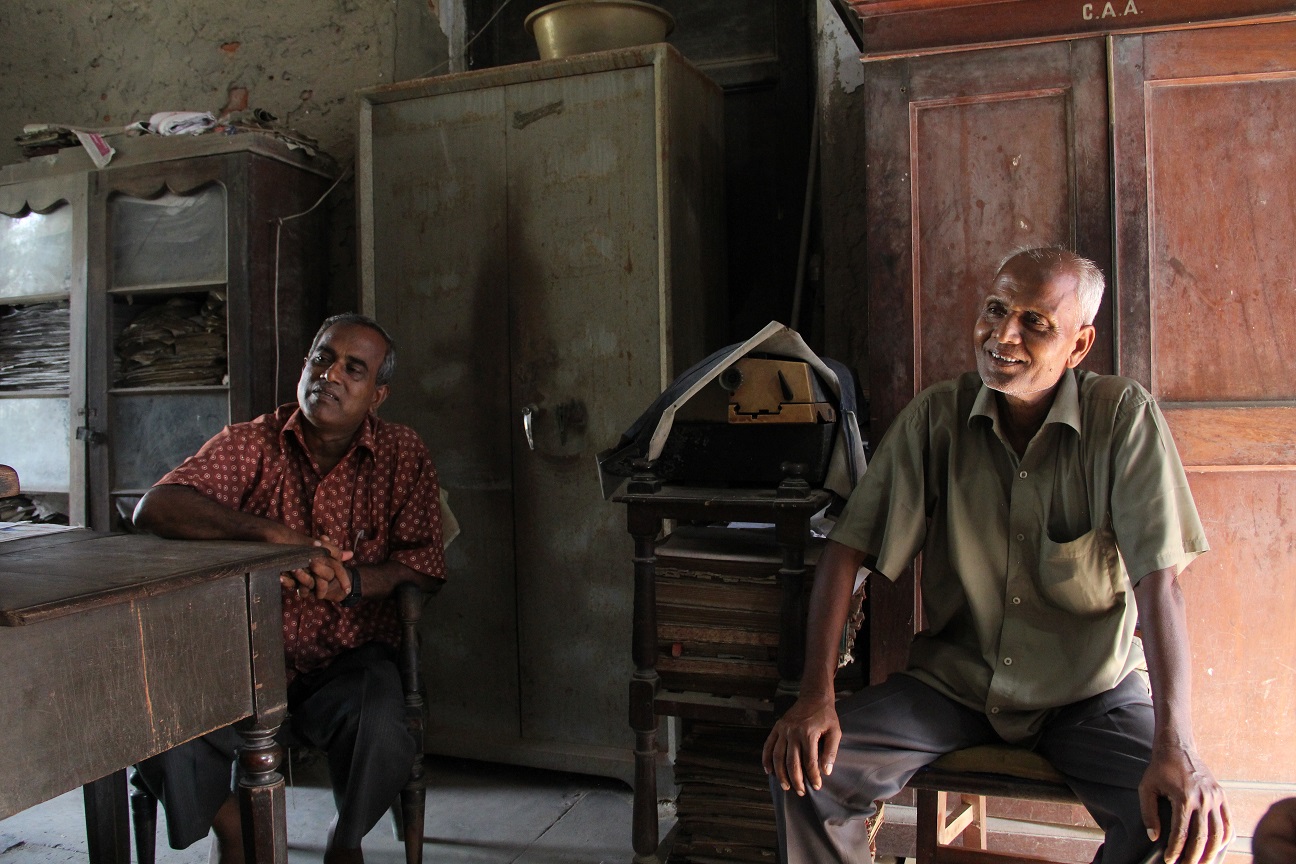
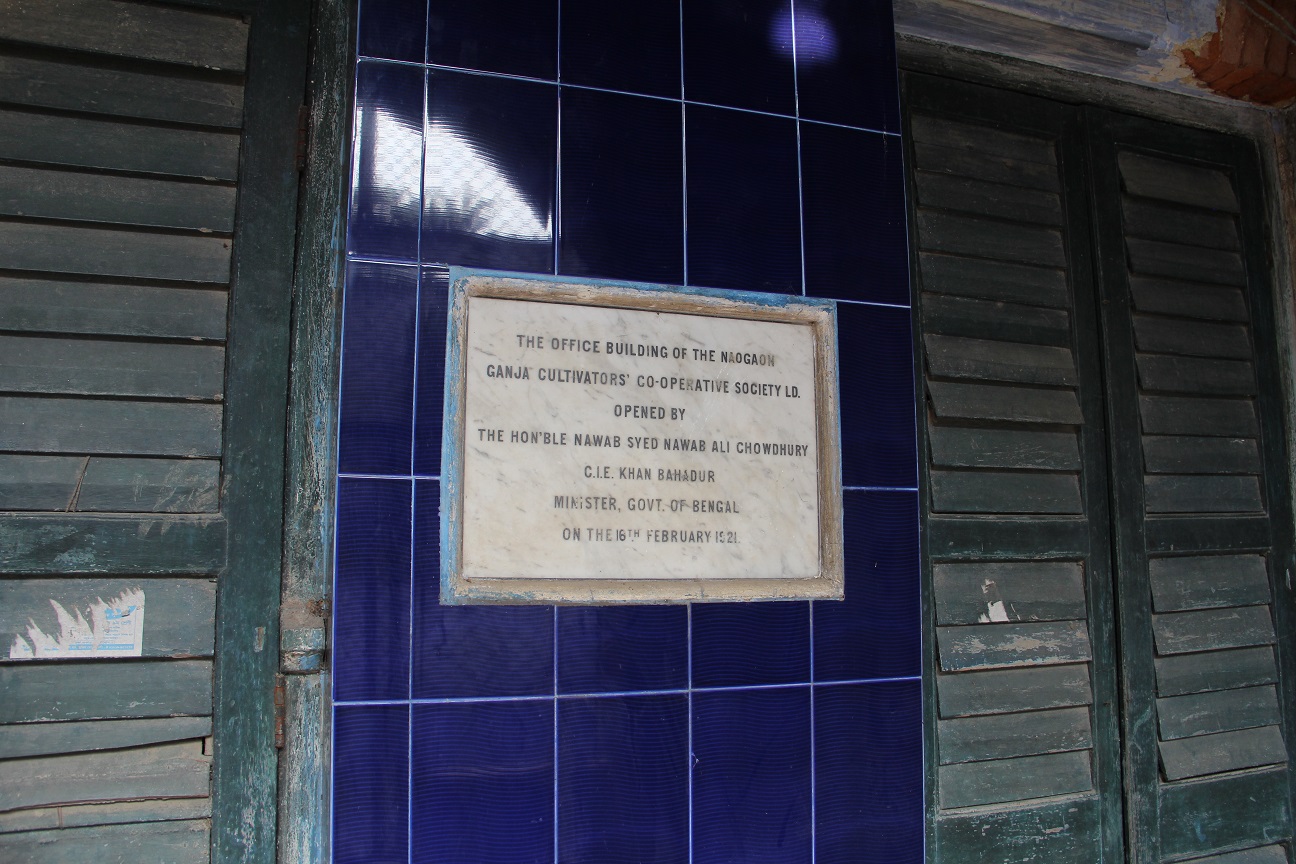
The fakirs used to come when ganja was grown, they said.
There was not that much sound to record, but more images and impressions to bring home. In fact, what I came back with was a feeling of incompleteness. I knew I would have to go back again.
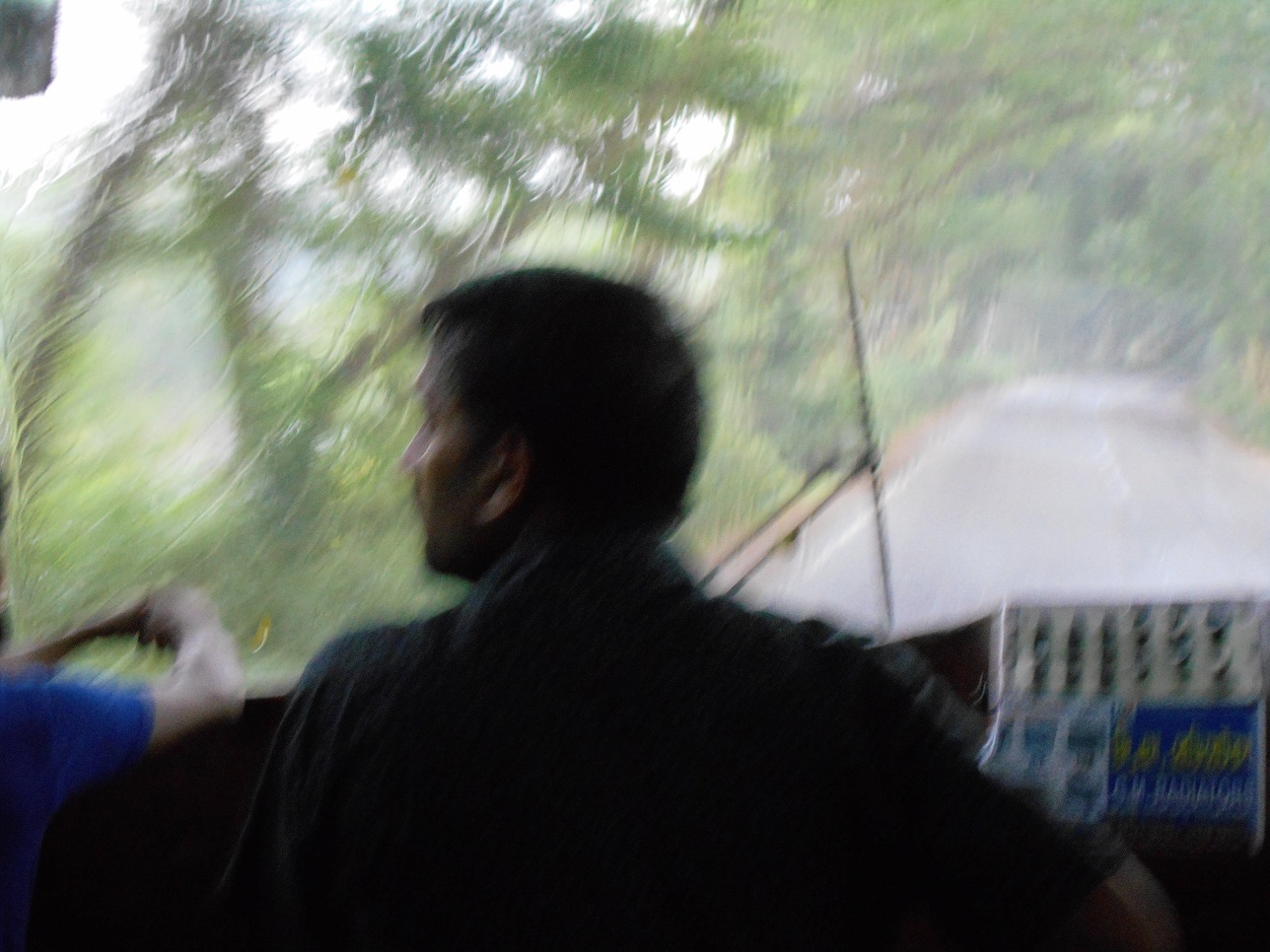
That feeling had started to grow from the train to Rajshahi from Rajbari.
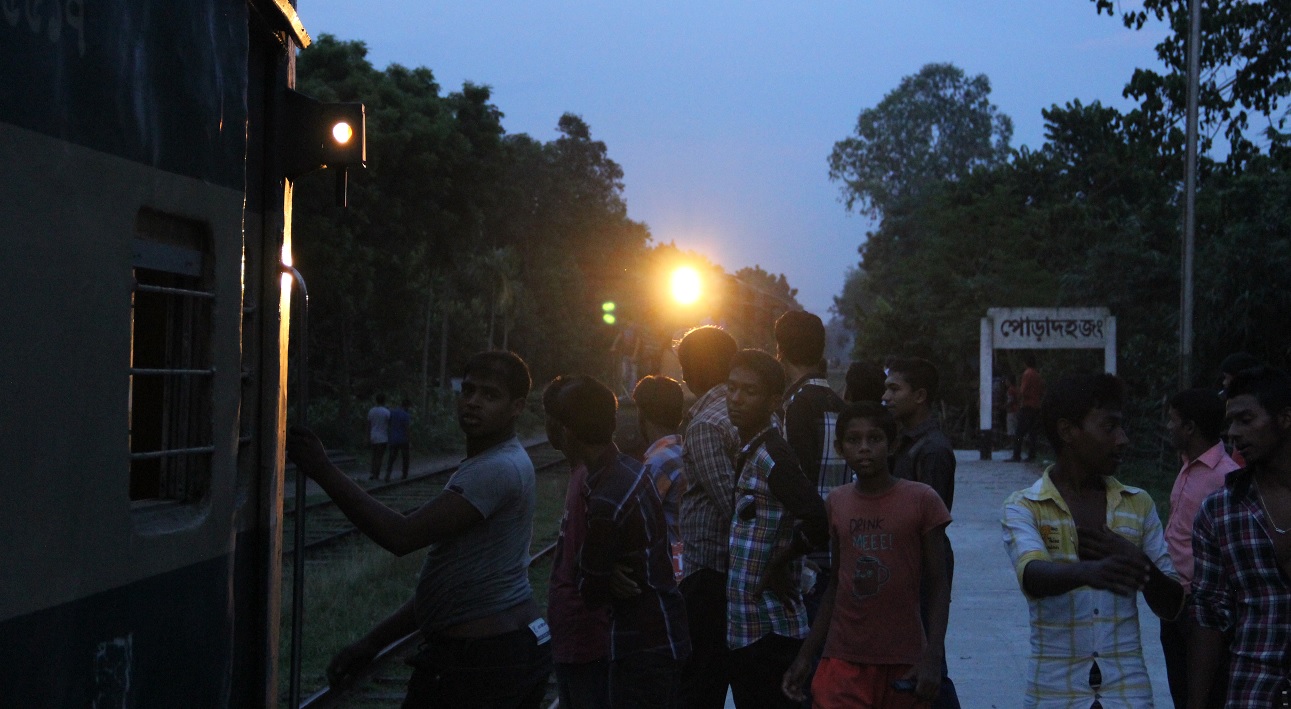
A man in our compartment who worked in the Railways got off at Ishwardi junction. Ishwardi—a name which comes with so much history! When we were going to Naogaon from Rajshahi, someone pointed to a highway and said, this is the road Ila Mitra had taken when she was fleeing the police; he was talking about communist Ila Mitra and the Tebhaga Movement of 1949. Subrata Majumdar, retired professor of mathematics with whom I was staying recounted how he had gone to see the terracotta temples of Puthia with the researcher and writer David McCutchion. Young folklorist Uday Shanker Biswas and Abdullah Al-Mamun, both lecturers at Rajshahi University, took us to a baul akhra in Bagolpara (Durgapur) in Rajshahi, to listen to Shamsul Fokir.

Uday Shanker Biswas is truly interested in local folklore and a collector at heart. I did not know this then but understand now after several years. These photos from 2010 were sent to me in 2020.
Recordings made at Bagolpara. Singer, Shamsul Fokir. Recorded by Sukanta Majumdar on 17 September 2015
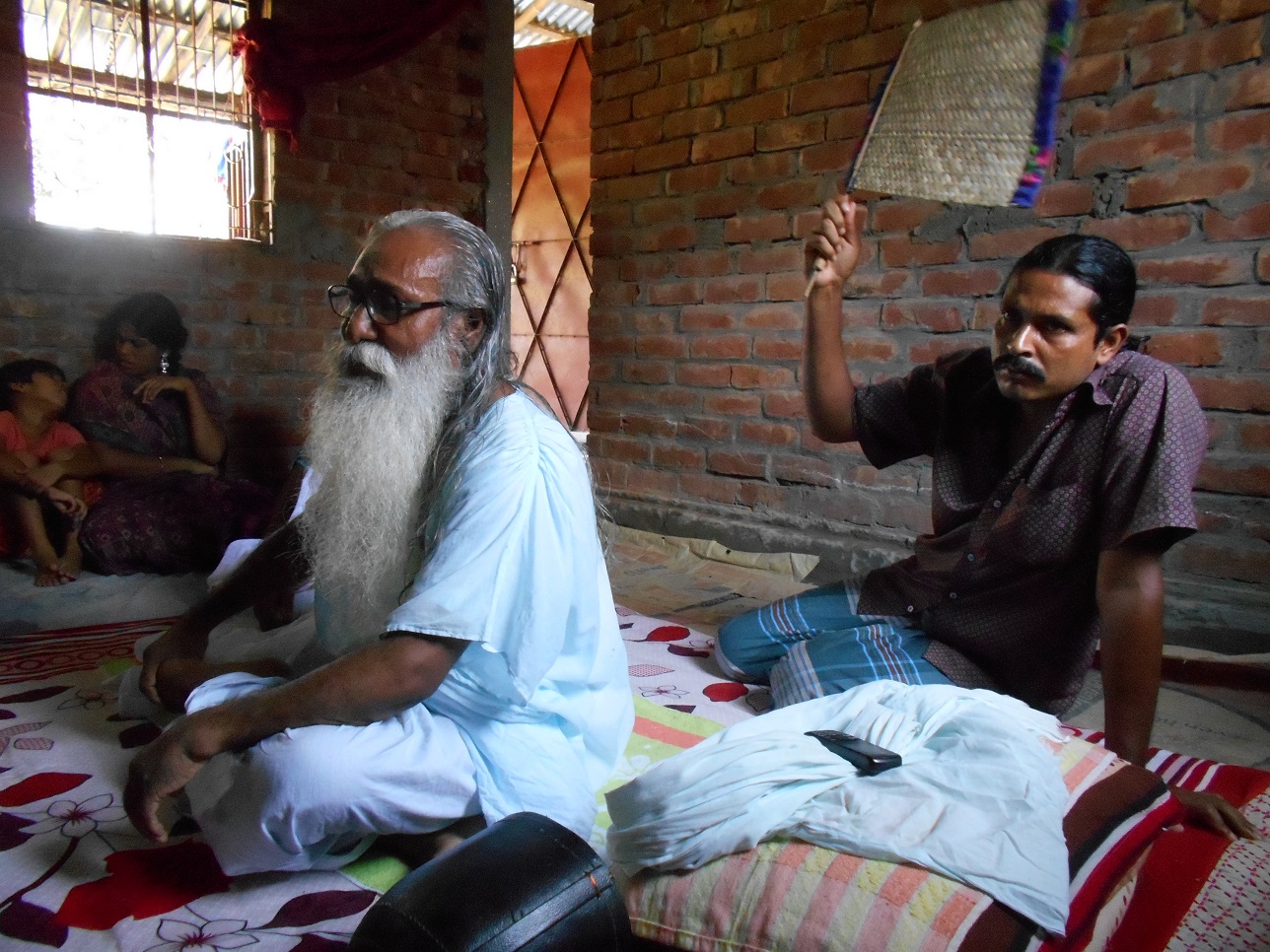
What was the connection of all this with what Bake had recorded? I am not so sure, but this was only the beginning of a journey. In the beginning you have to indiscriminately collect your shells and pebbles from the shore.
We went to Mahasthangarh in Bogura, the Sufi shrine, to find something; who knows what? There we met Mahmuda, a woman who lives on the grounds of the shrine and sings of love and pain. The next year, I would write an idea for a soundtrack called ‘Who Was Jaura Khatan?’ which would be installed as part of our exhibition in Santiniketan ‘Time Upon Time: Arnold Bake in Bengal’. But we can come to all that later.
A song by Mahmuda, in which she sings: O lord, the kind one, your love is not so good as it brings pain. Tomar bhalobasha to bhalo na.’ Recordist: Sukanta Majumdar, 15 September 2015
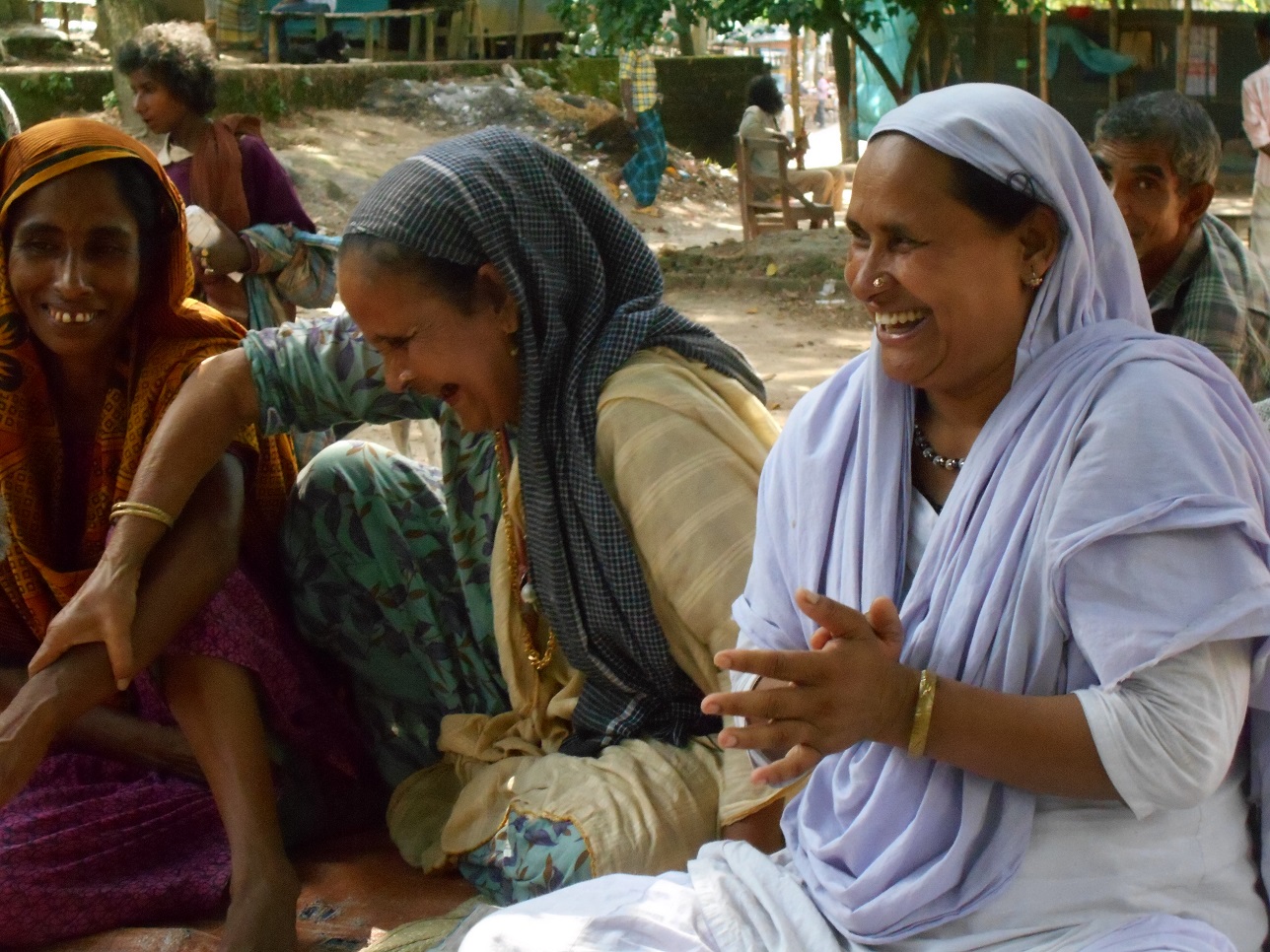
Mahmuda and her friends in Mahasthangarh share a joke. From here we went to Gokul Medh, below, a place of historical and mythological significance. There are songs and stories scattered along the way now, as they must have been in Bake’s time too.
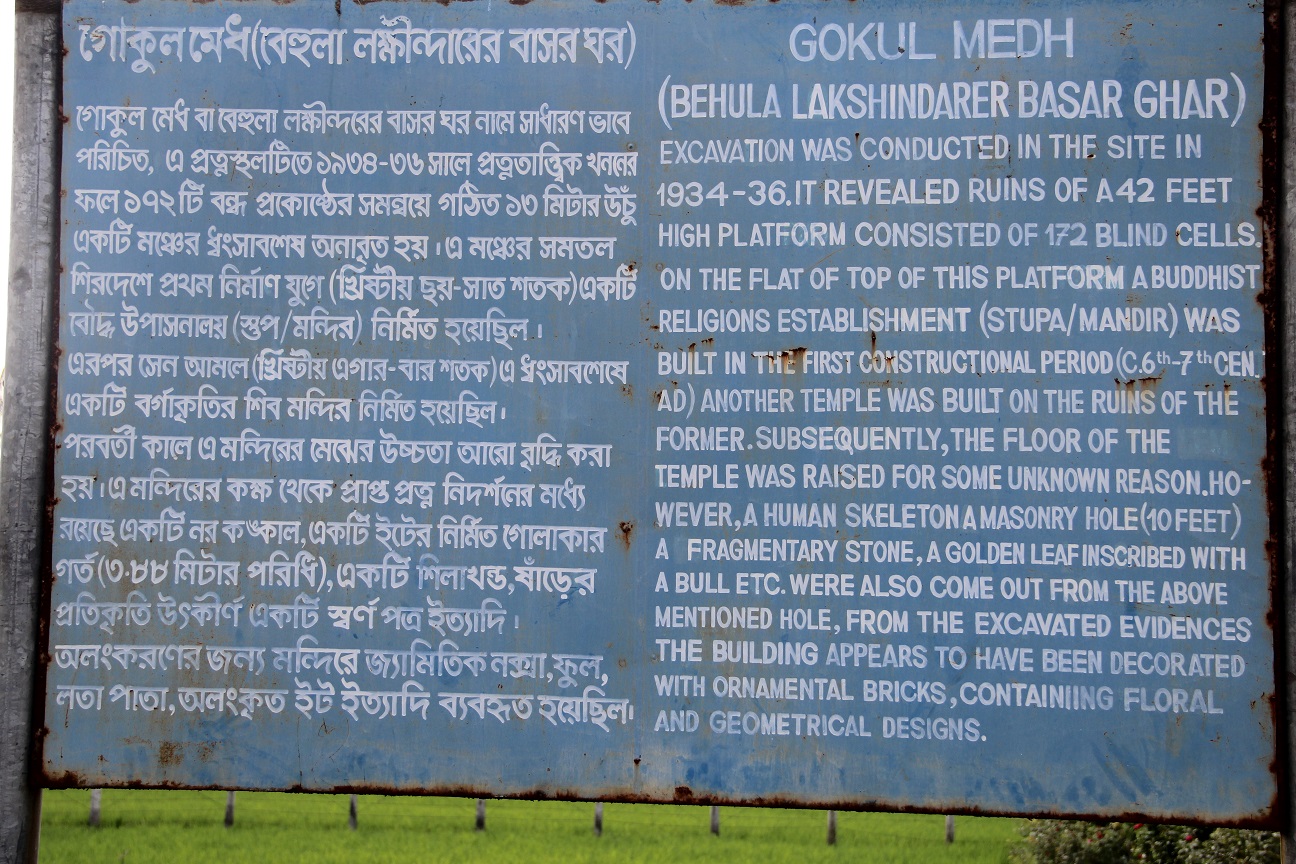
On this somewhat unfocussed trip, we were going from place to place, as if to find something–what, I did not quite know. Hasan Azizul Huq, the novelist, who had crossed the border from Barddhaman in the west to Khulna in the east first, just after Partition, and later moved through places and settled in Rajshahi, where he taught at the university, lived in the house next to Subrata Majumdar’s. We talked one evening about being torn between homes and he read from his writing for us. It was beautiful. There was an old radio cum tape recorder–a keeper and teller of tales–in the house of this fabulous storyteller. Such things always catch my eye.
Hasan bhai speaks. Recordist: Sukanta Majumdar, 17 September 2015

I met ethnomusicologist Felix van Lamsweerde (1934-2021) in his home in Santpoort Zuid. My friends, the Carnatic flautist and music scholar Ludwig Pesch and art historian Mieke Beumer took me to him.
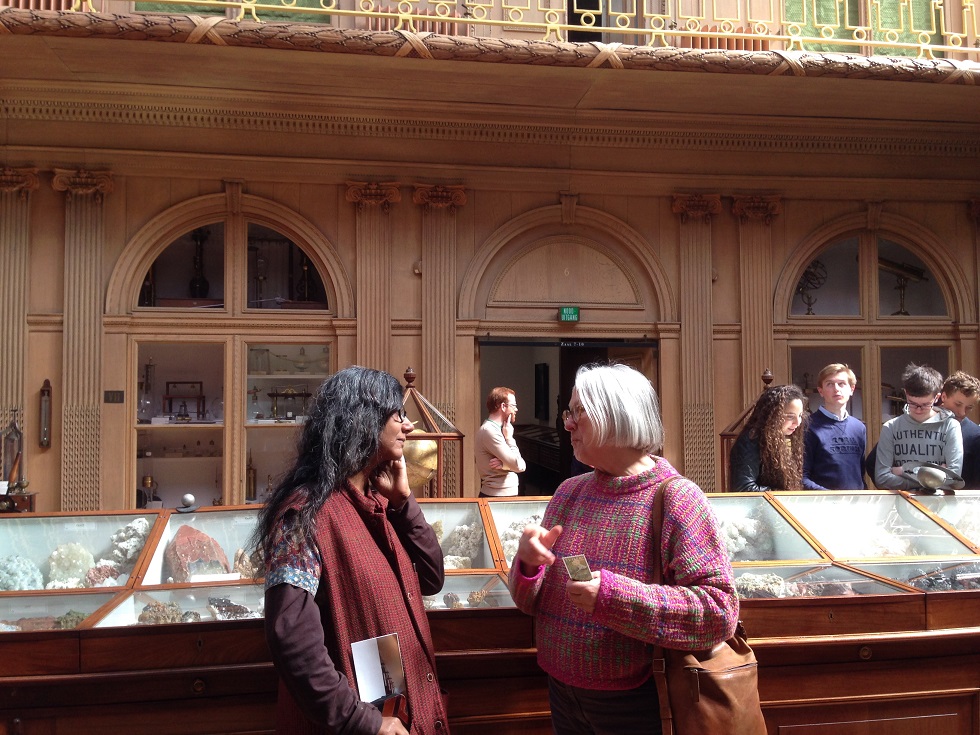
Mieke and Moushumi at Tyler’s museum in Haarlem. Photo by Ludwig Pesch.
We talked about Dr Lamsweerde’s association with Arnold Bake and Jaap Kunst and his friendship with Nazir Ali Jairazbhoy, about Tagore’s visit to The Netherlands, Santiniketan and much more. Here are two clips from that conversation which took place on 30 April 2015.
All recordings on this page, also the ones in Leiden, were made by me on my Zoom H4N recorder.

Photos by Ludwig and Mieke.
I was in The Netherlands in April-May 2015 as I had a short-term Scaliger Fellowship to study the Arnold Bake holdings of the Special Collections of the Library of the University of Leiden. I was vigorously taking photos of things to read and see later. Other than letters, photographs and other papers, I also found several diaries and notebooks of Arnold Bake and his wife Cornelia from the 1926 to 1953 period. They are mostly in Dutch, but treasures troves in themselves. I wanted so much to know what Corrie was writing about their life in Santiniketan that I had two PhD students, both Bengali, help me by reading the pages I was photographing. And then I recorded their reading. Listening now it shows our tentativeness, the fun we were having, the mistakes we were making—the recordings are pretty disarming really!
The photos are all of things carefully kept at Special Collections, Leiden University Library.
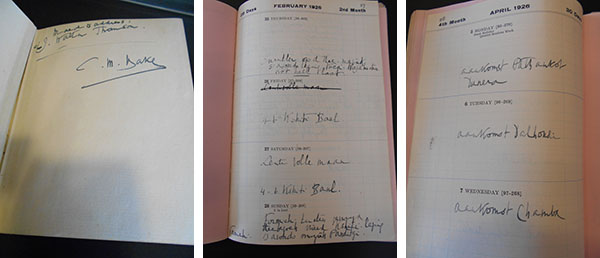
Archishman Chaudhuri was into his third year of doctoral research at Leiden when we met and spent several days reading Corrie’s diaries, sitting in the noisy cafe. This track transports me to that space and time. Archishman teaches now at McGill University in Canada.
There were bits of things tucked into the notebooks and I was so fascinated to think of the people behind them.

Byapti Sur was also a PhD student at Leiden and now she teaches at the Thapar School of Liberal Arts and Sciences. This session with her was on the last day that we met, reading Cornelia Timmers-Bake’s 1929 diary pages. The university was closed on the day so anthropologist Erik de Maaker and filmmaker and English teacher Nandini Bedi offered us a room in their house to sit and work. There were discussion over words and Erik and Nandini also joined in.
I am very grateful to Archishman and Byapti for sharing their knowledge and time with me.

Postscript
In January 2021, had sent the above note to everyone on this page to check for errors and Dr Felix van Lamsweerde had written the following email to me.
21 January 2021
Dear Moushumi,
With some delay I am happy to react positive to your request to use the interview and the photo’s as part of your thesis and on your website. Only it is not clear for me any more which photo(‘s) you selected.
Of course I realize that if I go through the audio I might sometimes think: I should have formulated my answers more clearly or otherwise, but it is now also an historical document and represents your source of information.
One little spelling mistake in your text: my house is officially located in Santpoort Zuid, and not Santpoorte.
I wish you success and also good health in this period of dangerous infections.
With warm regards,
Felix
On 31 July 2021, two days after I submitted my dissertation, Dr Lamsweerde passed away. I deeply regret that I could not show him my completed work.
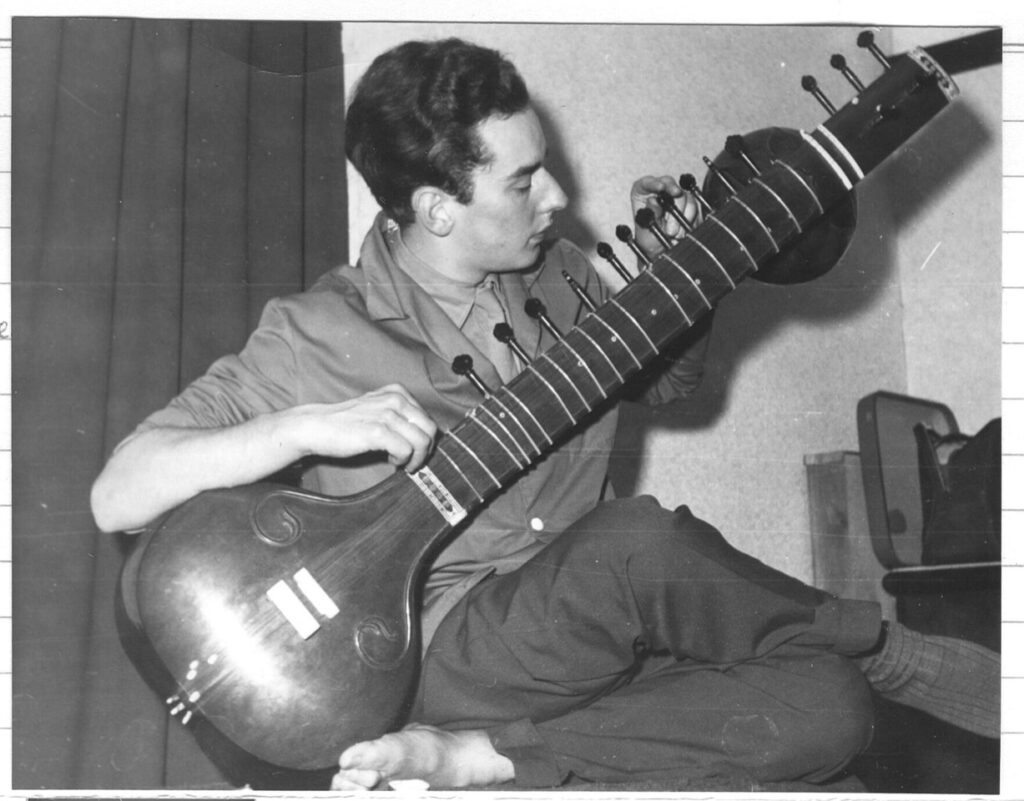
Felix van Lamsweerde. Source: Internet
These are the Niyomsheba songs, a private ritual in which the Mitra Thakurs of Mainadal sing kirtan or the praise of Chaitanya and his five principal disciples who spread his teachings. In contrast to the essentially public Nandotsav singing, amplified and propagated, when the temple gates are opened for all to come and join in the celebration of the birth of Krishna, here the music is only for the insider singer and listener. Nirmalendu Mitra Thakur leads this small group of singers. They sing this same song day after day for a whole month.
Morning singing, with kartal or cymbals
Recordist: Sukanta Majumdar, 7 October 2014
Evening singing with khol or clay drums and kartal
Recordist: Sukanta Majumdar, 6 October 2014
Night singing with khol, kashor, bells
Recordist: Sukanta Majumdar, 6 October 2014
Circumambulating the temple in the morning
Video: Moushumi.
Mainadal is a place in Birbhum, also spelt Moynadal. In fact, the latter is the official spelling. Yet, I am writing Mainadal, as this is how Arnold Bake wrote in his notes. And these recordings are based on Bake’s Mainadal recordings, made between 12-14 August 1933. The British Library Sound and Audiovisual Archives has shelfmarked these recordings as C52/1908-1921; Bake India II Cylinders 259-272. The Arnold Bake Collection is numbered C52 at the BLSA. If you look at the BLSA catalogue, and search for Arnold Bake or Mainadal, you will find many traces of Bake’s original notes erased, because researchers have revised the notes. This is how the first typed version list of Arnold Bake’s wax cylinders looked.
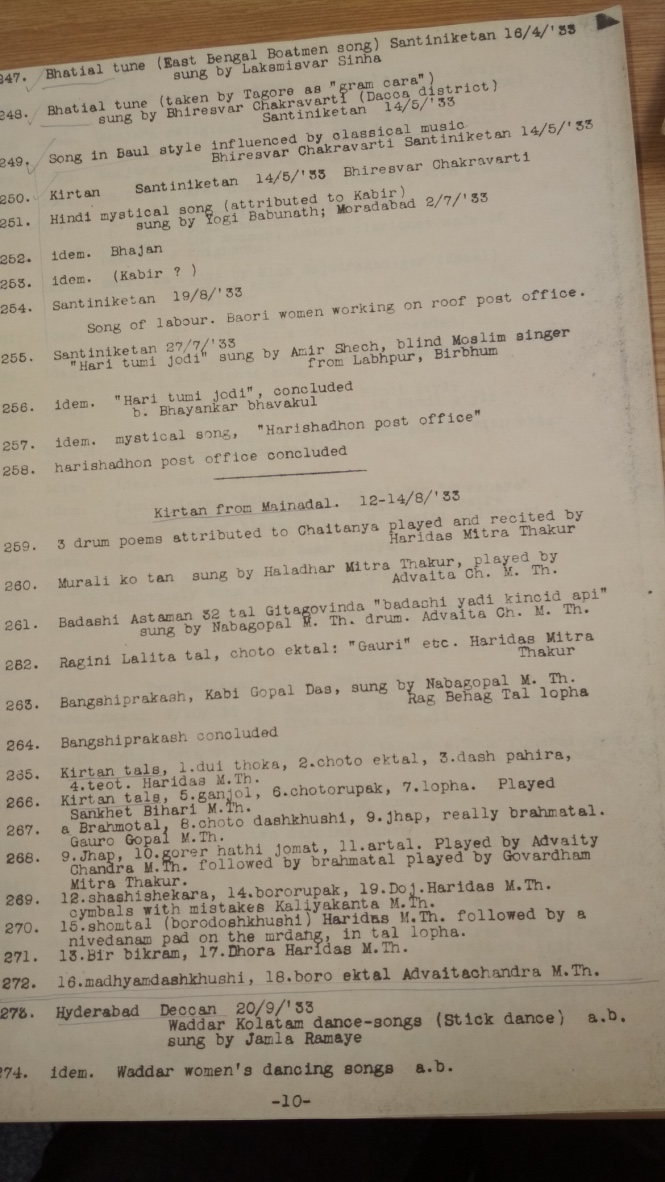
The Berlin Phonogramm-Archiv, who had loaned Arnold Bake the phonograph and cylinders to make his recordings in India between 1931 and ’34, have the same list with the same details, under the heading ‘Sammlung 46: Bake Indien II’, with the following sub-heading: ‘Dokumentation nach einer maschinenschriftlichen Originalliste. Handschriftliche hinzugefügte Passagen sind kursiv wiedergegeben. Liste unvollständig.’
Kirtan from Mainadal. 12-14/8/’33
| 259. | 3 drum poems attributed to Ghaitanya played and recited by |
| Haridas Mitra Thakur | |
| 260. | Murali ko tan sung by Haladhar Mitra Thakur, played by |
| Advaita Ch. M. Th. | |
| 261. | BadashiAstaman 32 talGitagovinda “badachiyadikincidapi” |
| sung by Nabagopal M. Th. drum. Advaita Ch. M. Th. | |
| 262. | Ragini Lalita tal choto ektal: “Gauri” etc. |
| Haridas Mitra Thakur. | |
| 263. | Bangshiprakash, Kabi Gopal Das, sung by Nabagopal M.Th. |
| Rag Behag Tal lopha | |
| 264. | Bangshiprakash concluded |
| 265. | Kirtan tals, 1. dui thoka, 2. choto ektal, 3. dash pahira, |
| 4. teot. Haridas M. Th. | |
| 266. | Kirtan tals, 5. ganjol, 6. chotorupak, 7. lopha. Played |
| SankhetBihari M. Th. | |
| 267. | a. Bhramotal, 8. chotodashkhushi, 9. jhap, really brahmatal. |
| Gauro Gopal M. Th. | |
| 268. | 9. Jhap, 10. gorerhathijomat, 11. artal. Played by Advaity |
| Chandra M. Th. followed by brahmatal played by Govardham | |
| Mitra Thakur. | |
| 269. | 12. shashishekara, 14. bororupak, 19. Doj. Haridas M. Th. |
| cymbals with mistakes Kaliyakanta M. Th. | |
| 270. | 15. shomtal (borodoashkhushi) Haridas M. Th. followed by a |
| nivedanam pad on the mrdang, in tallopha. | |
| 271. | 13. Bir bikram, 17. DhoraHaridas M. Th. |
| 272. | 16. madhyamdashkhushi, 18. boroektalAdvaitachandra M. Th. |
As these lists above show, everyone recorded was a Mitra Thakur. I had not started to properly study Bake’s Mainadal recordings when I had a chance encounter with this video on Youtube, posted by Nilanjan Mitra Thakur in 2012, entitled ‘Moynadal Janmashtomi Utsav-2010’. This is the text which accompanied the film. ‘This event happens every year during Janmashtami festival at Moynadal, West Bengal. Moynadal dham is very famous place in Birbhum for Lord MAHAPRABHU. Janamashtami is the remarkable festival which has been celebrated in moynadal since 300 years. There will be kirtan followed by prayers during Janmashtami at Moynadal. In generations, Mitra Thakur families of Moynadal takes care of Mahaprabhu mandir. Their forefathers were famous for new dhara of kirtan named Manohar Shahi kirtan.’ Later, in the course of my work, I connected with Nilanjan Mitra Thakur, who lives in the USA and we have stayed in touch. I am keeping his Youtube video here with his kind permission.
It is during this Janmashtami/Nandotsav festival in 2014 that we made our first recordings in Mainadal. One of the most beautiful events of that day was Nityananda Mitra Thakur performing the ‘Purbaraag’, which I have written about in the note on that recording session . Here I am trying to look back at the experiences of that day, at what else happened on that day, and how that first experience later helped me to listen, think and ask questions about Mainadal and Bake’s abiding interest in and engagement with this form of music.
Manikchand Mitra Thakur, who in 2014 was the patriarch of this huge and fragmented Mitra Thakur family, the senior-most singer, passed in 2019. He was 88.
In 2014, I did not have any of Bake’s Mainadal recordings with me, only the catalogue information. I had asked him about the song ‘Murali ko tan’ (Cylinder 60) and ‘Badashi’ (Cylinder 61). His younger son Ujjwal, a teacher by profession, was critically aware of the value of their art and heritage, but was also resentful of ‘self-serving and indifferent’ researchers.
Cousins Ujjwal Mitra Thakur and Milan Mitra Thakur talk about how time seems to stand still in Mainadal. They watch Bake’s silent film of kirtan and comment on it. I ask them about Mongoldihi, where Bake also recorded kirtan. Ujjwal mentions songs particular to Mainadal, such as the ‘daagi’ or precious song ‘Badashi’ (Bake Cylinder 61). Interestingly, this song is no longer identified as Badashi on the BLSA catalogue, but it has become ‘Gitagovinda by Jayadeva; Sarga 10, Gita 19 in raga Desvarali’. Nothing wrong here, except that the locals have been denied their own name for the song. Even Arnold Bake’s name for his recording has been erased. In this track, Ujjwal also asks about our intention as researchers. The above recordings were made by Sukanta Majumdar.
Manikchand Mitra Thakur joins the chorus or dohaar while his older son, Ashis Mitra Thakur leads the song. By 2014, he had passed on the role of leader to others.
This is the ritual Arnold Bake describes in his letter after experiencing Mainadal. It is the same ritual Nilanjan filmed in 2010. It is clearly the moment of music and revelry that everyone waits for throughout the year.
We also talked with Nirmalendu Mitra Thakur, the lead singer of Mainadal now, son of Kaliakanta Mitra Thakur and grandson of Haridas Mitra Thakur, both of whom were recorded by Bake (Cylinder 269). Kaliakanta was a boy of 10 or 12 in 1933. Nirmalendu Mitra Thakur told us a delightful story of tuning in to Radio Peking one day and hearing his own song with his father, possibly recorded by Masayuki Onishi, the Japanese student of Santiniketan, who was a friend of Milan Mitra Thakur, Nirmalendu’s older cousin who studied in Kala Bhavan in the late 1970s, and who had come visiting them in 1980. It was a real surprise, as he had no idea their songs could travel this far. He also talked about learning much of the art of kirtan from Nabagopal Mitra Thakur, who was recorded by Bake too (Cylinder 261).
These are two very significant recordings. One is the beautiful song ‘Sachir Nandan Nath’, in which the Mitra Thakurs pledge their loyalty to their land and their god. This is the closing song of their two-day Nandotsav (celebrating the birth of Krishna).
The other is of the Mitra Thakurs singing the names of the departed male members of the family, starting with the oldest who lived some five hundred years ago.
All of these above recordings were made by Sukanta Majumdar
Finally, an interesting notice on the temple wall—’No Photography Allowed’. Yet, the privileged field researcher and recordist are allowed to record and shoot and offered every support possible. There was a time when the kirtaniyas of Mainadal were reluctant to let their music leave their home; now they seemed quite keen to be recorded.
The reasons for calling this sub-chapter Sadhushongo (in the company of/learning by association with the sadhu or the wise one) are many. Firstly, it takes off from a letter Arnold Bake wrote to his old teacher and friend, the wise Kshitimohan Sen (1880-1960), in 1955. Kshitimohan had inspired a love for baulgaan in Bake (the introduction happened earlier when Tagore came to his university in Leiden). Baul is a musical and spiritual practice where ‘sadhushongo’ is a way of teaching and learning about life and living; the song is only a part of this practice. Secondly, I went with the letter to meet my own old and wise teacher, Shibaditya Sen (died 2018) , our own Shibda, grandson of Kshitimohan Sen, on 18 January 2016. The experience was joyous and illuminating. Shibda gave me some home recordings of Khoda Baksh Sai, the famous baul of Kushtia, and others.
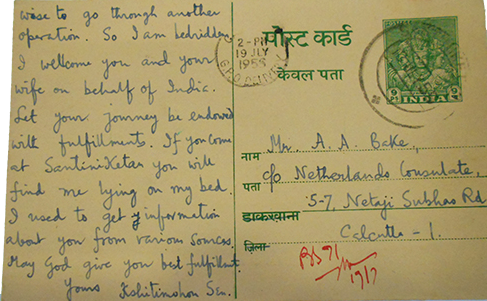
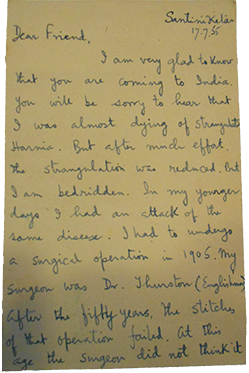
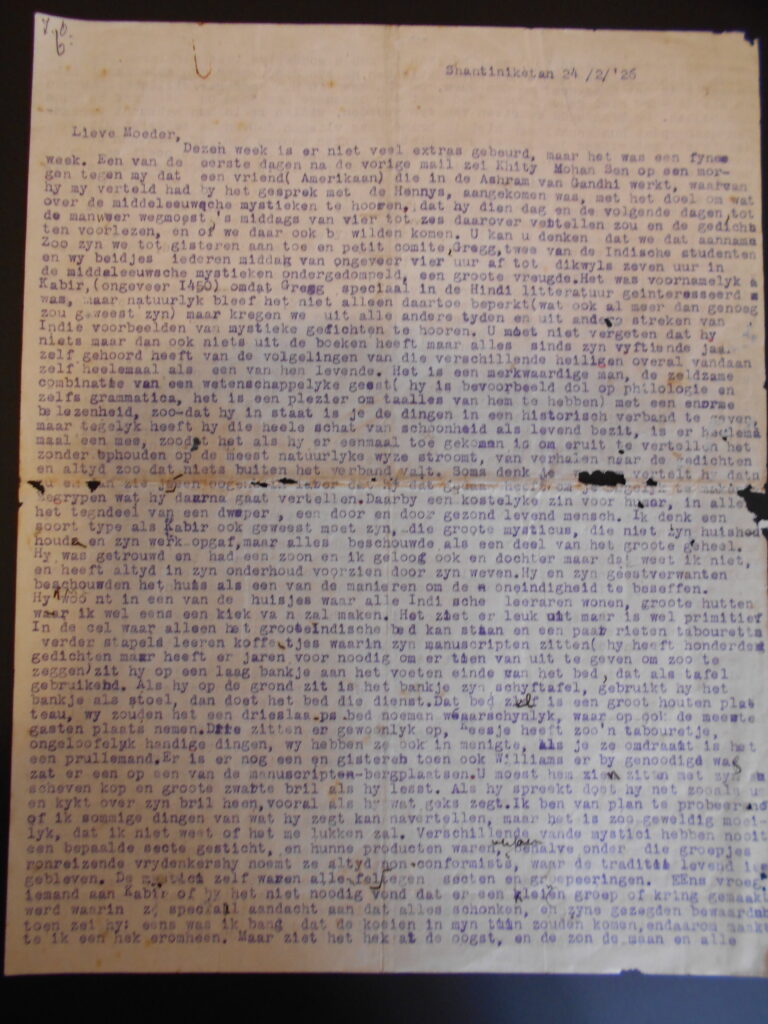
Kshitimohan Sen’s letter to Arnold Bake, 1955 and Arnold Bake’s to his mother, 1926. Photos of letters taken by Moushumi while working on a Scaliger Fellowship on the Arnold Bake Collection in the Special Collection section of the Library of the University of Leiden in 2015.
Arnold Bake was close to his teacher Kshitimohan Sen and learned much from him, especially about the bauls and the medieval saints of India during the first phase of his stay in Santiniketan between 1925 and 1929. The medieval saints of India were a major subject of discussion between Arnold Bake and Kshitimohan Sen. We know this, for example, from his letter of 24 February 1926 in which he tells his mother story after story about Kabir, Dadu (‘Dadu was actually Muslim and his real name was Dawud’, he explains), Ramananda, Ravidas, Jnanadas. Besides having more formal lessons, they go for walks together and talk. Bake attends his lectures. There are many entries in Cornelia Bake’s diaries about meetings with and lessons from Kshitimohan. In that same letter of 24 February 1926, Bake told his mother, ‘I imagine him [Kshitimohan] the kind of person Kabir must have been, the great mystic, who never gave up his household and job but regarded everything as part of the greater whole.’
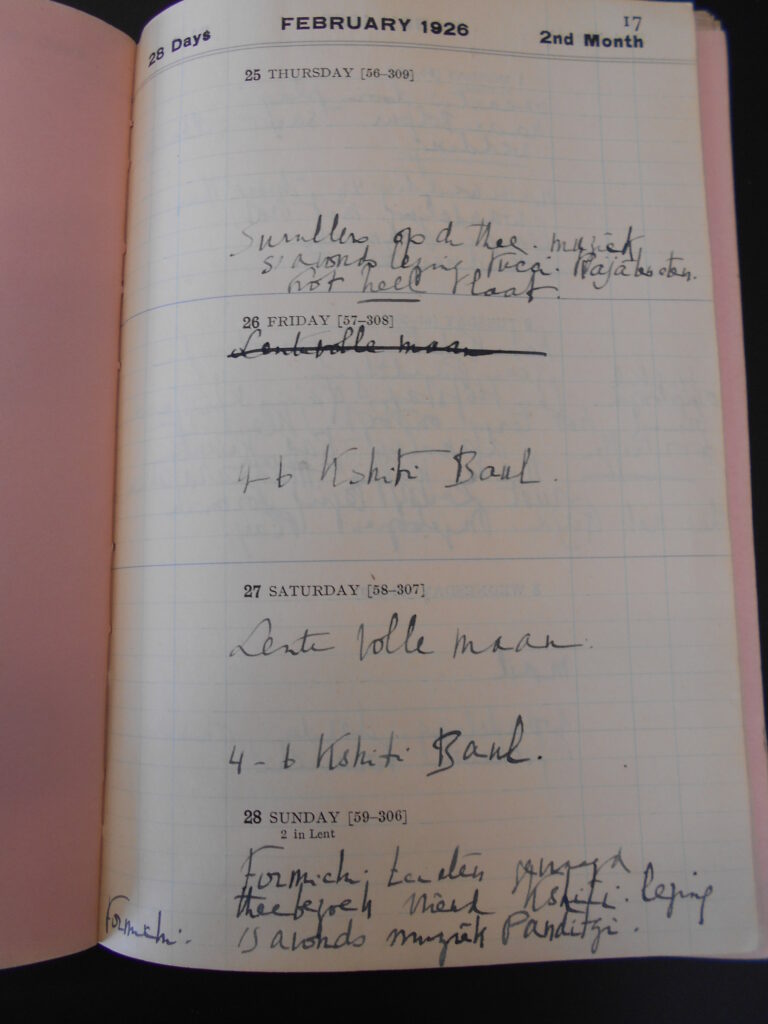
Page from Cornelia Bake’s diary of 1926. Photo taken by Moushumi while working on the Arnold Bake Collection, Special Collection at the Library of the University of Leiden in 2015.
This was the background to the letter Kshitimohan Sen wrote to Bake on 17 July 1955, clearly in response to Arnold Bake’s letter to him to say they were coming to India and would be going to Santiniketan. I went with this letter and Bake’s Santiniketan photos to meet my economics teacher from my high school days in Santiniketan, Shibda.
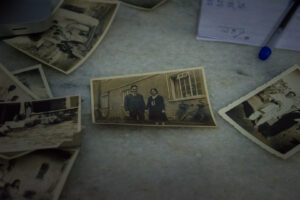
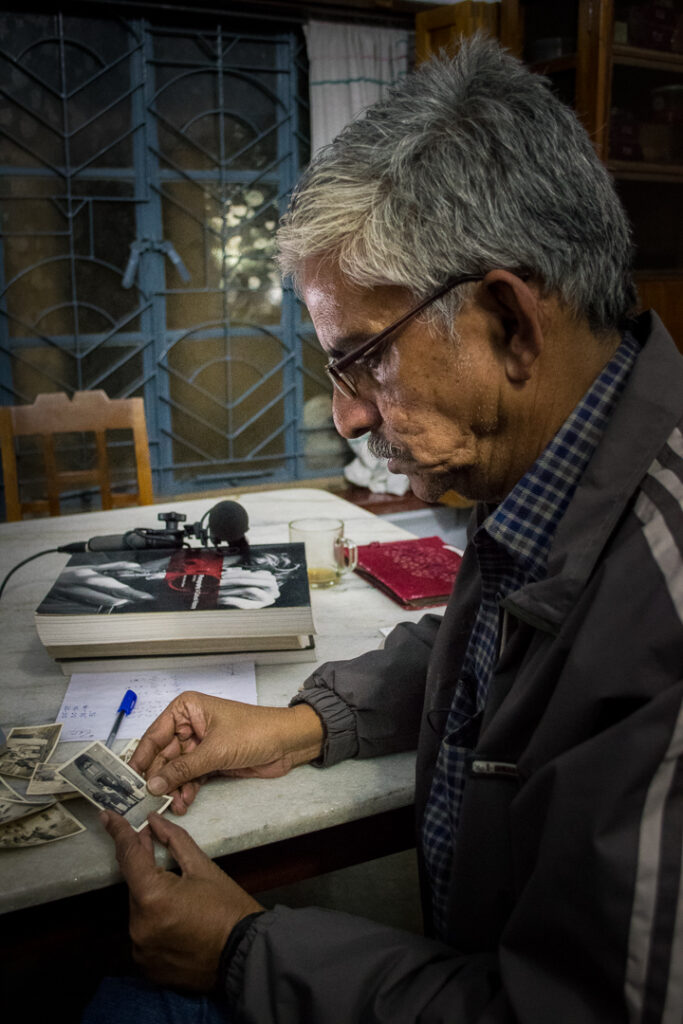
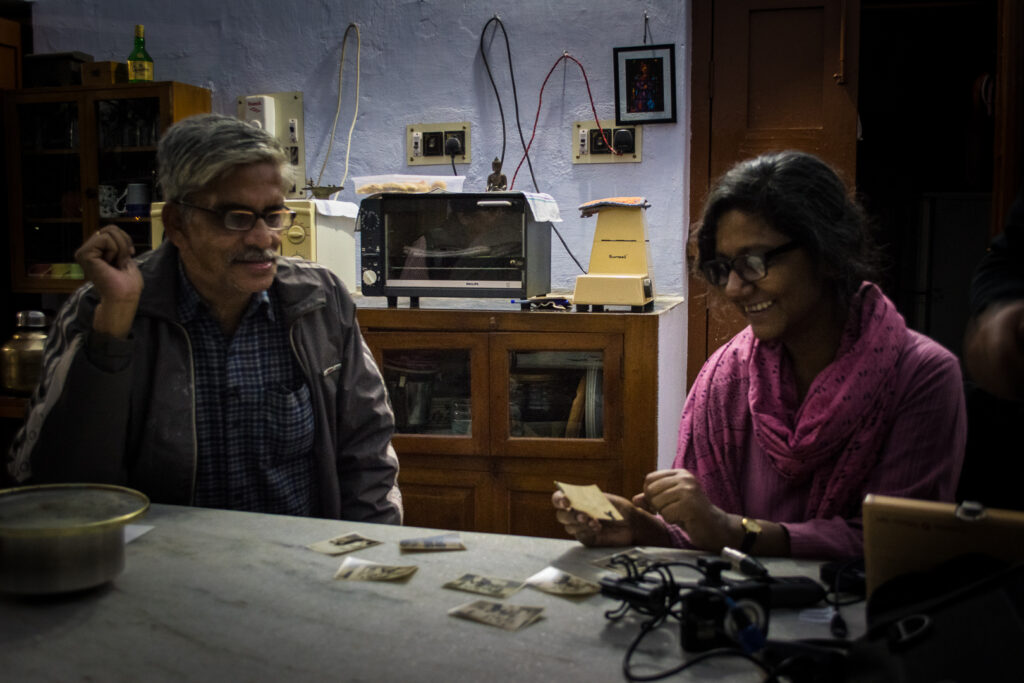
Shibda took out photos from his own collection marked by the friendship of Kshitimohan Sen and Arnold Bake, spanning some three decades. Bake would take and give copies of photos to his friend and teacher. These photos in Shibda’s home were taken by my Dutch friend and translator, Jan-Sijmen Zwarts.
We start to see the photos and letters with Shibda. We are several of us in the room: Sukanta Majumdar (who makes the audio recordings), Jan-Sijmen Zwarts (who takes the photos), the twins Shibaditya and Shantobhanu Sen and I. Shibda used to be a major tea drinker and he also liked to share the drink with others. Throughout this evening we will hear sounds of tea-making and drinking and the clink of tea cups and spoons.
Shibda looks at the group photo of the Bakes with Kshitimohan’s family. This is Gurupally, he comments, the first rows of mud huts which were built for the gurus or teachers
We discuss the wooden ferris wheel and talk about melas. Shibda can identify the girls in the photo, his aunt among them, possibly also Nandalal Bose’s daughter Gouri.
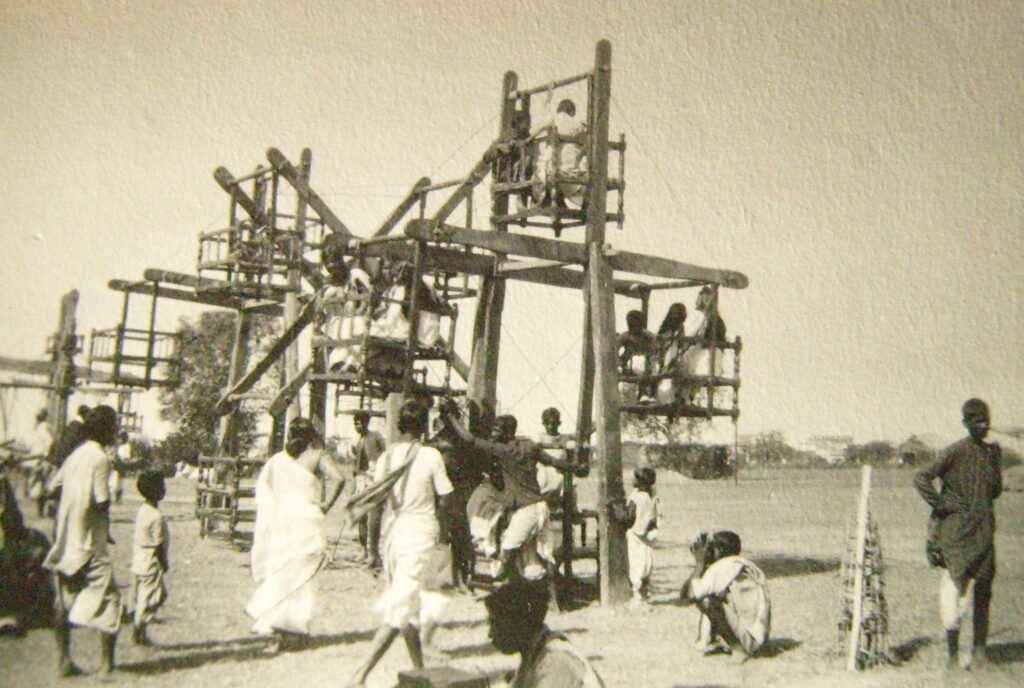
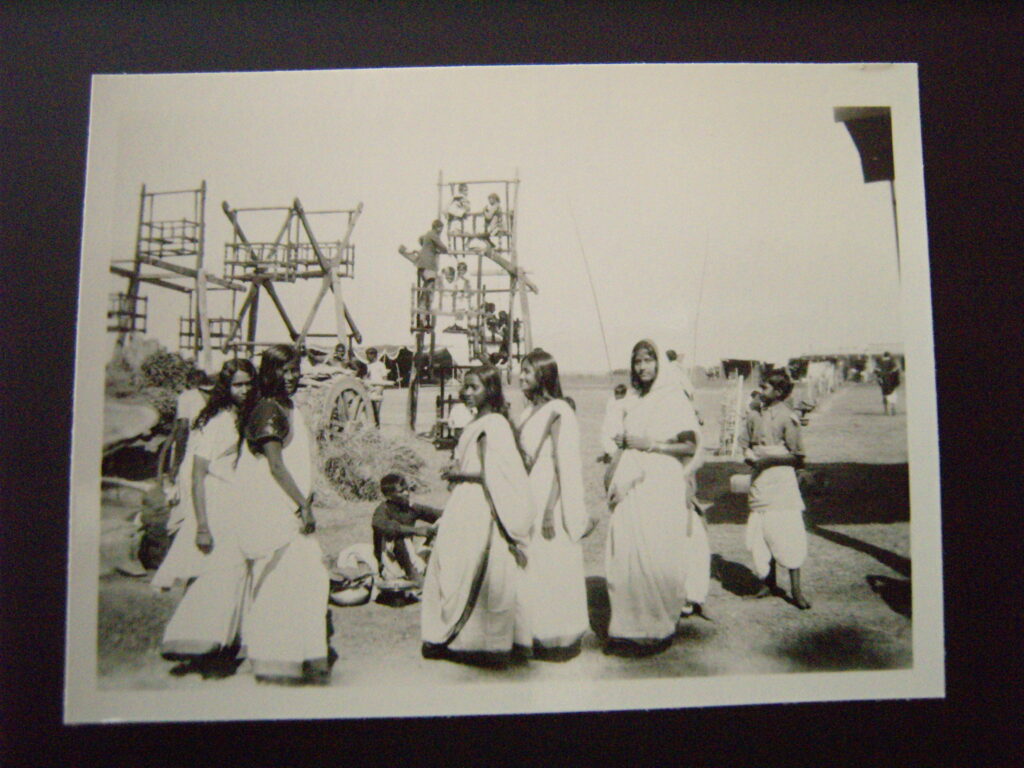
Photos of photos taken while seeing the Arnold Bake Collection at the Library of the University of Leiden for the first time during a visit in 2010.
Shibda very beautifully analyses the photo of the old guest house of Visva Bharati, near the post office, where the Subarnarekha bookshop now stands. He looks at the light and speculates on the time of day when the photo was taken. Then he says, you can see how arid the landscape was in those days.
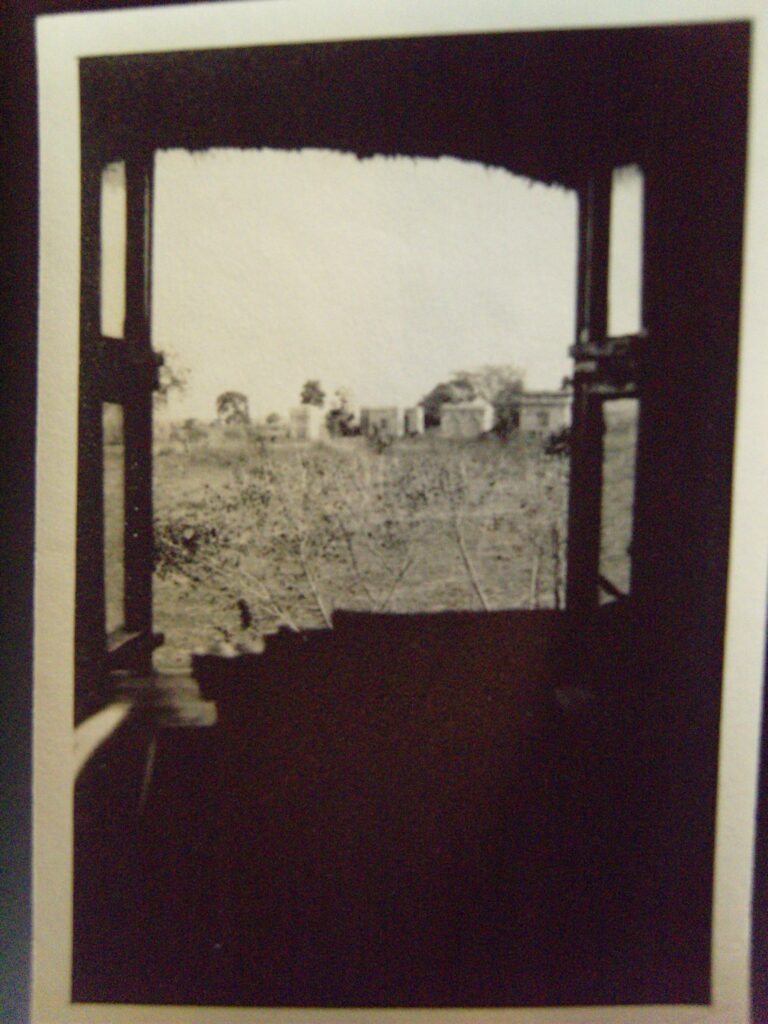
Photo of photo taken by Moushumi while working on the Arnold Bake Collection in the Special Collection section of the Library of the University of Leiden in 2015.
I ask Shibda about how Kshtimohan Sen came to Santiniketan and he tells the story of his grandfather becoming a Kabirpanthi (follower of Kabir) at a very young age in Benaras, following Tagore, who is becoming a phenomenon, working in Chamba, being called to Santiniketan by Kalimohan Ghosh. Could he sing? I ask. To which Shibda says Kshitimohan knew many bhajans, he even taught Dilip Roy and in fact the song Chakar rakho ji was taught to Dilip Roy first by Kshitimohan and then he taught it to the legendary M. S. Subalakshmi. Then he tells the interesting story of the Tagore song, ‘Baje baje ramyabina’, based on a song heard in a gurdwara. Rabindranath wanted all students and teachers to have a wide exposure to other places and cultures and so he sent them out on excursions. It wasn’t Rabindranath who had heard this song, but the teachers on such an excursion. They came back and Dinendranath sang it to Tagore but he forgot midway and then Kshitimohan sang the rest, since he had a clearer head and possibly also because he did not drink alcohol, Shibda jokes.
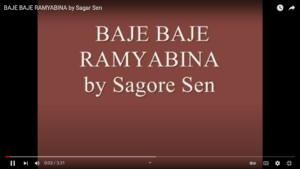
Baje baje Ramyabina by Sagar Sen
We read Kshtimohan’s 1955 letter to Bake. He must have dictated it to someone, because this was not his handwriting, Shibda says. We discuss that time, how ill he was, and laugh about spelling mistakes in the letter. He was 75 then, that was very old in those days. But now Amartyada is already 83, Shibda says about his cousin, the other grandson of Kshitimohan, Nobel Laureate economist Amartya Sen.
We read Annadasankar Ray’s letter to Kshitimohan, written at this same time when Bake was preparing to come to Santiniketan and planning to go to Kenduli. We discuss the route to Kenduli that they were planning to take. We know Annadasankar from Bake’s Naogaon trips
There is a mention of Mansooruddin in Annada Sankar Ray’s letter, which gets us talking about the song collector of ‘Haramoni’ fame. Mansooruddin had come to stay in their home in the early 1980s and he had stayed for about a month, Shibda recalled. He gave a talk, when he told a story about the mystic poet Lalon. A man had come to Lalon with a bag of ghunte (or sun-baked cowdung cakes which are used to light fires). He said, this is all I have and so this is what I have brought for you. Mansooruddin used this story to ask the Santiniketan alumni to give to the institution whatever they had. We also talk about another group photo in which the Bakes are with the large Kshitimohan Sen family. Shibda says, this must have been from the late 1930s. See how everyone has gained weight. And there is also Amartyada, and he was born in 1932 [1933?] and here he is some five or six years old.
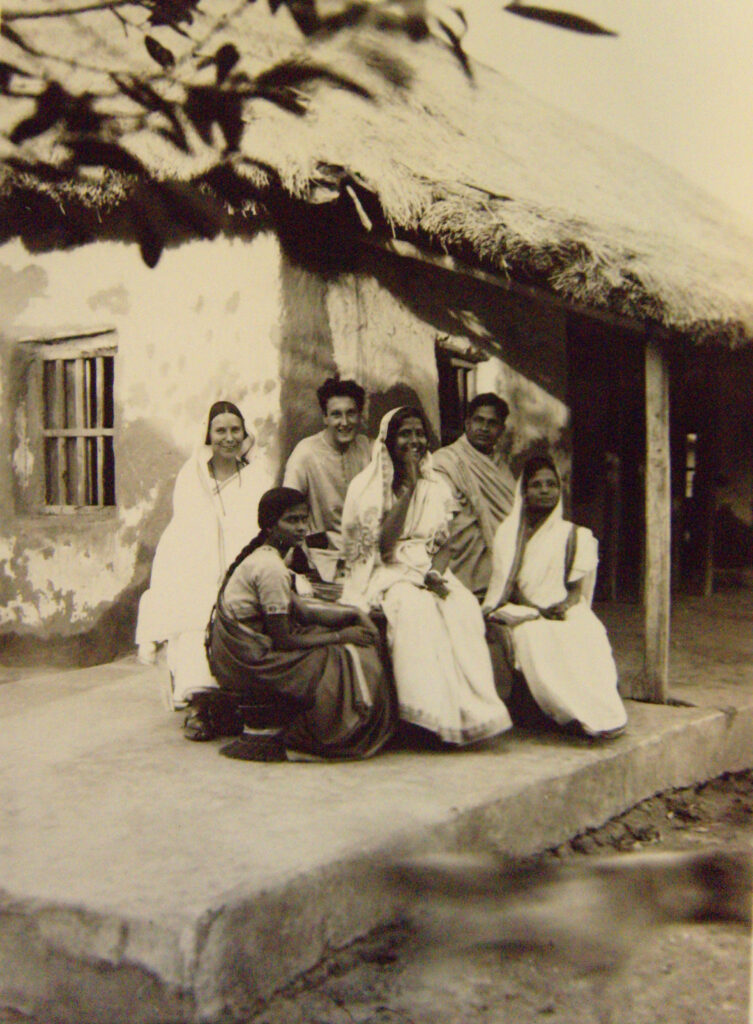
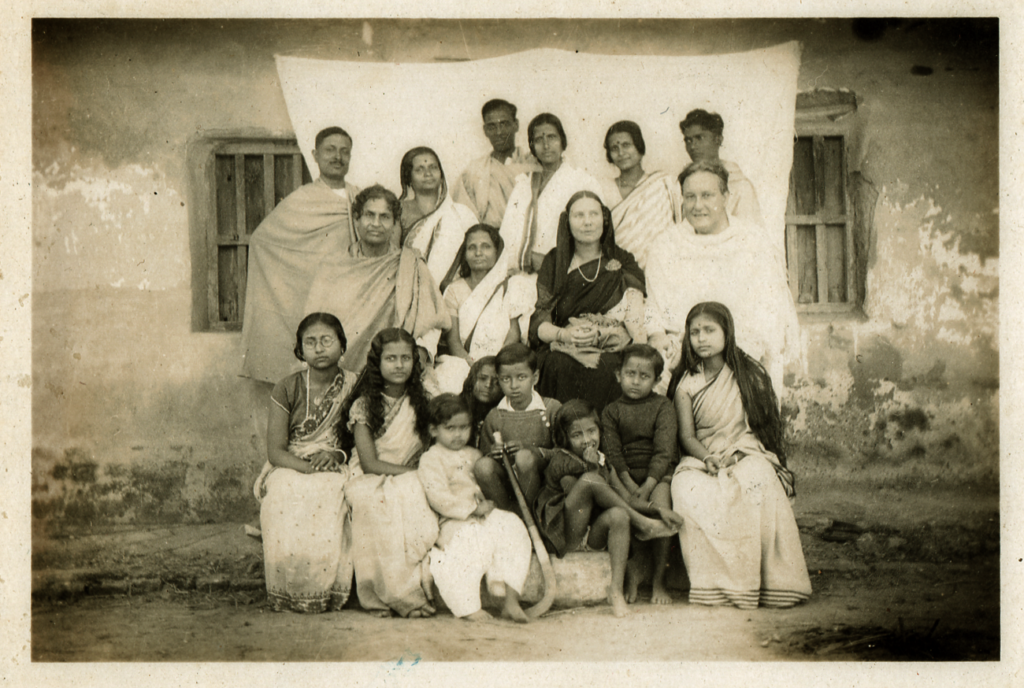
About ten years have passed between the photo on the left, taken during the Bakes’ first four years in Santiniketan in the 1920s, and the one of the right from their third India trip, in the late 1930s, when they were possibly only passing through Santiniketan, because their work was elsewhere then. Photo of the 1920s photo taken by me, while working on the Arnold Bake Collection of the Special Collections at the Library of the University of Leiden in 2015. The 1930s photo was with Shibda; Bake must have given a copy to his friend Kshiti.
What was it like for a Kabirpanthi to join this university of Brahmo practitioners? I ask Shibda. He talks about his grandfather’s objective distance from the practice, even from Tagore. Kshitimohan had famously commented that it is in his songs that the poet can become himself, he can shed his beard and robe and stand utterly naked.
Shibda also tells us that it was Kshitimohan who had taught the Atharva Veda to Rabindranath.
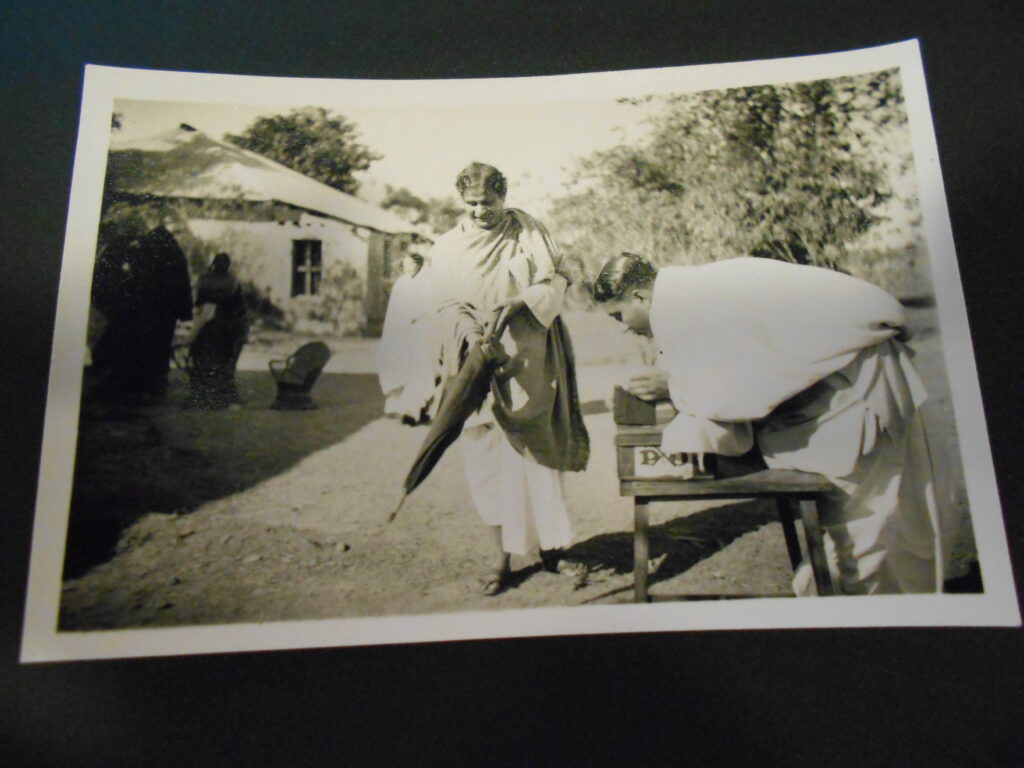
While Shibda makes tea, we look at this curious photograph and wonder what might be going on here. This was Amartya sen’s father, Kshitimohan’s youngest daughter Amita’s husband, who was trying to open a parcel come on a P&O liner. Wonder what the box contained! Photo of this photo taken by me, while working on the Arnold Bake Collection of the Special Collections at the Library of the University of Leiden in 2015.
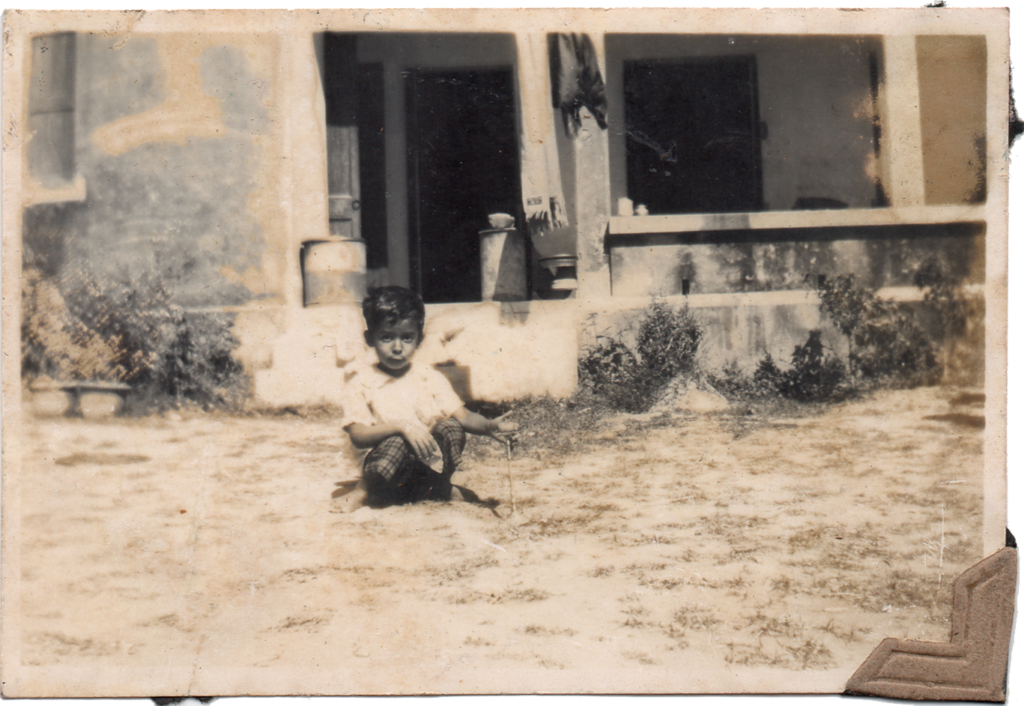
In the course of this evening we had read a letter that Lila Ray, the American writer and wife of Annada Sankar Ray had written to Bake at this time. She was asking him to contact the song collector/field recordist Deben Bhattacharya in London about a payment to Purnadas Baul for a recording made the previous year. So, we got talking and later we played to Shibda one of the songs of Nabani Das Baul that Debenbabu had recorded in 1954. While that song ends, I ask Shibda to tell us the story of Bake’s camera and how he took the photo of his twin brother Shanto. Shibda tells us how frightened he was at the idea of being photographed and how his brother was always the brave one and how this photograph was kind of staged—there was a pot with grains and the idea was that Shanto should pretend to feed the birds and Bake would take a photo.
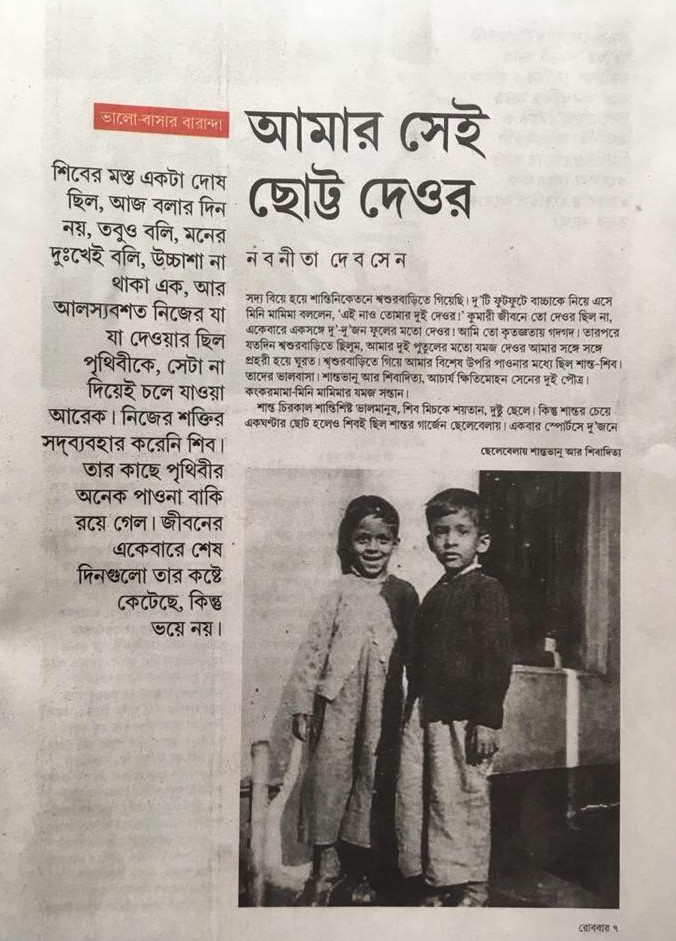
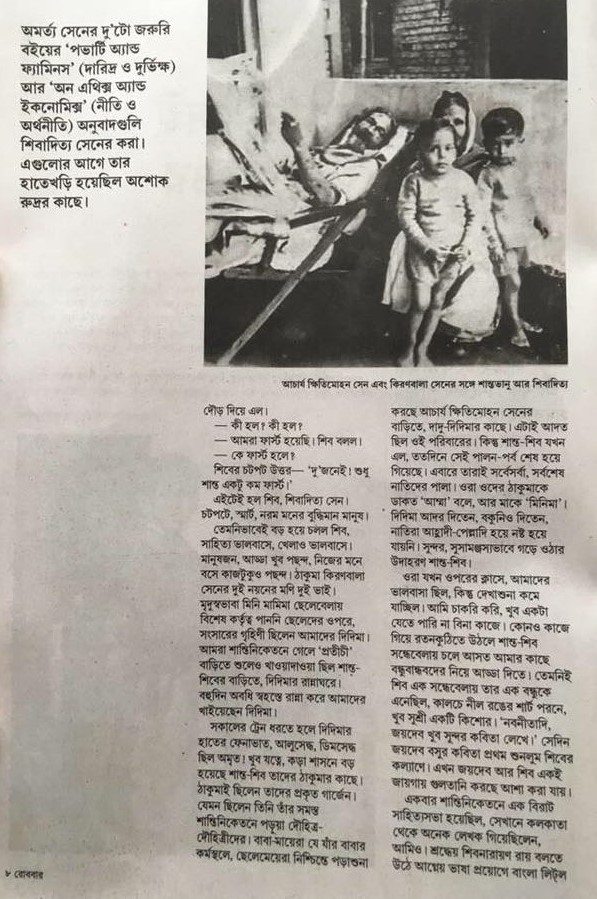
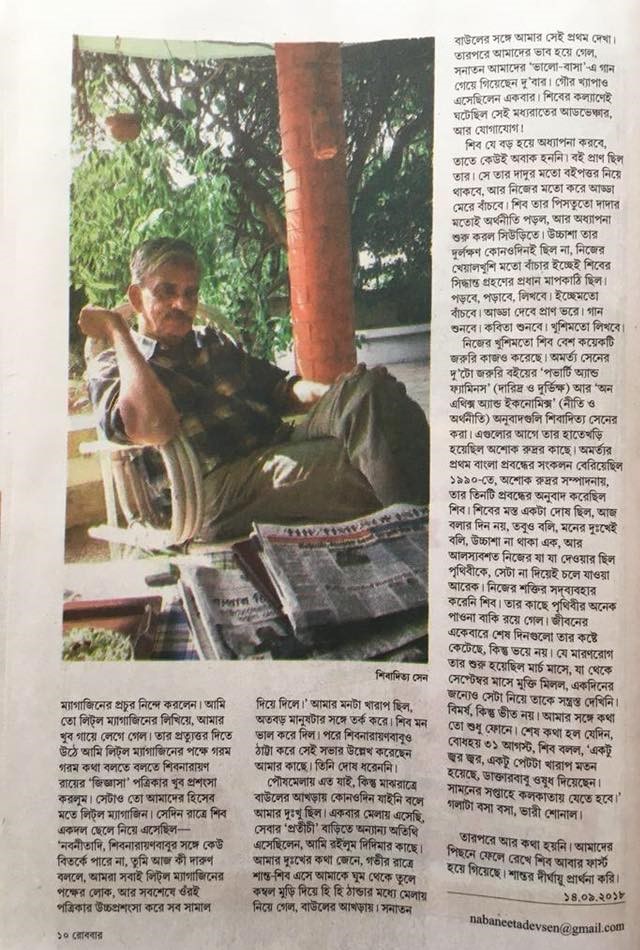
A tribute the writer Nabaneeta Dev Sen wrote to Shibaditya Sen, who used to be her cousin, in Robbar, the Sunday magazine of Sanbad Protidin, on 14 September 2018.
Shibda gave us scans of some photos from his collection, one of which we put on the cover of our folder for our Time Upon Time exhibition.
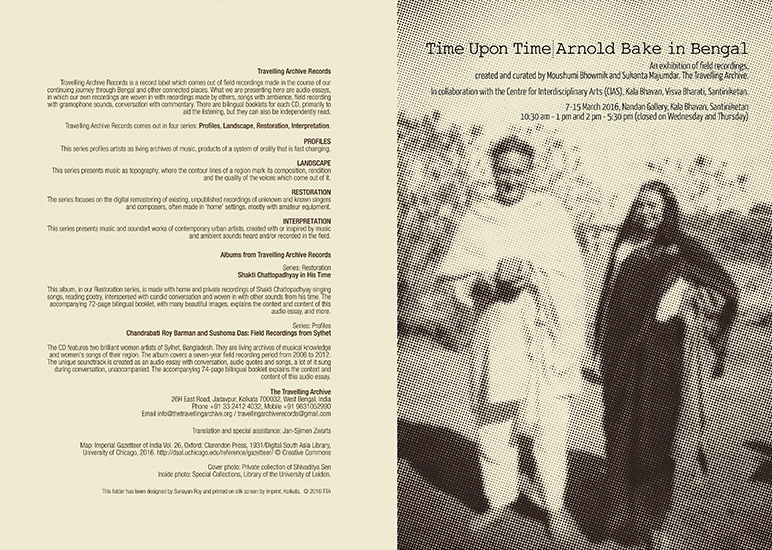
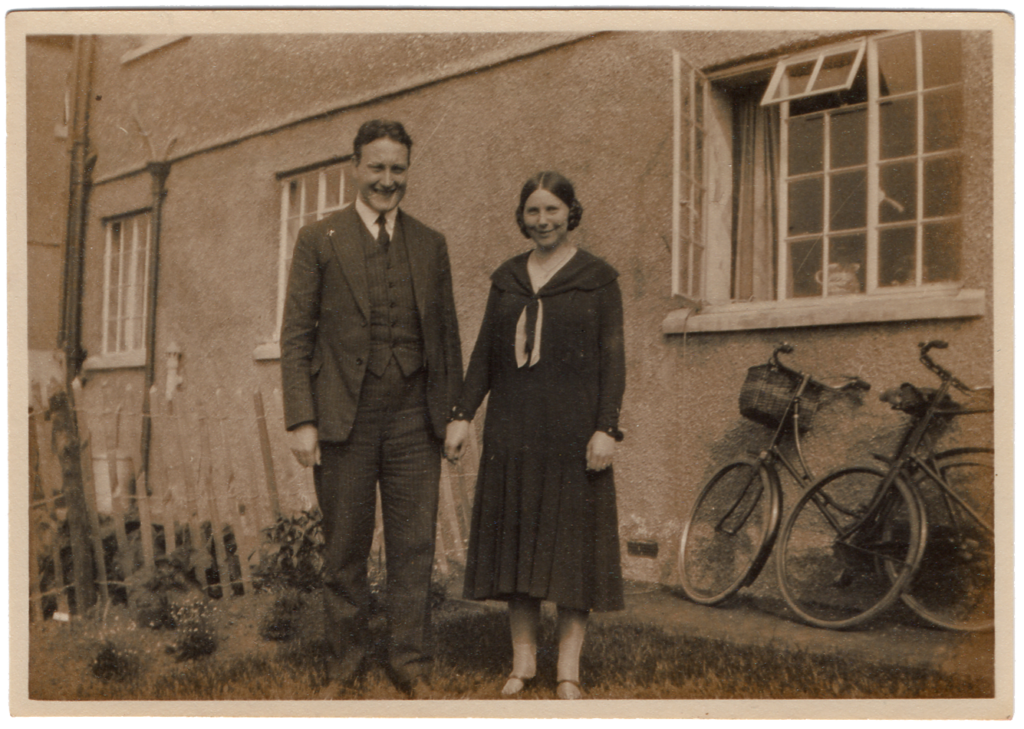
Arnold Bake might have given this photo to his friend Kshitimohan Sen as a memento when he stayed in Santiniketan, or maybe he sent it with a letter from home?
Shibda told us about things going wrong in Visva Bharati towards the end of Tagore’s life, coteries forming, unholy cliques, which made many of the scholars leave. Kshitimohan had been offered a job in Calcutta University and then Tagore apparently said to him, even you will leave me? Kshitimohan stayed on.
Santiniketan celebrated the centenary of Kshitimohan Sen by inviting some renowned bauls of Kushtia to perform in 1980, including Khoda Baksh Sai or Khoda Baksh Biswas. The baul scholar Carol Salomon (killed in a road accident in 2009) had recorded the aashor at Santiniketan. Here the scholar-performer Sudipto Chatterjee writes beautifully about her, which gives an essence of not only her work but also of the world of sound she adopted as her own for most of her rich, though abruptly-ended, creative life, full of erudition, inquiry and humility.
Song received from Soumya Chakravarti and uploaded with permission from Richard Salomon
Shibda had given me two audio cassettes of songs from a private music session recorded perhaps in Santiniketan during this same trip. They had songs of Khoda Baksh Sai.
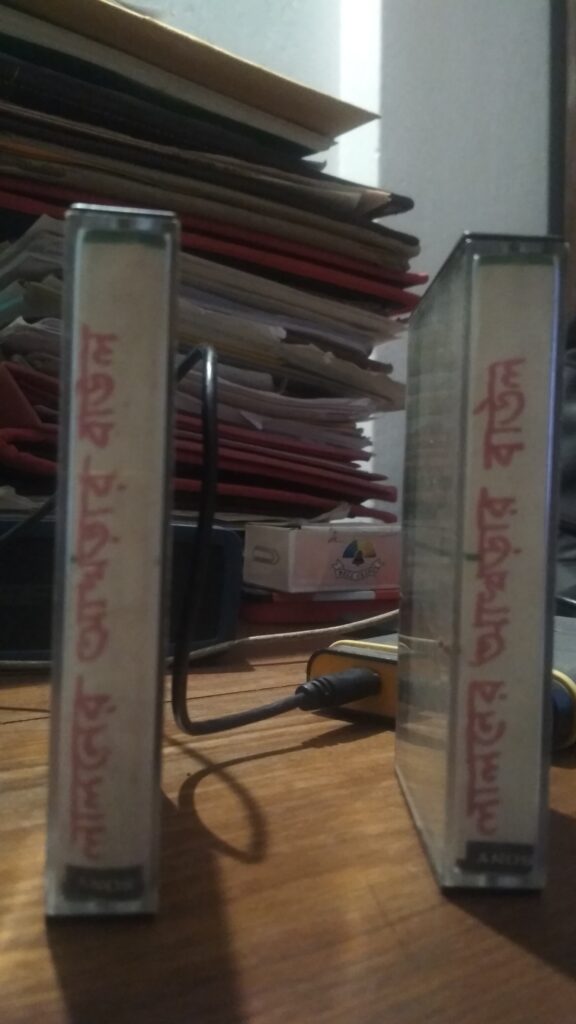
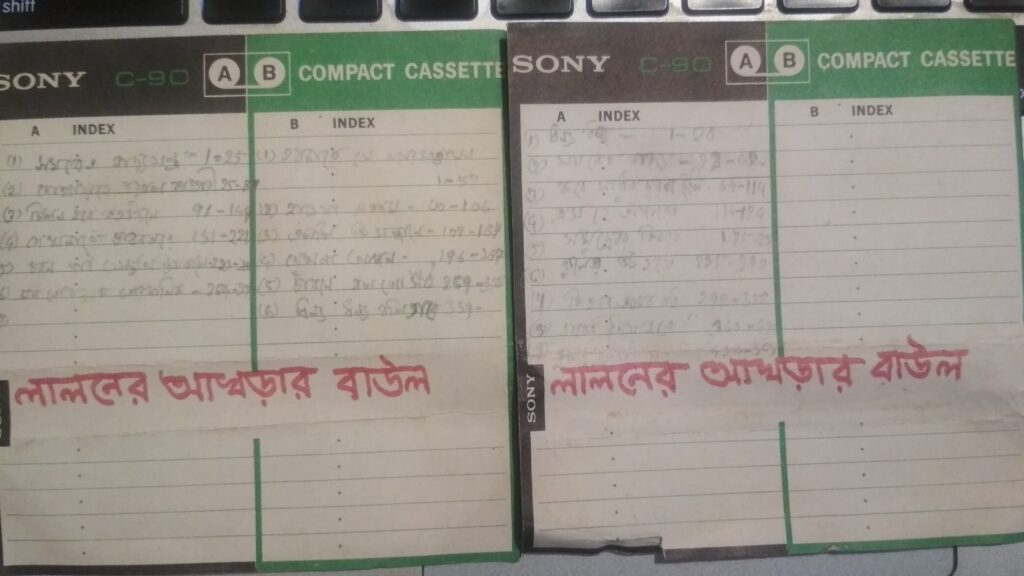
Cassette1 – SideA
Cassette1 – SideB
Cassette2 – SideA
Cassette2 – SideB
Cassettes digitised by Arijit Mitra
This sub-chapter is becoming like a bandanagaan, the song of gratitude towards the elders, ancestors and gurus—those who give us life and teach how to live; also, to our patrons. We usually start a concert with such a song. But here I am putting the final brush strokes to my archive born out of the Arnold Bake in Bengal archives. In some cultures, people sing the praise of the earth and the sky and rivers, lakes, hills and dales, and all living and non-living things, ancestors and children, those who came before us and those yet to come. In other cultures, every time we take a meal we say thank you for the food we are about to eat, for food and shelter are a blessing for which we must be grateful.
In this piece I have tried to say thank you to those who gave me the song.
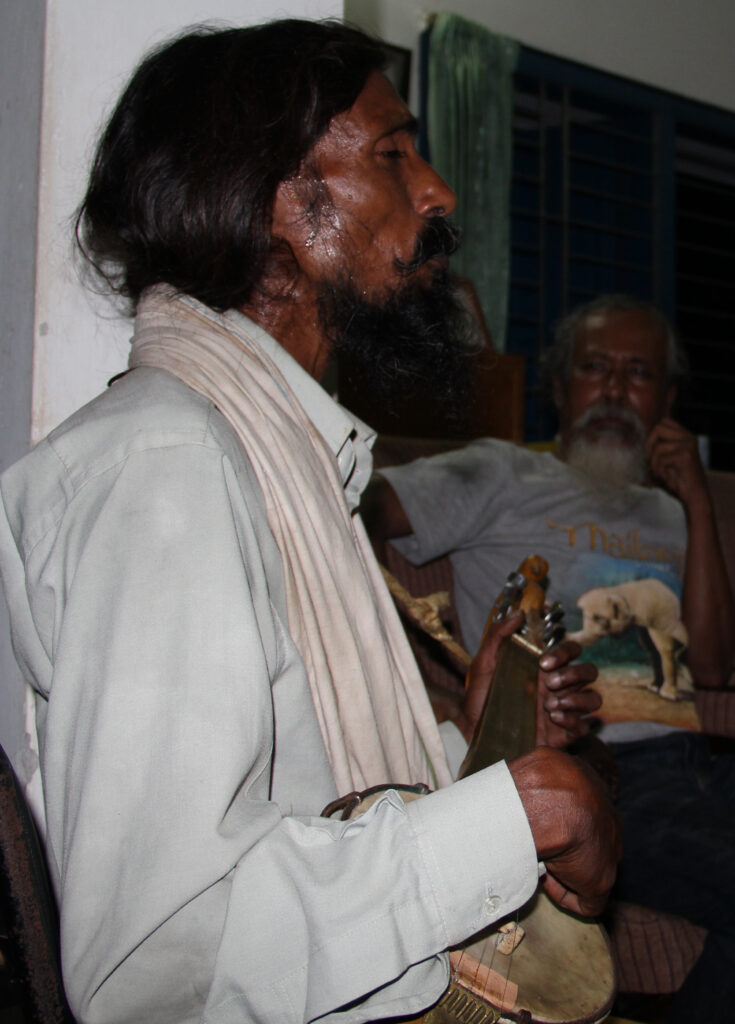
Our longtime friends from the Faridpur-Kushtia-Joshor world of bauls and fokirs, Nazrul Fokir and Salamot Khan, in Faridpur 2014. Photo: The Travelling Archive
Interestingly, in 2014, before formally taking a plunge into Arnold Bake’s world, I was in Faridpur with old friends, listening to songs of the bauls of Kushtia. Salamot Khan, about whom I so often write and whom I have seen as my teacher and friend and so much more—an irreplaceable archive of local knowledge; very wise as well as who had a rare gift of wit, was at the centre of that evening’s discourse. There was also Milonbhai (Mahfuzul Alam) and another longtime friend Sanjay Sikdar. Sukanta Majumdar was there and we had asked Nazrul Fokir of Kushtia to join us and the meeting would take place at the house of Milonbhai and Lona.
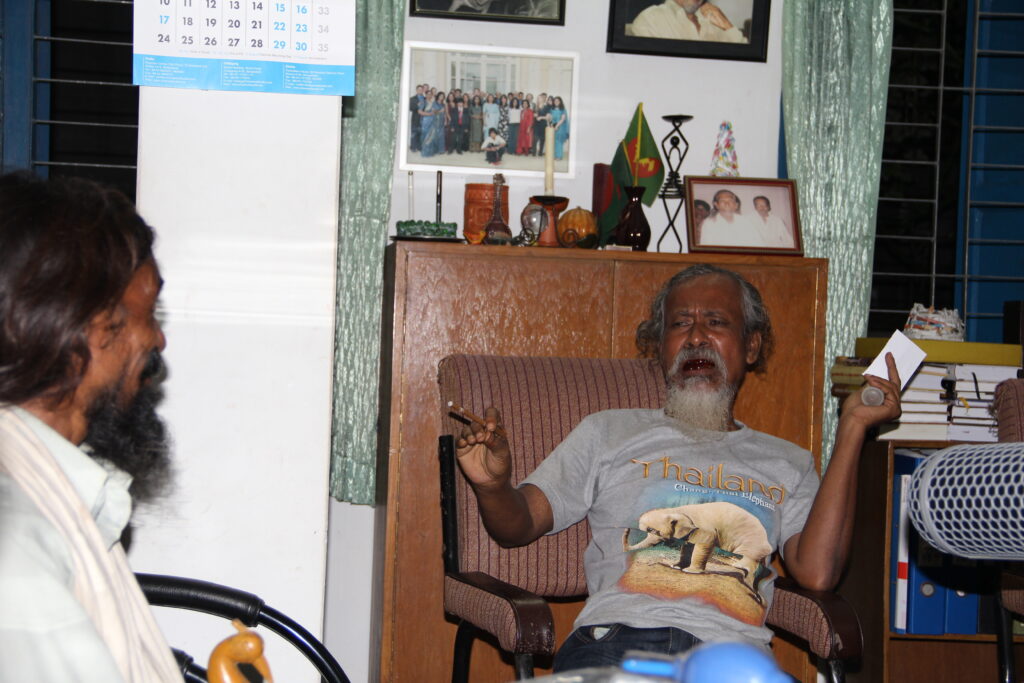
Salamot Khan in Faridpur, 14 August 2014.
The exchange between Salamotbhai, Nazrul, and Milonbhai was at the level of high art that evening. This was essentially Sadhushongo. The music they were weaving into the conversation was just sublime! They sang verses of the folk poets of their Kushtia, Faridpur and Joshor region, especially of Lalon Fokir, Behal Shah, Khoda Baksh Sai; they were talking about the congregation of saints, of melas, of the love and devotion of the bhakto or devotee. They were talking as poets do, in riddles. I was a mere outsider-listener.
As I am listening now, what amazes me now is how several of the themes discussed that day showed up in my later work. For example, they keep going back to the songs of Khoda Baksh Shai and talk about the kind of natural poet that he was, chaaron kobi they say, suggesting a kind of recordist or chronicler, who could make up songs in the spur of the moment. They discuss his portrait by ‘a Poona photographer’, captioned ‘Rasik’: ‘This was taken when they went to Santiniketan, right?’ They are not absolutely sure about the photo’s provenance.
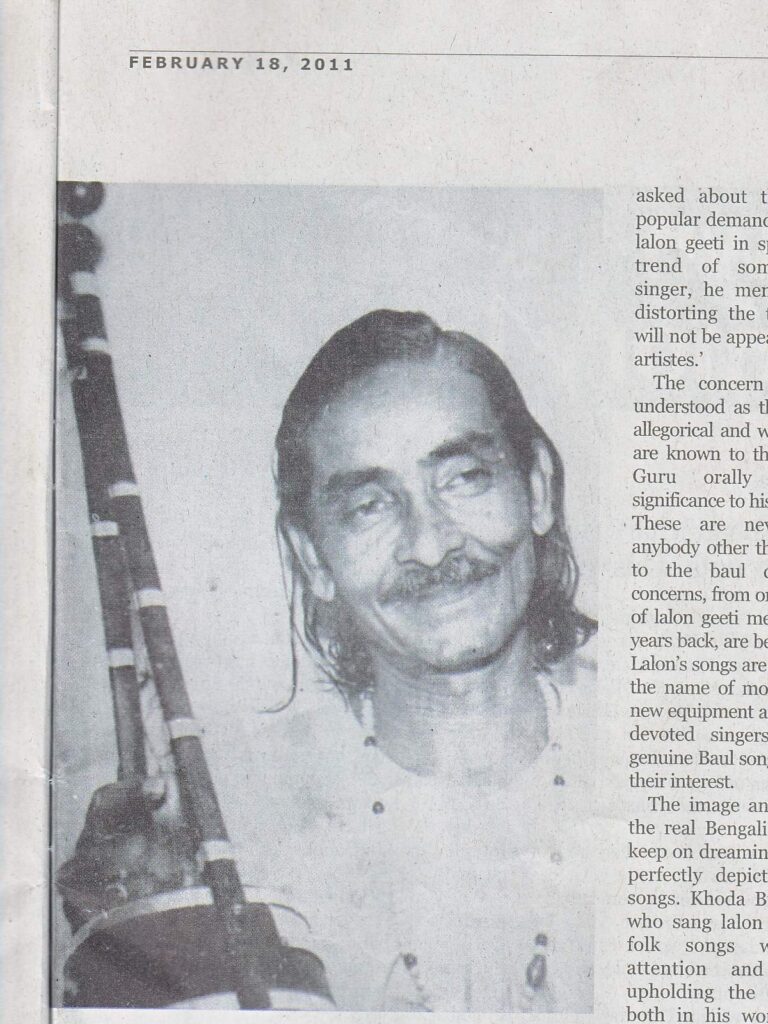
So, this image of Khoda Baksh is possibly from the same time when the tape from the aashor was recorded during the Kshtitimohan Sen centenary. Image courtesy Milonbhai.
Nazrul Fokir sings a song of Khoda Baksh Sai and Salamotbhai explains the physiognomic reasons for the unleashing of ras (rawsh) and bhab.
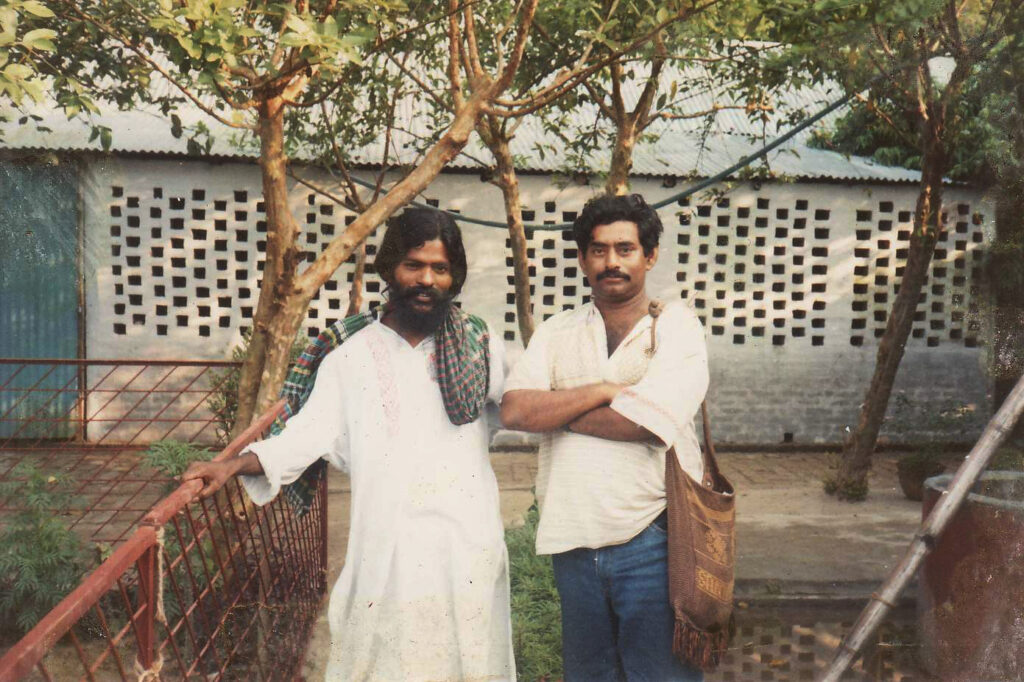
Milonbhai and Salamotbhai have engaged in sadhusongo all through their lives. Here Milonbhai is seen with the Lalon singer Rob Fokir of Chheuria.
Mahfuzul Alom Milon sings Khoda Baksh Sai’s song about Benarasi Sadhu, an ascetic who sat in his shrine in Satdua, smoked ganja all day long and devotees and wise men and women gathered around him and the atmosphere became truly transcendental. Yet, despite the ganja, mela and congregations of the great wise poets of this land, the song Milonbhai sang was also about killings of devotees in the shrine in 1971.
That evening of 14 August 2014, there was not only music that filled the air, but the ‘sadhus’ gathered talked about a lost past, a time of real and beautiful sharing between the Hindu and the Muslim, between believers and people of diverse faiths—something which is becoming increasingly hard to conceive today.
Nazrul Fokir sings a song of Behal Shah and Salamotbhai explains how he is actually singing the Surah Fatiha in Bangla.
Finally, Salamotbhai sang a song of Khoda Baksh Sai, ‘Tumi chhile ektara hole ektara’
There is a way of singing in Kushtia, a direct approach to the note, almost as if there is no place for the meend/meer or the gliding note, apparently unsentimental. Yet, I have met some of the most emotionally sensitive people in these places. I want to end this piece with an image of Nazrul. I was coming home from a field trip in 2018 and passing through Poradoho station. The place is not far from Kushtia. I was in a moving train and Nazrul Fokir came to the platform to meet me. This image is just how Nazrul’s songs are. Deep and inwardly bending; Salamotbhai used to say the life of a fokir or sadhu cannot be easy. The pain is part of their process.

‘Every passion borders on the chaotic but the collector’s passion borders on the chaos of memories.’ –Walter Benjamin, ‘Unpacking my Library’, in Harry Zohn transl. Illuminations, edited with an Introduction by Hannah Arendt. (New York: Schocken Books, 1969), p.60.
My first encounter with Arnold Bake’s Bengal recordings was at the British Library in 2004. It took years for this encounter to start becoming a ‘collector’s passion’. I kept meeting him on the road, as he was part of the road that I was walking, alone, and on the shared journeys of The Travelling Archive. Bake’s sounds, sights and tales of Bengal from about ninety years before me are my inherited memory. It is in the course of my work with his recordings that I became conscious of this inheritance.
From the end of 2013, I began to formally work on a doctoral research entitled ‘Songs of Absence and Presence: Listening to Arnold Bake’s Wax Cylinder Recordings from Bengal (1931-34)’ at the School of Cultural Texts and Records, Jadavpur University, under the supervision of Professor Amlan Dasgupta. As I present this set of recordings from the last seven years, marked perhaps by what Benjamin says is a ‘dialectical tension between the poles of disorder and order’, I know that too much remains unfinished. I have arranged the sessions chronologically from 2014 although within this order of time, you will find jump-cuts from theme to theme and many abandoned trails. There was also the going back to the same song or place again and again, and always finding a little bit more of something—some piece of previously unnoticed sound or silence.
Beginnings also have beginnings. As I look back, I find a funny email dating to 2007, in which the director of the Archives and Research Center for Ethnomusicology (ARCE), Dr Shubha Chaudhuri, is writing to me about an article I wrote for the first issue of IFA’s journal ArtConnect. ‘I just read ur piece in Arts Connect and remembered meeting you here! Glad it all went thru and it is a lovely evocative piece of your “journey”. I hope you will consider archiving your recordings with us here at ARCE and think about making some recordings available on Smithsonian Globalsound … I would like to also add some information – that the Bake collection is at ARCE also and has been here and much used since 1982- and not available only in England. Also, the name is Arnold Bake.’ Whatever made me write Adriaan Bake instead of Arnold is something I still do not know; I don’t suppose anyone has ever called Arnold Adriaan Bake by his middle name before or after this huge faux pas! However, that surely was the beginning of something. Then the first visit to ARCE in Gurgaon to see their Arnold Bake Collection, in November 2009; and I remember the joy of seeing the baul footage—the graceful dancing baul—and Dinu Thakur and Nandalal Bose covered in colour, followed by students, talking and laughing, a flower tucked behind Nandalal’s right ear, on some Dol Purnima (Holi) morning. Earlier that year I was giving a lecture at the Mahindra United World College near Pune. I see from old emails that I had said something about an album compiled by musicologist Alain Danielou and its review by ethnomusicologists Nazir Ali Jairazbhoy and Amy Catlin-Jairazbhoy, at which two members of the audience had informed me that Nazir and Amy were their friends, but also gave me the sad news that Nazir had passed away in June that year. So, it was Binaifer Malegam and Jehangir Batiwala of Poona Music Society who first wrote to Amy to introduce me, and something began to flow. From that to a meeting the next month in Mumbai with Amy Catlin-Jairazbhoy, co-creator with her late husband, Nazir Ali Jairazbhoy of The Bake Restudy in India 1938-1984—all of this was happening even before this website was created and launched. Items from ARCE’s Bake holdings. and our conversations with Amy became part of our website which we launched in 2011. But before that Sukanta Majumdar and I were in Leiden, at the university library asking for the Arnold Bake Collection. We were given temporary library cards and the next few days we spent looking through Arnold Bake’s photographs and letters from Santiniketan to his mother, written in the late 1920s and early 30s, familiar faces in the photos and unfamiliar words in Dutch staring at us; in their midst the flicker of names of people and places we know—Surul, Mr Datta, Gurudev, Sunitibabu… Every letter was written on a Wednesday, we realised. Of course! That is the weekend in Santiniketan after all. We began taking photos of those photos and letters. Finally, in 2013, before I wrote my doctoral research note, The Travelling Archive had made a short audio-video installation piece entitled Footsteps of Sound for an exhibition on early sound recordings in India and I wrote an essay for the catalogue, ‘Man with the Recording Machine’. My doctoral research which followed seems now to have been the logical next step. At that time though I was not entirely convinced I was doing the right thing.
No research is done by any one person, whatever our claim might be. The many voices which can be heard below, and the many collectors of these voices, are proof of the collective of which I am part. Where no other recordist or collector is mentioned, the recording is mine.
Moushumi Bhowmik
Dehotori dilam chhari
O guru, tomari naame
I have set sail my body
O master, in your name I sail my boat
The image of the journey repeatedly returns to the folk repertoire of Bengal; it is a metaphor for life and seeking. There are songs about the boatman ferrying his passengers from shore to shore, or rowing alone; there are songs about waiting for the boat. Songs about the cart-driver, who goes past the house but does not stop; or the buffalo herder who pitches his camp by the riverside, plays the flute in the evening, stays for a few days and then leaves again. There are songs about the daughter leaving her natal home after marriage, like a bird that has learned to fly. Songs about people, moving in groups from one place to another and the lonely seeker setting out in the dark of the night for love. There are also songs of the minstrels, peddlers of love and poetry, for whom the road itself is home.
In my work of the past several years I have concerned myself with such songs; travelling, as the singer-songwriter that I am, through music, rowing and navigating along the way, picking songs from my road and the riverbed.
This paper is about journeys through music and about the idea of the journey as it finds expression in the folk music of Bengal. It is about moving with the song and moving for the song.
Crossings
Bengal as a geographical and political entity comprises the state of West Bengal in eastern India and the country of Bangladesh. They were one whole once, but got broken into two with India’s Partition in 1947, the year also of the country’s independence from British colonial rule and the birth of Pakistan. However, folklore, music and language can hardly remain confined within state boundaries and they are bound to flow over from one side to the other. So, this Bengal that I have been travelling through is both a fragmented space and a mental construct. The history of this land is a history of departures and arrivals—a series of migrations in and out of a space, as a result of which the space continuously forms and re-forms itself. So its people are faced with the question of where and what home is and they are touched over and over by pains of separation and longing, by what in Bengali we call biraha. The word is hard to translate; it is a bit like Eva Hoffman’s tesknota, ‘that adds to nostalgia the tonalities of sadness and longing’.[1]
Partition was a time of mistrust and hatred and there were communal riots between Hindus and Muslims and killings on both sides of the border. The east of Bengal was carved out as East Pakistan (what in 1971 became Bangladesh), because the Muslims were in the majority on that side and Partition was carried out on the basis of the religion of the majority. Partition was therefore a time of large-scale migrations across the borders, more though from the east to the west. Those who made these crossings took their songs and stories with them; they would now try to make homes in new lands, sometimes even far from Bengal. In the 1950s Professor Alain Danielou, a French musicologist who taught at the Banaras Hindu University, recorded a refugee from East Bengal by the name of Haripada Debnath in Benaras, for an album compiled and edited by Alan Lomax for the World Library of Folk and Primitive Music series.[2] Debnath plucked on his four-string lute, the dotara, and sang a song about crossings: ‘Monmajhi tor shadher tori baite jaano na. O heart, you do not know how to row your boat’.
In the films of the Bengali filmmaker Ritwik Ghatak these songs from a lost home have an almost archetypal presence, filling the air with nostalgia and longing.[3] Ghatak’s Titash Ekti Nodir Naam starts with ‘Ore noukar upor Ganga bojhai. . . Look how the River rides on the boat.’ It is a riddle of a composition by the poet Lalon Fokir.[4]
Ore noukar upor Ganga bojhai
Tara shuknay beye jaay
Tomar ajob leelay!
Look how the River rides on the boat,
While the boat swims in the shore.
O how strange your ways!
Life does indeed seem like a puzzle! Tangled up in political decisions, economic crises, social change, religious movements, natural calamities and personal histories, most of it is beyond our control. States are named and re-named; barbed-wire fences run across rice fields. And we are caught in an endless cycle of comings and goings, seeking and making homes wherever we are.
But this ‘home’ itself is an indefinable entity. What is the home that we leave behind, what is the home we are seeking and what is this home where we live? This multiplicity of meaning finds beautiful expression in the songs of the mystic poets of Bengal, where the body itself is seen as the home, housing the mind, yet that mind is like a caged bird waiting for the moment of release. And when that bird leaves, the house becomes empty.
Posha pakhi uriye jabe, sajani,
Ekdin, bhabi nai mone.
I did not know, my dear, that the bird
I had kept, would one day fly away.
There is a form of folk song in Bengal called the agomoni; they are about the coming ‘home’ of the goddess Durga in autumn, when the sky is cleared of rainclouds, the fields are green and everything looks beautiful. Durga is the lion-riding, ten-handed goddess who had slain the buffalo-demon Asura in the battle of the gods with the demons, but she is not just this symbol of power, protector of all things good. She has other names and roles too, such as Gouri or Uma.[5] Gouri is our home-grown girl, daughter of Menaka and Giriraj, married to the anarchic Shiva who lives in the Kailash Mountains, has four children (each of them gods in their own right). When Gouri comes ‘home’ to see her parents, it is the time of the annual Durga Puja festival in Bengal. But Gouri (or Durga) can stay for four days only, at the end of which she must return ‘home’ to her husband. So, these songs of celebration are tinged with sadness, because Gouri’s arrival itself signals her departure. It is as if while she is present you can feel her absence and you are touched by an impending biraha.
Aaro kichhu duray jaay
Ma-er paane phiraa chaay
Kande Gouri dharani lutaaye
Gouri, desh-e jaay.
She goes a little further
Turns back to look at her mother
Gouri falls on the earth and weeps,
She goes ‘home’
‘Gouri desh-e jaay, she goes home.’ Although literally ‘desh’ is one’s country, nation, homeland or village, I have translated the word as ‘home’. Perhaps this is another one of those words, which cannot really be translated; it has too many layers to it. But so has the word ‘home’.
With ‘desh’ in my heart
Of course, sometimes ‘desh’ must be interpreted as our sentimental attachment with the homeland. Bengal had experienced uprooting and a search for new homelands once in 1947. Then in 1971 there was Bangladesh’s War of Liberation when there were more broken homes, more displacements of people and more migrations. The refugees from 71 were camped along the entire stretch of Joshor Road, an old British road that connects the city of Calcutta (or Kolkata) in the west with Joshor in the east. The Bengali ethnomusicologist Deben Bhattacharya, who spent most of his working life in Paris, had gone around these refugee camps and recorded songs that people sang even in those times of utter distress.[6]
In his famous poem ‘September on Jessore Road’, Allen Ginsberg graphically documented that time:
Millions of babies watching the skies
Bellies swollen, with big round eyes
On Jessore Road–long bamboo huts
No place to shit but sand channel ruts
Millions of fathers in rain
Millions of mothers in pain
Millions of brothers in woe
Millions of sisters nowhere to go . . .
The Bangladeshi filmmaker Tareque Masud had asked me in 1998 to write a song for his documentary on the 1971 Liberation War, Muktir Kotha (Words Of freedom), based on Ginsberg’s ‘September’.[7] So I composed and recorded my song ‘Joshor Road’. Once Tareque’s film was released in 1999,[8] my song travelled with it, awakening memories of 1971 in the hearts of people scattered all over the world, who had directly or indirectly experienced the Muktijuddho (Liberation War) or had inherited its memories and fears from older generations. Thus the song brought together a fragmented people, creating a sense of an imagined community belonging to an imagined homeland. And, I found myself becoming a part of that imagination. On 24 November 2004, someone called Abu Md. False Arif from Windsor, Ontario, Canada wrote a letter to the editor of the Daily Star, a newspaper in Dhaka.
‘My father has advised me to stop thinking that I will be going back to my land. And he has asked me to start to believe that Canada is my final home. I am now in the Leddy Library, one of the two libraries in University of Windsor. It is my regular habit to read all the national newspapers of Bangladesh from their internet editions. Technology is one of the best friends of humankind. I am listening [to] Moushumi Bhowmik’s “Jessore Road” from thousands of miles away. And I am thinking about the canal beside our house. I am thinking about my first love…Bangladesh.
I was wondering why I am doing this. As an obedient son, soon I will be giving up my Bangladeshi passport and will become a proud Canadian. My national anthem will be “O Canada”. I will be known as official minority in multicultural Canada. My house will be in Richmond Hill . . .’
From the ‘west’
But migration is not only about wars, displacement and pain; it is also about creating new homes.
When the Sufis of western and central Asia (practitioners of Sufism, which is a mystical tradition within Islam that extols love and devotion as the means of seeking the Truth) started to come to Bengal from the 13th century onwards,[9] they brought with them tales from distant lands, yet-unheard-of names from uncharted geographies and songs in unknown tunes. Slowly these names and tales and melodies mingled with the soil of the land, enriching it. In the hundreds of years that these tunes and tales have had on this land, they have got naturalised into new forms of song and narration. That is how, for example, the form jari has come into being. Jari is the singing, in a narrative style, of tales from the Karbalah-cycle and other Islamic folklore. It has similarities with the ballad but is longer and more complex. There is a leader who sings the main lines and the chorus or dohar backs him up.[10] The form retains something of the older traditions of the kirtan (community-based Hindu devotional singing) and kobigan (song debates), into which is built in influences from the ‘west’.
On one of our field trips to a small town called Faridpur in the west of Bangladesh, we (sound recordist Sukanta Majumdar and I) recorded local folk singers Nuru Pagla, Ibrahim Boyati, Harun and Rafique, in the house of a local trader-cum-singer, Sadek Ali, where they had gathered one morning for music. Far from the land of Kabah, Karbalah or Mecca-Medina, they sang stories of Hanifa, Kulsum and Joynal, as if they were home-grown people, members of their families. Zainul Abedin becomes Joynal in Nuru Pagla’s Sahidnamar Jari; Harun, Rafique, Salamat, Ibrahim, Sadek Ali, Sayeed and Sanjay join him in the chorus.
The blind and extremely powerful singer, Ibrahim Boyati, who is something of a mystic himself, sang for us the kahini or narrative of Wazkuruni during this same session.[11]
Being uninitiated in the field and coming from an urban and non-religious background, I was unable at first to understand the context of the song, or make out the identity of the protagonist of Ibrahim’s tale. But Ibrahim’s singing had a magical impact on me. Later, after some exploration, I pieced together a story: Wazkuruni probably was Awais Quarni in the Islamic world of West and Central Asia. But in his narration our singer Ibrahim even called him ‘Wajja’, like some term of endearment. This Wazkuruni was a madman, whom the Prophet had never met but whose self-effacing, almost masochistic love for Him won him a special place in the Prophet’s world. At the time of His death, Muhammad left His robe for this devotee. Some scholars of Sufism believe that Awais Quarni was an actual historical character and one of the earliest Sufis. They say that in leaving him His robe, the Prophet actually gave His approval to Wazkuruni’s path of devotion through love, which is the Sufi’s way.[12] This however is only one version of the story and in oral traditions there are as many tales as there are perspectives and interpretations. Thus, songs and stories change according to time and space. Moreover, new myths, stories and songs get created in new homelands.
New mythology
In Sylhet, the ‘frontier’ state of Bengal where the Sufis came and stopped and stayed from the 13th century onwards, is the shrine of Hazrat Shah Jalal.[13]
I first met the singer Abdul Hamid Jalali at the shrine of Shah Jalal in the winter of 2004. In the fading evening light we stood on the bank of the pond inside the shrine and Hamid told me the sad tale of the poisoning of the holy fish about a year ago. Here was a myth that had been created around this shrine. Hamid told me how the Sufi saint had given his blessings to the gojar fish and promised them protection. ‘The fish were born here, and they lived and died in the pond. The dead were buried in the grounds of the shrine. But one morning the fish were all found dead and a bottle of poison was found in the pond.’ After a couple of months there was a bomb blast in the shrine during urs or the congregation of devotees, which included people from near and far. There was another blast a few months later—people were killed and injured in each of these attacks. Hamid showed me the holes in the ground. Who killed the devotees, who killed the fish, who had tried to kill the Sylheti British High Commissioner during his visit to the shrine?[14] Hamid spoke in hushed tones, as if there was conspiracy somewhere. Indeed, this was no way to be in a holy shrine, it should not be a place of fear.
Later that evening Abdul Hamid invited me to his house and his family and friends, led by him, filled my soul with music. In the style of qawwali or Sufi devotional music, they sang a lament for the fish:
Jhanke ure akash jure dekhte ki sundar,
Jalaler Jalali koitar . . .
They fly in flocks, beautiful pigeons in the sky
They are Jalal’s own pigeons
In this song he asks the pigeons that crowd the dome of the shrine, the ‘Jalali’ pigeons as they are called, to go and report to the Sufi saint what has become of his world.
Here is a many-layered song, sung on the one hand in praise of a migration that occurred many centuries ago, a migration that brought Islam to the land of Bengal. At the same time, it is a song that expresses anger and grief at the state of the state, when people have to live in fear of fundamentalist attacks. This fear results in further migrations to distant lands, in search of safety. Finally, it is in the person of Abdul Hamid (and singers like him), that another kind of migration is enacted. Hamid’s travels to, for example, the East End of London—the land of migrants—with songs from home, result in the mixing of memory with desire in the hearts of those who left their land, perhaps never to return again.[15]
City within the city
Migrations out of Bengal have been taking place over several centuries and from the late twentieth century this has been the major feature of life in some areas of Bengal, Sylhet among them.[16]
Turan Mian owns a music store on Hanbury Street in east London. On his shelves he keeps audio tapes from Sylhet, like the ones I had seen in shops there, near the mosque of Shah Jalal. About his customers he says that there are many who survive in foreign lands simply by clinging to such artefacts from home as language and music. So they try to replicate their shops and road-signs from back home in this land to which they have migrated, and name their restaurants Kolapata—the banana leaf of communal eating and rituals—or Balaka, a chevron of cranes. They buy audiotapes of Kala Mian, Mamata Bala or Kajol Dewan. They try to create their own city within another larger and alienating city. They need their ‘local’ music concerts, such as the nightlong soirees of rural Bangladesh, to which they bring in singers from home such as Abdul Hamid of Shah Jalal’s shrine, Kala Mian, Momotaj and others. At these concerts the singers sing palla gaan, bichar gaan and bichchhed gaan, far removed from the exotic ‘world music’ festivals on the South Bank.
In my mind, the story of Bengal gets tangled up with stories of other communities. I think of posters in the Turkish shops on London’s Green Lanes, announcing performances for the community by their own musicians; imagine the sounds of reggae coming out of the huge amplifiers placed on the pavement outside Seven Sisters Tube on Sundays; or Bollywood songs that waft in the air of Green Street.
I remember my first job in a newspaper office on Esplanade in downtown Calcutta–The Statesman. This was an old newspaper, and when I worked there in the 80s, it still retained a sense of being English-speaking and ‘native’ at the same time. On the ground floor of the Statesman office were rooms for the packers, who came mostly from the state of Orissa. Then there were the dining hall waiters from Uttar Pradesh and peons from Bihar, all uniformed. The Anglo-Indians were mostly telephone operators and office secretaries and the middle-class Bengalis were accountants or compositors and proofreaders, while the brown sahibs were assistant editors and editors. Somewhere in the middle of all of this some of us, fresh university graduates, copyedited and wrote headings, not quite fitting into any of these slots. When we entered our workplace through the backdoor for night shifts, there would often be music coming out of one of those ground floor rooms —mostly the Tulsidasi Ramayan and other folk forms from eastern and northern India. The bosses did not seem to mind, or maybe they could not hear, while our colleagues from Bihar and Uttar Pradesh created a soundscape of their village home. The following soundtrack was one of the earliest compositions of Sukanta Majumdar, with extracts from a CD I had from Beat of India and his own ambience recordings.
When I think back now, I realise that it is not only when we cross several oceans to go to another land from where there is seemingly no return that we carry our songs and stories with us. We carry them on our smaller trips too; because it is not so much the physical distance from ‘home’ but our fear of losing what we had known as ‘home’ in an unfamiliar space, that makes us cling to our sounds and memories of sounds, to our songs and poetry. Because a song has the power to trigger memories, intensify feelings of alienation and awaken in us a longing to return ‘home’. Also, a song can create a moment that becomes like ‘home’ in its warmth and comfort, a moment of celebration and ‘return’.
Surodhonir kinaray sonar nupur ranga paay,
Gopo nagori go, sundara Gouranga jaay.
On Surodhoni’s banks he dances, anklets around his tender feet.
O people of this land, see the Beautiful Gouranga go.
At a home concert in Sylhet in April 2006, Ruhi Thakur, a master of melody and passion, was singing this song, which celebrates the ecstasy of Gouranga or Sri Chaitanya, the fifteenth century Hindu reformer saint who preached the path of love and devotion (bhakti) as a means of reaching god. Gouranga had renounced home and worldly comfort to go out in search for the Truth, taking with him his songs of love. People followed him, entranced.[17] As Ruhi Thakur sang, the urban middle class audience that had gathered for this concert started to clap and dance and rejoice in the song.[18] I was in that crowd too, swaying to the music, touched by the love that was in the air. We all seemed to be able to connect with the song; it had created for us a moment of ‘return’ to our folk roots. It had also created a moment of renunciation, when we could leave our everyday life and join those dancing on Surodhuni’s shores.[19]
Such mythological migrations are woven into the fabric of the Bengali folk song and in singing them we sing not only the myths but also our everyday lives and about our desires and dreams. Chaitanya becomes our wish to leave home for some greater Truth, Krishna is the love we seek, Fatema is our grief for the children we have lost in our battles, Radha is our love-sick heart.
Nothing remains except. . .
While migration can evoke a sense of irrecoverable loss and a longing to return, as well as arouse hopes for new beginnings, sometimes migrations can also produce a strange blankness of the mind, such as it has done for the tea gardens workers in Srimangal, a place near Sylhet in Bangladesh. These people were brought into this land as indentured labour more than a century ago, perhaps from Orissa in India or maybe from the Chhotanagpur plateau of Bihar, also in India. But these details, which we know from research, do not have much bearing on the tea worker’s day-to-day life. All that Ranjit and Tamseng—men who work as labourers in the Fenlay Company’s Rajghat Tea Garden—know is that they are ‘Uriya’, yet who the ‘Uriya’ (people of Orissa) actually might be, they do not know. Ranjit and Tamseng do not know where their forefathers came from. They have no real name for their language, so they call it ‘jongli bhasha’ or ‘untamed- speak’, while the official language of the land where they live is a certain dialect of Bengali. What is most interesting is that despite this loss of memory, it is this language of ‘home’, of song and dance and ritual, that these people have held on to, like precious things from a time and space beyond the reach of even their minds. The ravages of war and history and economic exploitation have erased all tracks back home for them.
On 27 December 2004, I had recorded some songs in Rajghat Tea Garden that Ranjit and Tamseng sang for me. One was about the daughter’s departure from her natal home at the time of marriage:
Ghara ke pushal moyna
Uri uri jaay re. . .
I had a moyna bird in my cage,
Now it goes flying. . .
I feel that this daughter of Ranjit and Tamseng’s song is like their forefathers; raised and nurtured in one home and sent off to another, thus becoming the eternal pardeshi or outsider.
Parapar
In my own life as a singer and songwriter, I have experienced the migration of the song over and over again, so I write and sing about separation and the longing to return. When we perform Mayani, a Sylheti separation song, in ‘Parapar’—a band based in London, comprising four British musicians and myself—I try to sing with the passion I have heard so often on the road. My voice is shadowed by the cello, while the guitar plays a kind of Blues and the drums and bass keep us in time. Many migrations and memories come together in this song; the moment of meeting is transient, it is only in our seeking that we can find permanence. We have to move on.
NOTES
[1] Hoffman, Eva, Lost in Translation (London: Vintage, 1989), p.4
[2] Haripada Debnath (variant spelling Devanatha) was recorded by Danielou for other albums too and also by the Bengali ethnomusicologist based in Paris, Deben Bhattacharya. Listen to his tracks on Music Atlas Bengal: UNESCO 3C064-17840/1972, EMI Odeon, , recorded by Danielou; the CD sampler with Deben Bhattacharya’s book Mirror in the Sky: Songs of the Bauls of Bengal (Prescott, Arizona: Hohm Press, 1999) and Bhattacharya recorded and compiled Echoes from Bangladesh, Fremeaux, 1999.
[3] I am referring mainly to Ranen Roychowdhury’s songs in Ghatak’s Meghe Dhaka Tara, Subarnarekha, Komal Gandhar.
[4] Lalon Fokir, also known as Lalon Shah (c.1777-1890), was one of the most brilliant poet-singer-philosophers of the oral tradition of Bengal. His was also the voice of the dissenter that spoke in codes and metaphors against the injustices and hypocrisies of society. Although in his lifetime Bengal had not yet been partitioned, there are Lalon followers and cults to be found now on both sides of the border.
[5] In their Introduction to Bengali Religious Lyrics: Sakta (London: OUP, 1923), selectors and translators Edward J. Thompson and Marshall Spenser wrote, ‘About this worship [of Durga and Kali] a vast jungle of ritual has grown up, and scholars will probably always be occupied with the effort to disentangle this or that brake of ritual and to identify its original root. Parvati, the daughter of Himalaya,; Uma, the gracious and (as Sati) self-immolating wife; Kali, the terrible; Durga”the unapproachable”, less terrible than Kali—these are all manifestations of one goddess. Siva’s consort Kali and Durga may be originally goddesses of the savage tribes whom the Aryans found lurking in inaccessible forests; Parvati may be a mountain deity.’
[6] The Deben Bhattacharya Collection: Echoes from Bangladesh, 2 vols., Vincennes: Fremeaux, 1999.
[7] In September 1971, the American Beat poet Allen Ginsberg visited India and went to see the refugee camps on Joshor Road with the Bengali poet Sunil Gangopadhyay. And then he wrote ‘September on Jessore Road’, which he sang and recorded with Bob Dylan, among others.
[8] Although an adaptation of ‘September on Jessore Road’, my song had a perspective different from Ginsberg’s. The American poet was the outsider in his poem, shocked by what he saw in 1971. Masud’s film and the song I wrote for it became the living experience of Joshor Road from within. An album containing the song was released in 2000 by Times Music, Bombay; it was called Akhono Galpo Lekho
[9] See Eaton, Richard M., The Rise of Islam and the Bengal Frontier 1204-1760 (Berkeley and Los Angeles: University of California Press, 1993)
[10] See Dunham, Mary Frances, Jarigan: Muslim Epic Songs of Bangladesh (Dhaka: University Press Limited, 1997)
[11] Ibrahim Boyati lives in Bhashan Char, Faridpur. He and others who follow the Sufi way of life and face many hardships in an environment of increasing intolerance in present-day Bangladesh, sing of love as a way of worship and prayer. Sound recordist Sukanta Majumdar made a 40-minute long recording of this narrative in the house of Sheikh Sadeq Ali, another folk singer of Faridpur in the morning of 22 January 2006.
[12] Such as Professor Afzal Khan of Ambedkar University, Aurangabad, Maharastra and Dr Raziuddin Aqil of the Centre for Studies in Social Sciences, Kolkata were discussing at a conference on the convergence of Bhakti and Sufism at the Department of Comparative Literature, Jadavpur University, Calcutta held in February 2006
[13] Eaton, Richard M., op cit
[14] There have been a series of blasts such as in Tangail, Khulna, Dhaka and other places in Bangladesh, as part of a systematic attack on secular forces, non-Muslims as well as on practitioners of mystical Islam, from the late 1990s onwards
[15] In 2006 I went once more to Sylhet and this time Hamid showed me hundreds of fish swimming in the pond. ‘They have come back,’ he said. So the myth has grown; this singer and songwriter added that he has written a new song to celebrate this return (rebirth perhaps?).
[16] This journey from Sylhet to the East End of London has been a subject of great interest for both academic scholars as well as novelists, journalists, travel writers and others. See Katy Gardner’s Global Migrants Local Lives: Travel and Transformation in Rural Bangladesh (Oxford: OUP, 1995), Tarquin Hall’s Salaam Brick Lane (London: John Murray, 2005) among other things.
[17] See Dimock, Edward C. Jr., The Place of the Hidden Moon : Erotic Mysticism in the Vaisnava-Sahajiya Cult of Bengal (Chicago: University Of Chicago Press; Reprint edition 1989); Dimock, Edward C. Jr and Levertov, Denise, In Praise of Krishna : Songs from the Bengali (University Of Chicago Press; Phoenix ed edition, 1981); Dimock, Edward C. Jr and Stewart, Tony K. eds, Caitanya Caritamrta of Krsnadasa Kaviraja : A Translation and Commentary (Harvard Oriental Series), (Harvard Department of Sanskrit and Indian Studies, 2000)
[18] Field recording session on 20 April 2006 at the house of Ambarish Dutta, former theatre activist, in Sylhet town
[19] Ruhi Thakur passed away a year after this recording.
Moushumi Bhowmik
Please wait while flipbook is loading. For more related info, FAQs and issues please refer to DearFlip WordPress Flipbook Plugin Help documentation.
Sukanta Majumdar
Please wait while flipbook is loading. For more related info, FAQs and issues please refer to DearFlip WordPress Flipbook Plugin Help documentation.
Moushumi Bhowmik
Please wait while flipbook is loading. For more related info, FAQs and issues please refer to DearFlip WordPress Flipbook Plugin Help documentation.
সুকান্ত মজুমদার
Please wait while flipbook is loading. For more related info, FAQs and issues please refer to DearFlip WordPress Flipbook Plugin Help documentation.
মৌসুমী ভৌমিক
Please wait while flipbook is loading. For more related info, FAQs and issues please refer to DearFlip WordPress Flipbook Plugin Help documentation.
Please wait while flipbook is loading. For more related info, FAQs and issues please refer to DearFlip WordPress Flipbook Plugin Help documentation.
Sukanta Majumdar, Moushumi Bhowmik
Please wait while flipbook is loading. For more related info, FAQs and issues please refer to DearFlip WordPress Flipbook Plugin Help documentation.
Moushumi Bhowmik
Please wait while flipbook is loading. For more related info, FAQs and issues please refer to DearFlip WordPress Flipbook Plugin Help documentation.
মৌসুমী ভৌমিক
Please wait while flipbook is loading. For more related info, FAQs and issues please refer to DearFlip WordPress Flipbook Plugin Help documentation.
Moushumi Bhowmik
Please wait while flipbook is loading. For more related info, FAQs and issues please refer to DearFlip WordPress Flipbook Plugin Help documentation.
Costis Drygianakis, Yiorgis Sakellariou
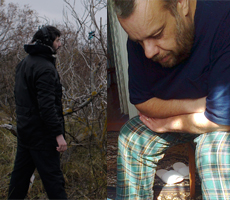
Left: Yiorgis. Right: Costis
The following is a conversation between electroacoustic music composers Costis Drygianakis and Yiorgis Sakellariou, both originating from Greece. Besides their compositional activities, Costis has been researching on and collecting folk music from Russia and other former Soviet republics while Yiorgis has done field work exploring music from Lithuania. His recordings are now part of the World and Traditional music archive of the British Library.
IN SEARCH OF MEANING: REFLECTIONS ON FOLKLORE
The conversation was triggered by a post on the British Library’s blog [1] in which Yiorgis describes his experiences of making recordings in Lithuania. Costis sent him an email with some thoughts which initiated the dialogue. They comment on the notion of tradition, the evolution of folk music and exchange thoughts on their experiences, comparing the current situation of Greek, Russian and Lithuanian music.
Costis Drygianakis:
[…] I would like to underline that the tradition, as we understand it today, was formulated to a great extent in the early 1900’s, mainly because of the development of the ethnographic research and the dissemination of the gramophone record. Up to then, it seems that unaccompanied singing was dominant in everyday life. In Russia, as well as in Greece. Instruments were used rather sparsely, in special cases like weddings or religious feasts. What is probably certain is that, as a part of everyday life activities, singing had none of the characteristics that were imposed on it by scholars and record-producers. For example there was no defined beginning, middle and ending in the songs, as there was no need for it. The lullaby was over when the baby was asleep, the working song when the work was finished. That is why there are similar melodies in different songs, or stand-alone lyrics etc. The concept of a musical “piece” (defined, complete and unique) was grown in Western art music and gradually enforced into folk music. The gramophone record, with its limited available time and its function within a commercial framework that caused the commodification of music, was a primary catalyst in this procedure. If older folk music was a continuum of melodies and lyrics, without defined borders (and defined owners too), then, after the spreading of the gramophone record it became a compendium of separate pieces. It is exactly this procedure that gave birth to the new concepts regarding “tradition”, these ones which became widespread in the post-war world. In Soviet Russia commerce was not as powerful as in the West, but the academic approach of the folklorists already had a decisive role, even from the last years before the 1917 Revolution. In many cases, the actual village music was transformed to a kind of spectacle, starting with researchers like Mitrofan Pyatnitsky. Today it is even more obvious if we consider that this repertoire is performed in “traditional”, old style folk costumes that are not used anywhere else anymore; it makes clear that the concert of this kind of music is something like a museum exhibition.
Yiorgis Sakellariou:
I have been rather troubled regarding the costumes. In a conversation I had with Austė Nakienė [2] she told me that naturally concerts and presentations at festivals have an artistic approach and mentality. She also added that we are essentially looking at a “postcard”, as she said characteristically, an idealized version (for whom, I wonder?). The ensembles are fully aware of that. It is not a matter of authenticity but presenting the work as beautiful and attractive as possible. Besides, the clothes were not so fancy 100 years ago, for example. They were much more simple and practical for work or other activities. Always according to Austė, exceptions were the Sunday mass, weddings and funerals.
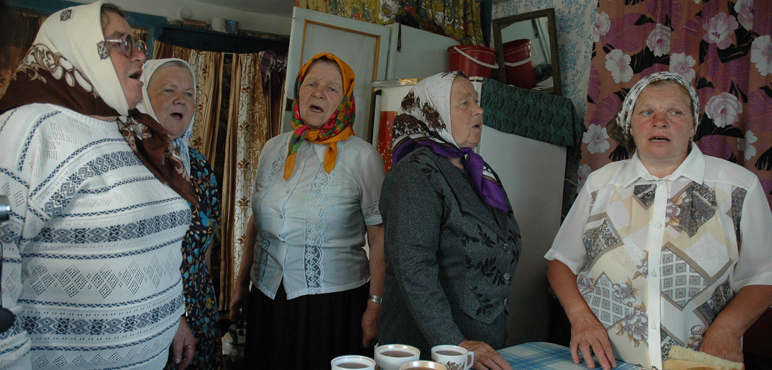 Russia: Sudarushki (“the Ladies”), the folk group of the village of Ilovka, rehearse at home. July 2005.
Russia: Sudarushki (“the Ladies”), the folk group of the village of Ilovka, rehearse at home. July 2005.
CD:
They say the same, more or less, in Russia. We are talking about a theatre-type approach that aims to present an idealized past. It is clear that this approach takes place in an urban, modern environment. Here, many of the teachers of the Academy [3] are aware of the changes of the framework but they are unwilling to take a different initiative. This theatrical approach is one of the typical Soviet remains that are still beyond question. I was really shocked in 2010 when I attended some exams of the students in the Academy where all of them performed in “traditional” costumes, although there was no audience besides their fellow students and their teachers.
This framework expands furthermore to the discography. The recording prerequisites in the studio are very specific, as I understood, but there you can see a gradual change of approach.
YS:
My question then would be “Why do we care?” If Russians, Lithuanians, etc. make this aesthetic choice why are we troubled so much? Especially since we do not have the ambition to defend tradition or good taste. Apparently over there they have resolved these issues so let’s just sit back and enjoy it.
CD:
I ’m not against any pleasure or enjoyment but I have two objections. Firstly, I disagree with this forging, or rather misinterpretation of history. Or, to put it milder, I disagree with the creation of public history intended for mass consumption; I find no fun in it. Besides the ideological disagreement, I feel that a lot of problems that we are dealing with in this specific field are caused exactly because of this attempt to invent or to shape traditions.
Secondly, regarding the Academia here in Russia, which I am a bit more familiar with, I don’t think they are enjoying themselves that much, neither themselves nor the people who listen to them. It is a form of compulsion. Of course when the aspect of pleasure is absent, music becomes pointless. Therefore, it is not strange that this repertoire does not have real listeners but only temporal ones (in national commemoration days etc), who attend it being obliged by the circumstances. That is why I am interested in how this music sounded when people still enjoyed it. Or, if we consider that it has not changed (though I am certain that it has), then what is it that has changed so that people do not enjoy it anymore although they used to (and who are these people, and so on). I do not know if in Lithuania the situation is different.
I would also add that this conservatism, as a motivating stimulus, is dangerous. It is not important to restore things as they used to be, but to understand what was then beautiful. If the old beautiful does not correspond with the contemporary one, we have to find out why.
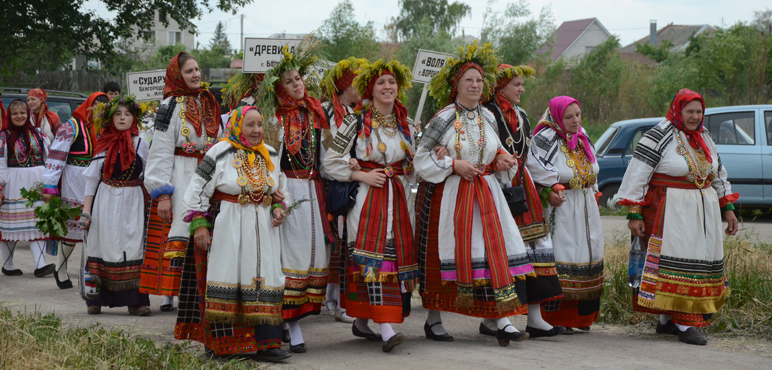 Russia: Volya, Sudarushki and other groups entering the ground of the annual festival of the Holy Trinity in Novaya Usman. June 2011.
Russia: Volya, Sudarushki and other groups entering the ground of the annual festival of the Holy Trinity in Novaya Usman. June 2011.
YS:
The original truth and purpose of these songs is gone, along with the conditions that gave birth to them. The practical purposes do not exist anymore (work in fields, lullaby etc.) and by default we listen to them out of context. Regardless of the differences in interpretation or orchestration, the changes are much deeper and are dealing with the meaning of both the song and its need to be sung.
I interviewed two young people who are members of the neo-folk/pagan ensemble Kūlgrinda. Out of curiosity I simply asked them why are they doing this; what motivates two youngsters to wear clothes that belong to another era and sing what they consider to be ancient pagan songs? The response from both was that it happened naturally and unforcedly. An initial curiosity was soon transformed into a passion.
However, as I wrote at the British Library blog, despite all the filters this music still has an impact because its original meaning, its reason to exist, was powerful and authentic. Perhaps a lot of people cannot relate or communicate with it but for sure they can understand, or feel, there is a strong meaning behind.
And I should emphasize again how many filters intercede. Changes in social conditions, new ideas and experiences from contemporary practitioners, our cultural distance, the recordings as such. I do not know if, after all, it is I who idealize my experiences. In any case, I share your questioning.
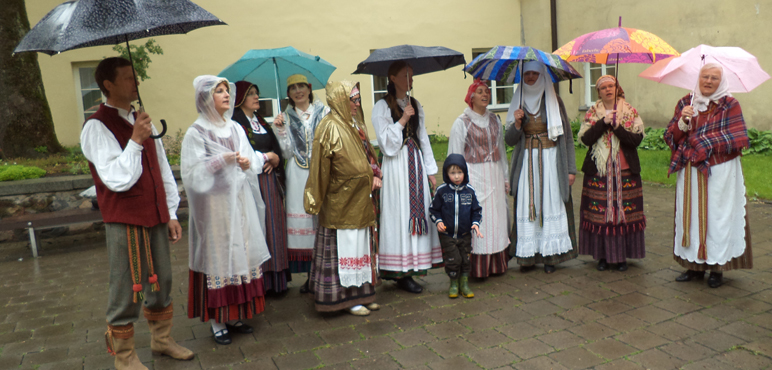 Lithuania: Gadula folk ensemble performing during the event Prašom, svečiai, kieminėt (Please, be my guest) at Vilnius old town. Skamba Skamba Kankliai festival. June 1, 2014.
Lithuania: Gadula folk ensemble performing during the event Prašom, svečiai, kieminėt (Please, be my guest) at Vilnius old town. Skamba Skamba Kankliai festival. June 1, 2014.
CD:
You put it correctly. The changes are massive and the new meanings and truths are totally different from the original ones. Even in the course of some years, meanings change.
Neo-pagan ensembles are, I think, another case. There is passion and devotion and somehow it is clear (though I doubt if it always is) that they do not correspond to any historic truth. It is an imagined community, as Anderson puts it [4].
YS:
In many ensembles which participated at Skamba Skamba Kankliai the members are people of old age, especially when the ensembles are not from Vilnius. There was a characteristic concert where Ringailiai, an ensemble from a village near Kaunas performed. In Ringailiai only old people participated and they were joined by members of Tatato, the ensemble of the Ethnomusicology Department of Lithuanian Academy of Music and Theatre, in which almost every member was a female student. I asked if the old people’s motivation is to preserve their traditions. The answer surprised me a bit. Apparently, many things happen for practical and not aesthetic or ideological reasons. Well, these grandmothers and grandfathers participate in the ensembles basically to have a good time. They meet, they socialize, they sing and occasionally they travel to perform in festivals. There are no ideological purposes of preserving tradition or originality.
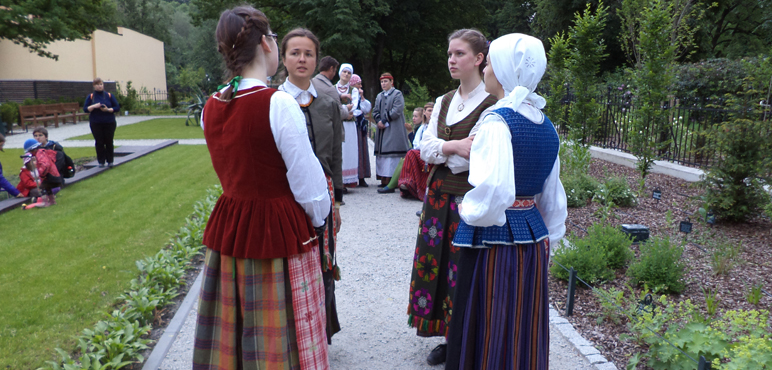 Lithuania: Tatato, the ensemble of the Ethnomusicology Department of Lithuanian Academy of Music of Theatre performing during the event Sutartinių takas (Alley of sutartines) at Bernardinų sode, Vilnius. Skamba Skamba Kankliai festival. May 30, 2014.
Lithuania: Tatato, the ensemble of the Ethnomusicology Department of Lithuanian Academy of Music of Theatre performing during the event Sutartinių takas (Alley of sutartines) at Bernardinų sode, Vilnius. Skamba Skamba Kankliai festival. May 30, 2014.
CD:
Exactly. They don’t give a damn about tradition. Already the previous generation was educated, went to school, and used to listen to records of the then popular music. Tradition, as opposed to modernity (and therefore set under protection), is an idea that sprung out of the modern urban world. In the villages they have a somehow bitter feeling for the “tradition”, as the difficulties of the old way of life are not yet completely gone.
YS:
When I asked a couple of students if they are interested in an interview I got shyness in response and the occasional distant attitude of Lithuanians. So, I can only guess their motivations. I suppose they do it mechanically, as part of their studies perhaps. Maybe the younger generation feels an obligation to preserve something from the past.
CD:
Yes, I noticed the same thing here, despite the enthusiastic and warm attitude of Russians. I do not think they are very conscious of what they are doing and I am not at all certain that it is their choice to mingle with the “tradition”. Besides, they witness this haggard revival first hand. I don’t know how it is in Lithuania but in Russia it can be even cruel, sometimes.
By the way, Russians make fun of themselves on such topics. There was a very successful song about it in Russia, right after the collapse of the Soviet Union, called American boy; describing the struggle of a Russian teen who plays the balalaika and dreams to go to Jamaica, but there are no babalaikas there, so her knowledge is useless in her struggle to migrate. [5]
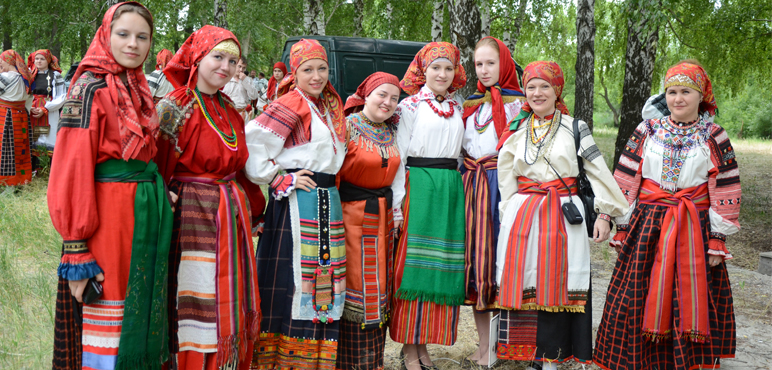 Russia: Terem (“the Room under the roof”), a group of amateurs, all graduates of the Voronezh State University, under the direction of Galina Khristova (second from right), a little after performing at the annual festival of the Holy Trinity in Novaya Usman. June 2011.
Russia: Terem (“the Room under the roof”), a group of amateurs, all graduates of the Voronezh State University, under the direction of Galina Khristova (second from right), a little after performing at the annual festival of the Holy Trinity in Novaya Usman. June 2011.
YS:
Nonetheless, Austė was rather positive for ensembles that add new elements. She called them post-modern. I have listened some, for example Atalyja [6], who combine rock orchestrations with traditional melodies and moreover it is very important that they add new lyrics on old melodies.
CD:
I agree with her. This is not sterile attachment to the supposed tradition but a new contextualization and thus, I think, a generally healthy procedure. There have been such approaches here too (I think the group Ivan Kupala [7] is one of the most striking examples) but they met the harsh critics of the academic system.
Here I would note that both you and I approached the so-called traditional music with our love for the Other as a basic motivation. I think it is a crucial point which radically differentiates our approach from the approach of the academies. Consider our homeland, Greece; the old traditions were not part of our everyday life when we grew up. The same goes for our life in the countries we later migrated to. In Greece there were records with traditional music, we had some in our house, but this wasn’t in a village. It was in an urban environment, where the “natural” everyday music would be pop or rock and so on. Our searches (in both the so-called contemporary and traditional music) are triggered by our interest of what lies beyond our mundane life, this Other. For the people who live in a village, the relation to what we call tradition is totally different (ranging probably from an unbearable burden to a source of income through tourism).
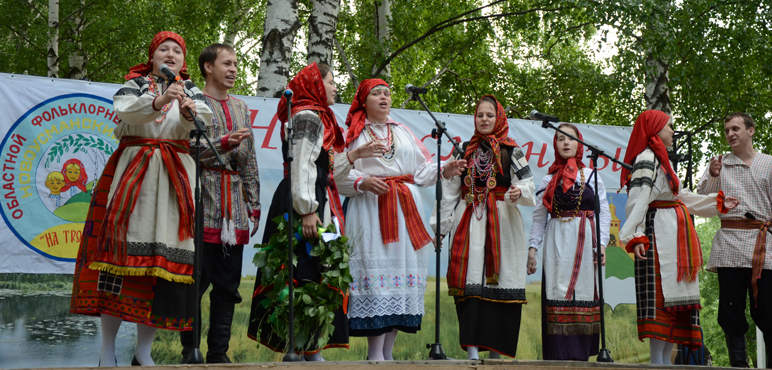 Russia: Volya (“Will, Freedom”), the student group of the Department for Folk Music of the Voronezh State University, under the direction of Galyna Sysoeva (not depicted here) performs at the annual festival of the Holy Trinity in Novaya Usman. June 2011.
Russia: Volya (“Will, Freedom”), the student group of the Department for Folk Music of the Voronezh State University, under the direction of Galyna Sysoeva (not depicted here) performs at the annual festival of the Holy Trinity in Novaya Usman. June 2011.
YS:
I have additionally the experience of studying traditional Mediterranean music at the conservatory. Of course I had a curiosity for the Other, the more unworldly. That is how the Arabic, or Byzantine if you prefer, scales, the unusual time signatures and the drones were sounding to my ears back then.
My teacher, Nikos Grapsas, lend me a CD with music from Istanbul. On the cover there was a photo of the musicians, one of them was holding a cello. I was surprised as the cello is a Western instrument and I asked him how it got there. “They played anything they could get their hands on”, he replied. “Probably a relative went on a journey and came back with a new instrument. They had absolutely no reason not to use it at once.”
And there is another, perhaps irrelevant story that Austė told me and which I find interesting. The accordion is rather connected to Lithuanian music tradition, especially polka dances. However, around 100 years ago the elders were extremely suspicious of it, in contrary with young musicians. For the elders the “proper” instrument was the bagpipe and the accordion was a stupid box that you just press buttons and music comes out. (Reminds me of the criticism against computer music). The young musicians however liked the loud and clear sound and the fact that the accordion would not get out of tune.
CD:
Your story is not irrelevant, it showcases the dynamic of things. In older days music of this type was open to new elements, basically by obeying practical needs. The obsession with the old (“because this is how things were”) is modern, it is the extreme notion with which the supposed “traditional” musicians clash. Of course this changes from place to place, era to era etc. In previous times, and in most places, the musician (the singer, the lyricist, the painter, every creative person) was part of the intellectual elite, now the “traditional musician” is a kind of remains.
Such questioning has not a lot of appeal in Russia. On the contrary, the idea of reflexivity which became crucial in Western anthropology the last decades, it is rarely touched: “This is how we found it, this is the way we will keep on doing it, until the end of time”. It doesn’t matter so much if they found it already constructed by some previous folklorists. Modern elements that are spring up in the process of research (e.g. structuring songs for recording or concert purpose) are hushed up, consciously or unconsciously, gradually creating a thick layer of “common sense” from which the community of the researchers cannot easily escape from. Questions regarding the methods of ethnography, the identity of the researcher etc, here in Russia are extremely limited and are dealing only with obvious issues, as for example with the injection of pro-state lyrics in the Soviet years. Maybe this is because ethnography in Russia developed as a part of national study and not as a study of foreign cultures, as was the case in the West.
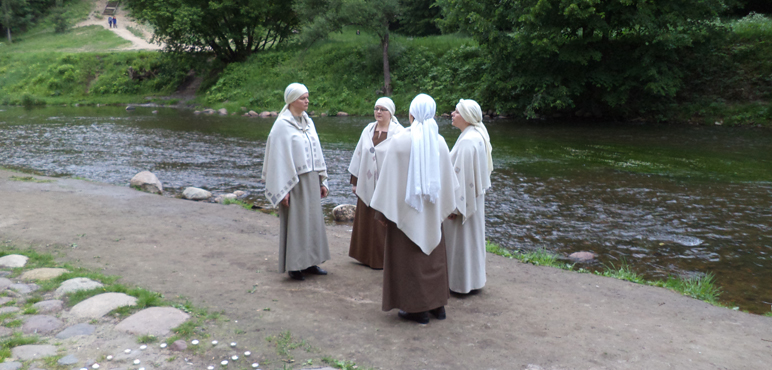 Lithuania: Trys Keturiose performing, under the direction of Daiva Vyčinienė (first on the left), during the event Sutartinių takas (Alley of sutartines) at Bernardinų sode, Vilnius. Skamba Skamba Kankliai festival. May 30, 2014.
Lithuania: Trys Keturiose performing, under the direction of Daiva Vyčinienė (first on the left), during the event Sutartinių takas (Alley of sutartines) at Bernardinų sode, Vilnius. Skamba Skamba Kankliai festival. May 30, 2014.
YS:
I’d like to express my concern as an ethnographer. By adding my recordings to the British Library archives I have contributed, even a little bit, to the documentation and archiving of Lithuanian music.
What worries me is how inevitably limited my collection is. At least I am consciously aware of that. While I was living in Lithuania I never collected material methodically but more instinctively and based on my taste. No doubt this influenced my recordings and the decisions I made during the Skamba Skamba Kankliai festival. I already knew some participating ensembles, some I did not, some styles I liked (sutartines), some not (polkas). There is also the fact that I collaborated with only one ethnomusicologist. She obviously has very broad knowledge of the subject but she remains only one source of information and undoubtedly she has her own personal taste and opinion. And, of course, Skamba Skamba Kankliai’s program, no matter how diverse, was still fragmented.
Therefore, the fact that this collection is part of the archives of the British Library makes it perhaps overvalued. Maybe I am exaggerating now but I think there is an issue of “authority” as the prestige and status of institutes with reputation, power and resources affect the work to a great degree.
CD:
You are right. I have also thought about this from time to time, although I’ve never had a powerful institute to back me up. Moreover, I completely agree with the observation that the world of music (of Lithuania, of Greece, of Russia or anywhere else) includes the work of everyone involved (village singers, ethnographers, entertainers, pop stars etc.) but no one is above it. No one has the complete knowledge in his head.
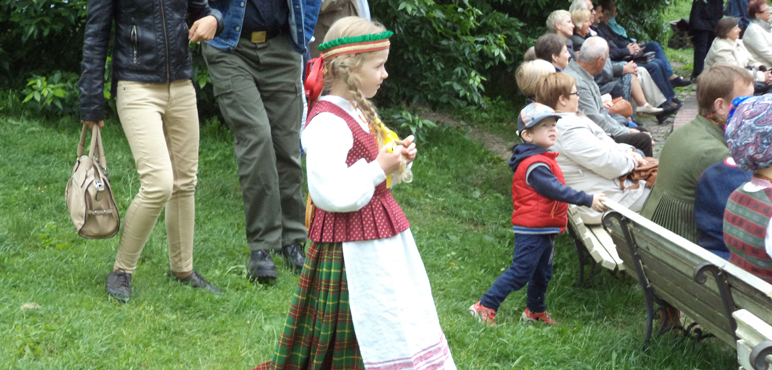 Lithuania: A young participant at Skamba Skamba Kankliai, waiting for her turn to go on stage at Teatro, muzikos ir kino muziejaus kieme (the courtyard of the Lithuanian Theater, Music and Cinema Museum), Vilnius. May 29, 2014.
Lithuania: A young participant at Skamba Skamba Kankliai, waiting for her turn to go on stage at Teatro, muzikos ir kino muziejaus kieme (the courtyard of the Lithuanian Theater, Music and Cinema Museum), Vilnius. May 29, 2014.
Notes
1. In the post Sakellariou talks about Skamba Skamba Kankliai, a festival of traditional music that takes place in Lithuania.
http://britishlibrary.typepad.co.uk/sound-and-vision/2014/07/recordings-from-the-skamba-skamba-kankliai-music-festival-lithuania.html
2. Austė Nakienė is an ethnomusicologist working in the Lithuanian Institute of Folklore and Literature (http://www.llti.lt/en/about/). She provided valuable assistance to Yiorgis Sakellariou during the Skamba Skamba Kankliai 2014 recording project.
3. The Academy is the State Academy of the Arts in Voronezh, where there is a faculty of Folk Music, directed by Galina Sysoeva.
4. Anderson Benedict, 2006: Imagined communities: Reflections on the Origin and Spread of Nationalism, Revised Edition. London: Verso
5. American boy by the group Kombinatsiya:
https://www.youtube.com/watch?v=W7hAo28NCXc
6. Atalyja can be heard here:
https://www.youtube.com/watch?v=lbJ4HX90S6U
7. Ivan Kupala can be heard here:
http://www.youtube.com/watch?v=zhNSpilaw0E
Links
● British Library sound archive
http://sounds.bl.uk/
● Skamba Skamba Kankliai festival
http://www.etno.lt/index.php/lt/skamba-skamba-kankliai
● Volya, the folk group of the Voronezh State Arts Academy
http://www.youtube.com/watch?v=Wu9rtV2YomQ
● Costis Drygianakis
http://soundcloud.com/costisdrygianakis
● Yiorgis Sakellariou
http://mechaorga.wordpress.com/

